| ◄ OCTOBER ► | ||||||
|---|---|---|---|---|---|---|
| ◄ 1950 ► | ||||||
| 1 | 2 | 3 | 4 | 5 | 6 | 7 |
| 8 | 9 | 10 | 11 | 12 | 13 | 14 |
| 15 | 16 | 17 | 18 | 19 | 20 | 21 |
| 22 | 23 | 24 | 25 | 26 | 27 | 28 |
| 29 | 30 | 31 | ||||
| President: | Harry S Truman (D) | |||
| Vice-President: | Alben W. Barkley (D) | |||
| House: | 260 (D) | 166 (R) | 2 (Other) | 7 (Vacant) |
| Southern states: | 101 (D) | 2 (R) | 2 (Vacant) | |
| Senate: | 54 (D) | 42 (R) | ||
| Southern states: | 22 (D) | |||
| GDP growth: | 10.6% | (Annual) | ||
| 1.4% | (Quarterly) | |||
| Inflation: | 3.8% | |||
| Unemployment: | 4.2% | |||
| US killed in action, | 502 | (This month) | ||
| Korean conflict: | 8,684 | (Since Jun 28, 1950) | ||
Note: Romanization of names for Asian people and places have changed since 1950. Asian names on this page are given as reported in original news reports. In Korea, official U.S. communiques and the American press typically used Japanese-based romanization schemes for Korean cities, rivers and other landmarks. This practice stems from using outdated maps which reflected Japan’s occupation of Korea before and during World War II. In China, a number of inconsistent romanization systems were used. China adopted the Hanyu Pinyin romanization standard in 1982. South Korea adopted its Revised Romanization of Korean standard in 2000. Contemporary romanization renderings are given in parentheses in the text wherever they differ from original reports.
▲Sunday, October 1
![]()
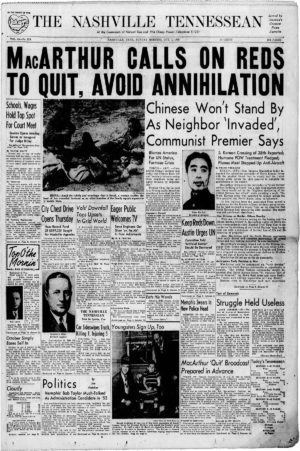 Oct 1: MacArthur calls on North Koreans to surrender. U.N. Commander Gen. Douglas MacArthur calls on the North Koreans to lay down their arms and surrender immediately. The ultimatum is issued at noon, Toyko time, and delivered in hourly broadcast via powerful radio transmitters in Tokyo. MacArthur warns that “The early and total defeat and complete destruction of your armed forces and war making potential is now inevitable. … I, as the United Nations Commander in Chief, call upon you and the forces under your command, in whatever part of Korea situated, forthwith to lay down your arms and cease hostilities under such military supervisions as I may direct, and I call upon you at once to liberate all United Nations prisoners of war and civilian detainees under your control and to make adequate provision for their protection, care, maintenance and immediate transportation to such places as I indicate. North Korean forces, including prisoners of war in the hands of the United Nations command, will continue to be given the care dictated by civilized custom and practice and permitted to return to their homes as soon as practicable. I shall anticipate your early decision upon this opportunity to avoid the further useless shedding of blood and destruction of property.”
Oct 1: MacArthur calls on North Koreans to surrender. U.N. Commander Gen. Douglas MacArthur calls on the North Koreans to lay down their arms and surrender immediately. The ultimatum is issued at noon, Toyko time, and delivered in hourly broadcast via powerful radio transmitters in Tokyo. MacArthur warns that “The early and total defeat and complete destruction of your armed forces and war making potential is now inevitable. … I, as the United Nations Commander in Chief, call upon you and the forces under your command, in whatever part of Korea situated, forthwith to lay down your arms and cease hostilities under such military supervisions as I may direct, and I call upon you at once to liberate all United Nations prisoners of war and civilian detainees under your control and to make adequate provision for their protection, care, maintenance and immediate transportation to such places as I indicate. North Korean forces, including prisoners of war in the hands of the United Nations command, will continue to be given the care dictated by civilized custom and practice and permitted to return to their homes as soon as practicable. I shall anticipate your early decision upon this opportunity to avoid the further useless shedding of blood and destruction of property.”
![]()
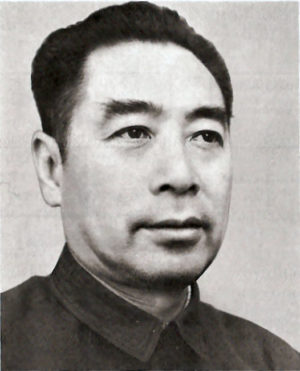 Oct 1: Chinese Premier says his country won’t stand by if North Korea is invaded. Chou En-lai (Zhou Enlai), Premier of the People’s Republic of China, warns that his country “will not stand aside” if North Korea is invaded. Speaking on the first anniversary of the proclamation of the People’s Republic, Chou warns that China will not “supinely tolerate seeing their neighbors being savagely invaded by imperialists. … (The Chinese people) will not be afraid to fight aggression in defense of peace. They will not tolerate foreign aggression and will not stand aside should the imperialists wantonly invade the territory of their neighbor.”Diplomats in Washington minimize China’s threat. They acknowledge that China is supplying material to North Korea, but they insist that China will not commit its own troops to defend North Korea.
Oct 1: Chinese Premier says his country won’t stand by if North Korea is invaded. Chou En-lai (Zhou Enlai), Premier of the People’s Republic of China, warns that his country “will not stand aside” if North Korea is invaded. Speaking on the first anniversary of the proclamation of the People’s Republic, Chou warns that China will not “supinely tolerate seeing their neighbors being savagely invaded by imperialists. … (The Chinese people) will not be afraid to fight aggression in defense of peace. They will not tolerate foreign aggression and will not stand aside should the imperialists wantonly invade the territory of their neighbor.”Diplomats in Washington minimize China’s threat. They acknowledge that China is supplying material to North Korea, but they insist that China will not commit its own troops to defend North Korea.
![]() Oct 1: Chinese Premier pledges to occupy Taiwan and Tibet. Chinese Premier Chou En-lai also reiterates today his pledge to occupy Taiwan and Tibet. He asserts that China’s occupation of Tibet “is essential for the security of our native land and we shall endeavor to carry it out through peaceful negotiations. Patriotic elements in Tibet welcome this and we hope that the local Tibetan authorities will not delay any longer in order that the question will be settled peacefully.” But he warns that the People’s Red Army is “fully determined” to conquer Tibet militarily if negotiations do not conclude to China’s satisfaction.
Oct 1: Chinese Premier pledges to occupy Taiwan and Tibet. Chinese Premier Chou En-lai also reiterates today his pledge to occupy Taiwan and Tibet. He asserts that China’s occupation of Tibet “is essential for the security of our native land and we shall endeavor to carry it out through peaceful negotiations. Patriotic elements in Tibet welcome this and we hope that the local Tibetan authorities will not delay any longer in order that the question will be settled peacefully.” But he warns that the People’s Red Army is “fully determined” to conquer Tibet militarily if negotiations do not conclude to China’s satisfaction.
![]()
 Oct 1: Korean War: South Korean forces cross the 38th Parallel. As Gen. Douglas MacArthur’s surrender ultimatum is being broadcast, Republic of Korea (ROK) 3rd Division follows South Korean President Syngman Rhee’s order to cross the 38th parallel. They fight against heavy enemy resistance from fixed positions to advance toward Yangyang, eight miles (13 km) north of the parallel. The South Korean National Assembly, still meeting in makeshift quarters in Pusan (Busan) had adopted a resolution the night before urging U.N. forces in Korea to push across and into North Korea.
Oct 1: Korean War: South Korean forces cross the 38th Parallel. As Gen. Douglas MacArthur’s surrender ultimatum is being broadcast, Republic of Korea (ROK) 3rd Division follows South Korean President Syngman Rhee’s order to cross the 38th parallel. They fight against heavy enemy resistance from fixed positions to advance toward Yangyang, eight miles (13 km) north of the parallel. The South Korean National Assembly, still meeting in makeshift quarters in Pusan (Busan) had adopted a resolution the night before urging U.N. forces in Korea to push across and into North Korea.
![]() Oct 1: Korean War: Marines move north and northwest from Seoul. With Seoul now firmly in South Korean hands, the U.S. Marines continue mopping up north of the city. The 1st Marine Division advances up the principal national highway to as far as Munsan-ni, encountering only light and scattered enemy fire along the way. The 7th Marines advance up the road to Uijongbu (Uijeongbu), against almost no enemy resistance, slowed only by mines. Enemy resistance stiffens markedly at Nuwon-ni (Howon-dong), where high mountains on either side of the road create a natural fortress. Further south on the peninsula, there are still three pockets of enemy resistance. The North’s Korean People’s Army (KPA) in the mountains west of Chechon is still battling ROK forces while looking for an escape route northward. Their way is blocked now that the ROK has taken Wonju. West of Chochiwon (Jochiwon-eup), remnants of enemy forces are bottled up in a desperate attempt to find a way north. And northwest of Chinju (Jinju), KPA renmants are hiding out in the inaccessible Chiri-san (Jiri-san) mountain stronghold, from where they will continue to launch guerrilla operations throughout the southern coast region.
Oct 1: Korean War: Marines move north and northwest from Seoul. With Seoul now firmly in South Korean hands, the U.S. Marines continue mopping up north of the city. The 1st Marine Division advances up the principal national highway to as far as Munsan-ni, encountering only light and scattered enemy fire along the way. The 7th Marines advance up the road to Uijongbu (Uijeongbu), against almost no enemy resistance, slowed only by mines. Enemy resistance stiffens markedly at Nuwon-ni (Howon-dong), where high mountains on either side of the road create a natural fortress. Further south on the peninsula, there are still three pockets of enemy resistance. The North’s Korean People’s Army (KPA) in the mountains west of Chechon is still battling ROK forces while looking for an escape route northward. Their way is blocked now that the ROK has taken Wonju. West of Chochiwon (Jochiwon-eup), remnants of enemy forces are bottled up in a desperate attempt to find a way north. And northwest of Chinju (Jinju), KPA renmants are hiding out in the inaccessible Chiri-san (Jiri-san) mountain stronghold, from where they will continue to launch guerrilla operations throughout the southern coast region.
![]()
 Oct 1: Vietnam, Battle of RC4: French garrison in Cao Bang ordered to evacuate. Route Coloniale 4, in the far northeastern region of French Indochina, connects a string of French fortifications from Cao Bang to Lang Son. The border between French Indochina and Communust China has never been fully demarcated on the ground, making these fortifications a de-facto border and a check on the Viet Minh which has infiltrated the regions. To call RC4 a road is a bit of an exaggeration. It is little more than well-worn, unpaved oxcart path, a single lane rarely more than 12 feet (4 m) wide that threads its way through steep mountains and dense forests. Motorized vehicles rarely average more than 8 mph (13 kmh) along the 77-mile (125 km) distance from Cao Bang to the French regional headquarters at Lang Son. The French Foreign Legion manning the forts along RC4 have saying: “Route Coloniale No. 4 is a road a man travels only once alive.” The ability of French forces to maneuver in the region is also hampered by the road’s very close proximity to China. France is careful not to antagonize the Chinese Communists directly, but the road at one point passes to within just 230 feet (70 m) of Chinese territory. The Viet Minh’s capture of Dong Khe last month now threatens the entire RC4 frontier. Gen. Marcel Carpentier, commander in chief of French Indochina, orders the Foreign Legion’s 3rd Infantry (3e REI) to evacuate from Cao Bang southward on RC4 to Dong Khe. They are to destroy their heavy equipment and vehicles and leave them behind. The plan also calls for the Foreign Legion’s First Paratrooper Battalion (1er BEP) to lead Groupement Bayard, a combined force of 3,500 men, northward along RC4 from That Khe to retake Dong Khe, and hold it long enough until the 3e REI arrives from Cao Bang. Yesterday, the 1er BEP at That Khe tried to set out for Dong Khe, but were forced back by stronger Viet Minh artillery. Today at Cao Bang, the 3e REI commander disobeys orders and takes his heavy equipment with him as he leaves Cao Bang with 2,600 troops. He also brings along 500 pro-French civilian refugees. He will quickly return to Cao Bang due to the failure of the 1er BEP to retake Dong Khe. The 1er BEP will set out again for Dong Khe the next day. But this time, they will swing to the west to avoid the Viet Minh gathered along RC4. That highway will provide the name for the next two and a half weeks of bitter fighting in the Battle of Route Coloniale 4.
Oct 1: Vietnam, Battle of RC4: French garrison in Cao Bang ordered to evacuate. Route Coloniale 4, in the far northeastern region of French Indochina, connects a string of French fortifications from Cao Bang to Lang Son. The border between French Indochina and Communust China has never been fully demarcated on the ground, making these fortifications a de-facto border and a check on the Viet Minh which has infiltrated the regions. To call RC4 a road is a bit of an exaggeration. It is little more than well-worn, unpaved oxcart path, a single lane rarely more than 12 feet (4 m) wide that threads its way through steep mountains and dense forests. Motorized vehicles rarely average more than 8 mph (13 kmh) along the 77-mile (125 km) distance from Cao Bang to the French regional headquarters at Lang Son. The French Foreign Legion manning the forts along RC4 have saying: “Route Coloniale No. 4 is a road a man travels only once alive.” The ability of French forces to maneuver in the region is also hampered by the road’s very close proximity to China. France is careful not to antagonize the Chinese Communists directly, but the road at one point passes to within just 230 feet (70 m) of Chinese territory. The Viet Minh’s capture of Dong Khe last month now threatens the entire RC4 frontier. Gen. Marcel Carpentier, commander in chief of French Indochina, orders the Foreign Legion’s 3rd Infantry (3e REI) to evacuate from Cao Bang southward on RC4 to Dong Khe. They are to destroy their heavy equipment and vehicles and leave them behind. The plan also calls for the Foreign Legion’s First Paratrooper Battalion (1er BEP) to lead Groupement Bayard, a combined force of 3,500 men, northward along RC4 from That Khe to retake Dong Khe, and hold it long enough until the 3e REI arrives from Cao Bang. Yesterday, the 1er BEP at That Khe tried to set out for Dong Khe, but were forced back by stronger Viet Minh artillery. Today at Cao Bang, the 3e REI commander disobeys orders and takes his heavy equipment with him as he leaves Cao Bang with 2,600 troops. He also brings along 500 pro-French civilian refugees. He will quickly return to Cao Bang due to the failure of the 1er BEP to retake Dong Khe. The 1er BEP will set out again for Dong Khe the next day. But this time, they will swing to the west to avoid the Viet Minh gathered along RC4. That highway will provide the name for the next two and a half weeks of bitter fighting in the Battle of Route Coloniale 4.
![]()
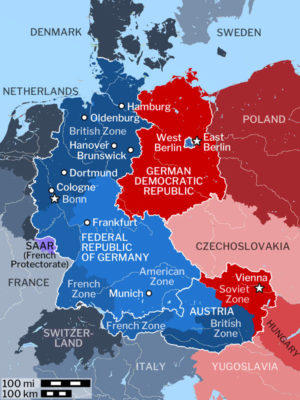 Oct 1: West German police break up Communist “Resistance Day.” A planned “National Resistance Day” by Communists in West Germany is broken up when 100,000 police are mobilized to nip the planned action in the bud. The Communists had reportedly planned to turn the day into a wave of demonstrations and riots. Officials say that thousands of young fanatics have crossed the borders from East Germany. About 500 ringleaders were arrested as a precaution on Saturday. The biggest fight of the day today takes place in Hamburg, where 16 policemen are injured while quelling a riot by some 3,000 stone-throwing Communists. In Munich, 300 agitators briefly interrupt the city’s Oktoberfest, but they are quickly dispersed and the crowds go back to drinking their beer. Smaller demonstrations are broken up in Hanover, Cologne, Frankfurt, Brunswick, Oldenburg and Dortmund. Overall, about a thousand would-be demonstrators are arrested as most of the planned actions quickly fizzle.
Oct 1: West German police break up Communist “Resistance Day.” A planned “National Resistance Day” by Communists in West Germany is broken up when 100,000 police are mobilized to nip the planned action in the bud. The Communists had reportedly planned to turn the day into a wave of demonstrations and riots. Officials say that thousands of young fanatics have crossed the borders from East Germany. About 500 ringleaders were arrested as a precaution on Saturday. The biggest fight of the day today takes place in Hamburg, where 16 policemen are injured while quelling a riot by some 3,000 stone-throwing Communists. In Munich, 300 agitators briefly interrupt the city’s Oktoberfest, but they are quickly dispersed and the crowds go back to drinking their beer. Smaller demonstrations are broken up in Hanover, Cologne, Frankfurt, Brunswick, Oldenburg and Dortmund. Overall, about a thousand would-be demonstrators are arrested as most of the planned actions quickly fizzle.
▲Monday, October 2
Last Day of Sukkot
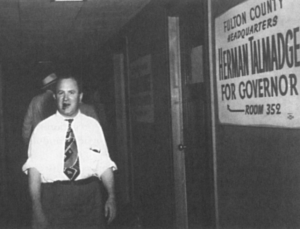 Oct 2: Georgia power broker says state may abandon funding for Negro schools. Georgia’s former House Speaker Roy Harris warns that if Atlanta’s African-American parents insist on suing the city’s school district to end segregation, the state may abandon a funding program for Negro schools, and perhaps the entire public school system itself. Harris may no longer be in the Statehouse, but as Gov. Herman Talmadge’s campaign manager, closest adviser, and all around kingmaker in Georgia politics — the saying goes that you need fifty thousand dollars and Roy Harris to become Governor — people pay attention to what he writes in his weekly Augusta Courier. Harris has been championing the Minimum Foundation Program, a state fund which is set to spend $40 million (about $420 million today) on poor school districts. A large part of that money is set aside to “equalize” Negro schools under the “separate but equal” policy. With last June’s U.S. Supreme Court decision demanding that separate but equal facilities be equal, the inequality between segregated schools has become an urgent issue for Southern segregationists. Harris says that further lawsuits to end segregation puts all of that in jeopardy. “Why should the white people of Georgia pay exorbitant millions every year in taxes for the sole purpose of destroying the white race in Georgia?” he asks. “That’s what the financing of the minimum foundation program would mean to Georgia if we are to have the mixing and the mingling of the races in the public school system in this state. The Negroes pay less than 3% of the cost of public schools. The white people pay more than 97%. If the public school system is to mean destruction of the pattern of segregation, then we ought to do away with the public school system and devise another to take its place.” He suggests creating a system of private schools for white children, which he says would be out of the reach of Federal courts, and would leave black families with the burden of having to set up their own expensive private schools if they want their children educated.
Oct 2: Georgia power broker says state may abandon funding for Negro schools. Georgia’s former House Speaker Roy Harris warns that if Atlanta’s African-American parents insist on suing the city’s school district to end segregation, the state may abandon a funding program for Negro schools, and perhaps the entire public school system itself. Harris may no longer be in the Statehouse, but as Gov. Herman Talmadge’s campaign manager, closest adviser, and all around kingmaker in Georgia politics — the saying goes that you need fifty thousand dollars and Roy Harris to become Governor — people pay attention to what he writes in his weekly Augusta Courier. Harris has been championing the Minimum Foundation Program, a state fund which is set to spend $40 million (about $420 million today) on poor school districts. A large part of that money is set aside to “equalize” Negro schools under the “separate but equal” policy. With last June’s U.S. Supreme Court decision demanding that separate but equal facilities be equal, the inequality between segregated schools has become an urgent issue for Southern segregationists. Harris says that further lawsuits to end segregation puts all of that in jeopardy. “Why should the white people of Georgia pay exorbitant millions every year in taxes for the sole purpose of destroying the white race in Georgia?” he asks. “That’s what the financing of the minimum foundation program would mean to Georgia if we are to have the mixing and the mingling of the races in the public school system in this state. The Negroes pay less than 3% of the cost of public schools. The white people pay more than 97%. If the public school system is to mean destruction of the pattern of segregation, then we ought to do away with the public school system and devise another to take its place.” He suggests creating a system of private schools for white children, which he says would be out of the reach of Federal courts, and would leave black families with the burden of having to set up their own expensive private schools if they want their children educated.![]()
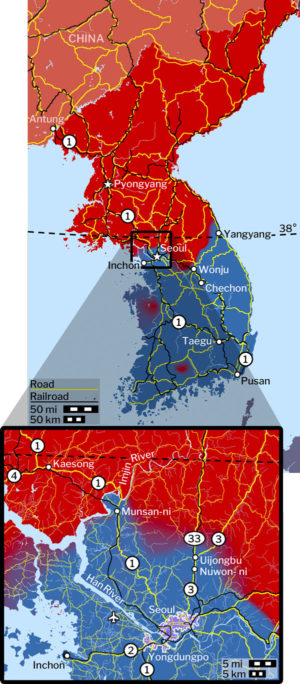 Oct 2: Korean War: ROK races north across the Parallel. The Republic of Korea’s (ROK) 3rd Division establishes their command post at Yangyang, eight miles (13 km) north of the Parallel, while the rest of the division races forward. For the next several days, they will average about fifteen miles (24 km) a day.
Oct 2: Korean War: ROK races north across the Parallel. The Republic of Korea’s (ROK) 3rd Division establishes their command post at Yangyang, eight miles (13 km) north of the Parallel, while the rest of the division races forward. For the next several days, they will average about fifteen miles (24 km) a day.
![]() Oct 2: Korean War: North Koreans sack Wonju. At Wonju shortly after midnight, an organized KPA force of from a thousand to two thousand soldiers, which the ROK had bypassed in the mountains to the south, strikes with full force in an attempt to escape to the north. The North Koreans overrun ROK II Corps headquarters in Wonju, killing many of its officers. The North Koreans go on a killing spree in Wonju, killing an estimated 1,000 to 2,000 civilians before leaving by nightfall.
Oct 2: Korean War: North Koreans sack Wonju. At Wonju shortly after midnight, an organized KPA force of from a thousand to two thousand soldiers, which the ROK had bypassed in the mountains to the south, strikes with full force in an attempt to escape to the north. The North Koreans overrun ROK II Corps headquarters in Wonju, killing many of its officers. The North Koreans go on a killing spree in Wonju, killing an estimated 1,000 to 2,000 civilians before leaving by nightfall.
![]() Oct 2: Korean War: U.S. forces face stiff fighting north of Seoul. North of Seoul, stiff fighting continues throughout the day at Nuwon-ni, where the KPA has dug in on the mountains on either side of the highway. The enemy withdraws overnight and American forces the next day will move north to take Uijongbu (Uijeongbu), which has been leveled by Marine Corsair bombing. But to the west, US and ROK forces halt at the destroyed bridges on the Imjin River north and west of Munsan-ni. Their progress impaired by severe bottlenecks in the supply lines. South Korea’s main railroad line from the port of Pusan (Busan) to Seoul is largely destroyed north and west of Taegu (Daegu), and capacity at the port of Inchon (Incheon) remains severely constrained because it is only usable during a few hours each day at high tide.
Oct 2: Korean War: U.S. forces face stiff fighting north of Seoul. North of Seoul, stiff fighting continues throughout the day at Nuwon-ni, where the KPA has dug in on the mountains on either side of the highway. The enemy withdraws overnight and American forces the next day will move north to take Uijongbu (Uijeongbu), which has been leveled by Marine Corsair bombing. But to the west, US and ROK forces halt at the destroyed bridges on the Imjin River north and west of Munsan-ni. Their progress impaired by severe bottlenecks in the supply lines. South Korea’s main railroad line from the port of Pusan (Busan) to Seoul is largely destroyed north and west of Taegu (Daegu), and capacity at the port of Inchon (Incheon) remains severely constrained because it is only usable during a few hours each day at high tide.
![]()
 Oct 2: Soviet Union proposes Korean cease fire at U.N. The United Nations Security Council, meeting in temporary quarters at Lake Success, New York, hears a Soviet Union proposal for a cease-fire, the withdrawal of foreign troops, and national elections for an all-Korea government. U.S. and British delegates immediately oppose the offer, saying it runs counter to an eight-point U.N. resolution. They also point out that withdrawing foreign troops still leaves the Chinese and Soviets on the border. And besides that, there’s the Soviets’ broken promise of free elections” in Eastern Europe.
Oct 2: Soviet Union proposes Korean cease fire at U.N. The United Nations Security Council, meeting in temporary quarters at Lake Success, New York, hears a Soviet Union proposal for a cease-fire, the withdrawal of foreign troops, and national elections for an all-Korea government. U.S. and British delegates immediately oppose the offer, saying it runs counter to an eight-point U.N. resolution. They also point out that withdrawing foreign troops still leaves the Chinese and Soviets on the border. And besides that, there’s the Soviets’ broken promise of free elections” in Eastern Europe.
![]()
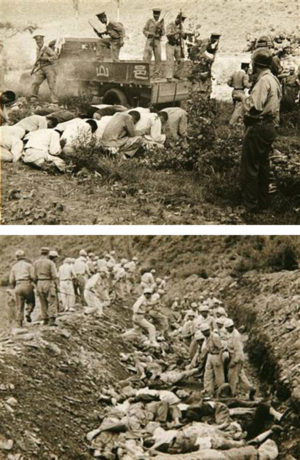 Oct 2: Korean war: Evidence of atrocities come to light. Evidence of North Korean atrocities are coming to light when thirty-five mutilated bodies of men, women and children are discovered in eastern Seoul. They are believed to be a small part of at least two thousand men, women and children who were rounded up by Communist political police shortly after the U.N. landing at Inchon. At least 18,000 relatives of police and government employees have been murdered in Seoul during the Communists’ three-month occupation. Another 1,100 bodies have been uncovered so far in Taejon (Daejeon), South Korea’s temporary capital for the first three weeks of July. Another five to six thousand are feared massacred there. While Communist occupiers did perpetrate a number of massacres in South Korea, it will be revealed in 2008 that many of the massacres at Taejon which were blamed on the North Koreans were actually committed by the South Korean government of Syngman Rhee. President Rhee ordered the execution of an estimated 60,000 to 200,000 suspected Communists and political opponents soon after the war broke out in June. The revelations fifty-eight years later will also show that U.S. commanders knew about many of the massacres, and that some U.S. military personnel were present and had witnessed them.
Oct 2: Korean war: Evidence of atrocities come to light. Evidence of North Korean atrocities are coming to light when thirty-five mutilated bodies of men, women and children are discovered in eastern Seoul. They are believed to be a small part of at least two thousand men, women and children who were rounded up by Communist political police shortly after the U.N. landing at Inchon. At least 18,000 relatives of police and government employees have been murdered in Seoul during the Communists’ three-month occupation. Another 1,100 bodies have been uncovered so far in Taejon (Daejeon), South Korea’s temporary capital for the first three weeks of July. Another five to six thousand are feared massacred there. While Communist occupiers did perpetrate a number of massacres in South Korea, it will be revealed in 2008 that many of the massacres at Taejon which were blamed on the North Koreans were actually committed by the South Korean government of Syngman Rhee. President Rhee ordered the execution of an estimated 60,000 to 200,000 suspected Communists and political opponents soon after the war broke out in June. The revelations fifty-eight years later will also show that U.S. commanders knew about many of the massacres, and that some U.S. military personnel were present and had witnessed them.
![]()
 Oct 2: Tibetans seek negotiations with Communist China. Envoys from Tibet meeting in New Delhi with delegates from the People’s Republic of China say that China is refusing to negotiate an accord there. China insists that the Tibetan delegation must go to Peiping (Beijing) to conclude negotiations. Tibet had been a highly autonomous region in China for centuries. Tibet, along with several other regions, became effectively independent after the Republic of China overthrew the Qing dynasty in 1912 but was unable to assert control over the entire country. Both the Chinese Communists and the Republicans (Nationalists) consider Tibet a part of China, and no other nation has recognized Tibet’s independence. Tibet’s chief delegate, Tsepon Shakabpa, says that they are still waiting for Peiping to answer a number of questions, including what Peiping means by the “liberation” of Tibet. Shakabpa proposes the following: “Tibet will remain independent as it is at present, and we will continue to have very close ‘priest-patron’ relations with China. Also, there is no need to liberate Tibet from imperialism, since there are no British, American or Kuomintang (Nationalist) imperialists in Tibet, and Tibet is ruled and protected by the Dalai Lama.”
Oct 2: Tibetans seek negotiations with Communist China. Envoys from Tibet meeting in New Delhi with delegates from the People’s Republic of China say that China is refusing to negotiate an accord there. China insists that the Tibetan delegation must go to Peiping (Beijing) to conclude negotiations. Tibet had been a highly autonomous region in China for centuries. Tibet, along with several other regions, became effectively independent after the Republic of China overthrew the Qing dynasty in 1912 but was unable to assert control over the entire country. Both the Chinese Communists and the Republicans (Nationalists) consider Tibet a part of China, and no other nation has recognized Tibet’s independence. Tibet’s chief delegate, Tsepon Shakabpa, says that they are still waiting for Peiping to answer a number of questions, including what Peiping means by the “liberation” of Tibet. Shakabpa proposes the following: “Tibet will remain independent as it is at present, and we will continue to have very close ‘priest-patron’ relations with China. Also, there is no need to liberate Tibet from imperialism, since there are no British, American or Kuomintang (Nationalist) imperialists in Tibet, and Tibet is ruled and protected by the Dalai Lama.”
![]()
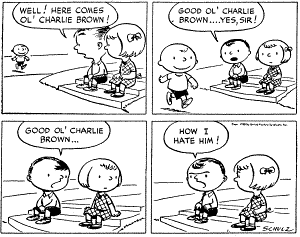 Oct 2: First Peanuts cartoon appears in newspapers. Charles M. Shultz’s comic strip Peanuts is first published in nine newspapers: The Allentown (PA) Morning Call, The Bethlehem (PA) Globe-Times, the Boston Globe, The Chicago Tribune, The Denver Post, The Minneapolis Tribune, The New York World-Telegram & Sun, The Seattle Times, and The Washington Post.
Oct 2: First Peanuts cartoon appears in newspapers. Charles M. Shultz’s comic strip Peanuts is first published in nine newspapers: The Allentown (PA) Morning Call, The Bethlehem (PA) Globe-Times, the Boston Globe, The Chicago Tribune, The Denver Post, The Minneapolis Tribune, The New York World-Telegram & Sun, The Seattle Times, and The Washington Post.
▲Tuesday, October 3
 Oct 3: University of Alabama newspaper editorial endorses desegregation. The University of Alabama’s student newspaper, the Crimson-White, publishes the most unexpected editorial imaginable: “The Southern college and the color line.” Acting Editor Sam Harvey summarizes recent moves toward toward African-American enrollment in southern universities — U.S. Supreme Court June decisions compelling Texas and Oklahoma to enroll African-American grad students under limited conditions, and the Tennessee Attorney General’s similar opinion last week for that state’s public colleges — and observes, “Slowly but surely, Negroes are getting closer and closer to their goal of admission into every Southern university. … Here at Alabama, the problem hasn’t come up, but eventually it will.” Harvey predicts that when that day comes, “the hue and cry will be natural and is to be expected,” but it’s inevitable. “You can hardly argue with the Supreme Court.” Harvey doesn’t anticipate much trouble. “Actually we fail to see what would be so terrible about having a Negro sitting int he same room listening to the same professor as white students. We Southerners think nothing of riding the same buses or shopping in the same stores. We doubt if the violent proponents of segregation leave the room when a Negro janitor comes in to sweep. We don’t think students will leave the room when a Negro student comes in to learn.” After the wire services notice the editorial and stories appear in newspapers nationwide, Harvey will backtrack a bit a week later.
Oct 3: University of Alabama newspaper editorial endorses desegregation. The University of Alabama’s student newspaper, the Crimson-White, publishes the most unexpected editorial imaginable: “The Southern college and the color line.” Acting Editor Sam Harvey summarizes recent moves toward toward African-American enrollment in southern universities — U.S. Supreme Court June decisions compelling Texas and Oklahoma to enroll African-American grad students under limited conditions, and the Tennessee Attorney General’s similar opinion last week for that state’s public colleges — and observes, “Slowly but surely, Negroes are getting closer and closer to their goal of admission into every Southern university. … Here at Alabama, the problem hasn’t come up, but eventually it will.” Harvey predicts that when that day comes, “the hue and cry will be natural and is to be expected,” but it’s inevitable. “You can hardly argue with the Supreme Court.” Harvey doesn’t anticipate much trouble. “Actually we fail to see what would be so terrible about having a Negro sitting int he same room listening to the same professor as white students. We Southerners think nothing of riding the same buses or shopping in the same stores. We doubt if the violent proponents of segregation leave the room when a Negro janitor comes in to sweep. We don’t think students will leave the room when a Negro student comes in to learn.” After the wire services notice the editorial and stories appear in newspapers nationwide, Harvey will backtrack a bit a week later.![]()
 Oct 3: Vietnam, Battle of RC4: Viet Minh mauls rescue force, Cao Bang attempts evacuation. In the French Indochina State of Vietnam, the Foreign Legion’s First Paratrooper Battalion (1er BEP), the lead force for Groupement Bayard, were supposed to have captured Dong Khe by now in their mission to rescue the French garrison trying to evacuate Cao Bang. But after three days of bitter fighting along jagged jungle mountains to the west of Route Coloniale 4, the 1er BEP only gets to the mountains around Na Pa about three miles (5 km) south of Dong Khe, where they’re stopped by wave after wave of Viet Minh assaults that last well into the night. The massive onslaught leaves much of the Groupement traumatized and in a state of panic. Their ammunition and rations are running low, and cloudy weather has thwarted efforts to drop supplies by air. Somehow, the groupement manages to hold its ground, despite heavy losses. When they started their rescue mission on October 1, they had 3,500 troops. They’re now down to about 500 men, many of them wounded, and all of them exhausted and hungry, without rations and fresh water, and running desperately low on ammunition. Meanwhile in Cao Bang, the Foreign Legion 3rd Infantry (3e REI) leaves its citadel for the second time. The 3e REI’s commander, again, goes against orders and brings his heavy equipment and motor transport with him instead of destroying it and leaving it behind. The vehicles confine him to the narrow mountain valley road — the very same road that the 1er BEP is fighting to avoid — leaving the 3e REI exposed to Viet Minh ambushes. The commander also brings with him about 500 Vietnamese and Chinese refugees, which greatly slows his progress. Viet Minh Gen. Võ Nguyên Giáp is waiting with 30,000 men on RC4 ready to ambush.
Oct 3: Vietnam, Battle of RC4: Viet Minh mauls rescue force, Cao Bang attempts evacuation. In the French Indochina State of Vietnam, the Foreign Legion’s First Paratrooper Battalion (1er BEP), the lead force for Groupement Bayard, were supposed to have captured Dong Khe by now in their mission to rescue the French garrison trying to evacuate Cao Bang. But after three days of bitter fighting along jagged jungle mountains to the west of Route Coloniale 4, the 1er BEP only gets to the mountains around Na Pa about three miles (5 km) south of Dong Khe, where they’re stopped by wave after wave of Viet Minh assaults that last well into the night. The massive onslaught leaves much of the Groupement traumatized and in a state of panic. Their ammunition and rations are running low, and cloudy weather has thwarted efforts to drop supplies by air. Somehow, the groupement manages to hold its ground, despite heavy losses. When they started their rescue mission on October 1, they had 3,500 troops. They’re now down to about 500 men, many of them wounded, and all of them exhausted and hungry, without rations and fresh water, and running desperately low on ammunition. Meanwhile in Cao Bang, the Foreign Legion 3rd Infantry (3e REI) leaves its citadel for the second time. The 3e REI’s commander, again, goes against orders and brings his heavy equipment and motor transport with him instead of destroying it and leaving it behind. The vehicles confine him to the narrow mountain valley road — the very same road that the 1er BEP is fighting to avoid — leaving the 3e REI exposed to Viet Minh ambushes. The commander also brings with him about 500 Vietnamese and Chinese refugees, which greatly slows his progress. Viet Minh Gen. Võ Nguyên Giáp is waiting with 30,000 men on RC4 ready to ambush.
![]()
 Oct 3: First cable TV company gets go-ahead to run cable through town. The Lansford, Pennsylvania, borough council grants permission to Panther Valley Television Company to run television cable across the town’s streets in order to bring television reception to Lansford homes and businesses. Lansford lies in a deep, narrow valley, surrounded by high mountains that block TV signals from Philadelphia. Lansford residents have to drive up the mountain to the community of Summit Hill to watch TV at some of the town’s bars. That’s good business for Summit Hill bars, but not the best option for Lansford families. Several Lansford businessmen involved with radio and television sales and service have banded together to form a venture to erect a large TV antenna on Summit Hill. From there, a system of coaxial cables and amplifiers will bring the signal down into the valley and into subscribers’ homes. Panther Valley TV is the first viable commercial cable TV company in the country. Subscribers pay a one-time installation fee of $100 (about $1,050 today) and $3 ($35) per month to receive Channels 3, 6, and 10 from Philadelphia. The first subscribers will enjoy television from the comfort of their own living rooms by the end of the month.
Oct 3: First cable TV company gets go-ahead to run cable through town. The Lansford, Pennsylvania, borough council grants permission to Panther Valley Television Company to run television cable across the town’s streets in order to bring television reception to Lansford homes and businesses. Lansford lies in a deep, narrow valley, surrounded by high mountains that block TV signals from Philadelphia. Lansford residents have to drive up the mountain to the community of Summit Hill to watch TV at some of the town’s bars. That’s good business for Summit Hill bars, but not the best option for Lansford families. Several Lansford businessmen involved with radio and television sales and service have banded together to form a venture to erect a large TV antenna on Summit Hill. From there, a system of coaxial cables and amplifiers will bring the signal down into the valley and into subscribers’ homes. Panther Valley TV is the first viable commercial cable TV company in the country. Subscribers pay a one-time installation fee of $100 (about $1,050 today) and $3 ($35) per month to receive Channels 3, 6, and 10 from Philadelphia. The first subscribers will enjoy television from the comfort of their own living rooms by the end of the month.
▲Wednesday, October 4
![]() Oct 4: Korean War: U.N. General Assembly gives go-ahead to cross the 38th Parallel. The United Nations General Assembly, meeting as the Political and Security Committee, approves a resolution giving Gen. Douglas MacArthur tacit approval to move across the Thirty-eighth Parallel. Many delegations agree that MacArthur already has the right send troops across the Parallel, but feel that this resolution will lend moral support. The lopsided vote is forty-seven to five, with Byelorussia, Czechoslovakia, Poland, the Soviet Union, and Ukraine voting against. Seven nations abstain: Afghanistan, India, Lebanon, Egypt, Syria, Yemen, and Yugoslavia. Indonesia, which joined the U.N. just last week, did not vote. Because the General Assembly met as the Political and Security Committee, on which all U.N. member states are represented, the resolution still requires another vote by the General Assembly on October 7 for ratification.
Oct 4: Korean War: U.N. General Assembly gives go-ahead to cross the 38th Parallel. The United Nations General Assembly, meeting as the Political and Security Committee, approves a resolution giving Gen. Douglas MacArthur tacit approval to move across the Thirty-eighth Parallel. Many delegations agree that MacArthur already has the right send troops across the Parallel, but feel that this resolution will lend moral support. The lopsided vote is forty-seven to five, with Byelorussia, Czechoslovakia, Poland, the Soviet Union, and Ukraine voting against. Seven nations abstain: Afghanistan, India, Lebanon, Egypt, Syria, Yemen, and Yugoslavia. Indonesia, which joined the U.N. just last week, did not vote. Because the General Assembly met as the Political and Security Committee, on which all U.N. member states are represented, the resolution still requires another vote by the General Assembly on October 7 for ratification.
![]()
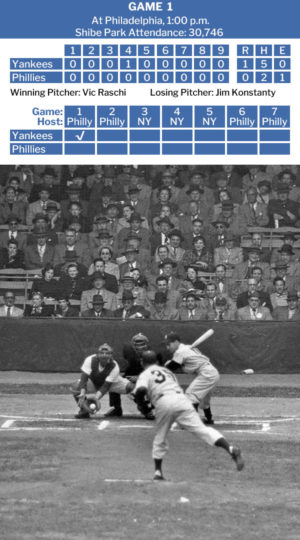 Oct 4: World Series, Game 1. The Philadelphia Phillies host the New York Yankees at Shibe Park for Game 1 of the 1950 World Series. The Yankees are 3:1 favorites to win the series, but this year’s series will wind up being an epic contest between two strong pitching staffs that result in the lowest-scoring series played so far. The young Phillies team, dubbed the “Whiz Kids,” have just won the National League pennant in a dramatic game on the last day of the regular season, allowing Phillies to make this appearance for the first time in thirty-five years. Phillies manager Eddie Sawyer shocks the hometown crowd when he taps his star relief pitcher Jim Konstanty, who has never started a game in four years, as the starting pitcher. The Phillies number one pitcher, Robin Roberts, had just pitched in three of the last five games, including the last game of the season, and Sawyer felt he needed some time off. Their other star pitcher, Curt Simmons was called up in the draft in early September to serve in the Army. Simmons is at the game on a ten-day furlough, but only as a spectator. Konstanty doesn’t disappoint. He allows just four hits and one run in his eight innings on the mound, the Phillies’ pitching staff’s best showing in the series. But the Yankees’ Vic Raschi did even better, shutting out the Phillies on only two hits. Box seats at Shibe Park go for $8.75 (about $95 today), reserved seats are $6.50 (about $70), and bleachers are $1 (about $11)). The city fire marshal has banned the selling of standing room tickets for the small and aging ballpark due to safety concerns. Reporters are shocked to see a large number of empty seats. It turns out that about 2,000 tickets weren’t distributed and the Phillies’ ticket office found them in storage still unsold.
Oct 4: World Series, Game 1. The Philadelphia Phillies host the New York Yankees at Shibe Park for Game 1 of the 1950 World Series. The Yankees are 3:1 favorites to win the series, but this year’s series will wind up being an epic contest between two strong pitching staffs that result in the lowest-scoring series played so far. The young Phillies team, dubbed the “Whiz Kids,” have just won the National League pennant in a dramatic game on the last day of the regular season, allowing Phillies to make this appearance for the first time in thirty-five years. Phillies manager Eddie Sawyer shocks the hometown crowd when he taps his star relief pitcher Jim Konstanty, who has never started a game in four years, as the starting pitcher. The Phillies number one pitcher, Robin Roberts, had just pitched in three of the last five games, including the last game of the season, and Sawyer felt he needed some time off. Their other star pitcher, Curt Simmons was called up in the draft in early September to serve in the Army. Simmons is at the game on a ten-day furlough, but only as a spectator. Konstanty doesn’t disappoint. He allows just four hits and one run in his eight innings on the mound, the Phillies’ pitching staff’s best showing in the series. But the Yankees’ Vic Raschi did even better, shutting out the Phillies on only two hits. Box seats at Shibe Park go for $8.75 (about $95 today), reserved seats are $6.50 (about $70), and bleachers are $1 (about $11)). The city fire marshal has banned the selling of standing room tickets for the small and aging ballpark due to safety concerns. Reporters are shocked to see a large number of empty seats. It turns out that about 2,000 tickets weren’t distributed and the Phillies’ ticket office found them in storage still unsold.
![]()
 Oct 4: Technical difficulties interrupt World Series telecast. Television is still in its infancy and “technical difficulties” are quite the norm, especially with live remote broadcasts. The World Series is being simulcast (a word that has not yet been invented) by three of the four major networks — ABC, CBS, and NBC, with DuMont staying with its normal programming. During a twenty-minute period, from the first half of the second inning until the end of the third, trouble with a microwave link in Philadelphia blanks TV screens from Boston to Jacksonville to Omaha — the full extent of national network relays so far — although the sound is still barely audible. A little later, the audio is interrupted while the video plays on. CBS viewers are puzzled when, during part of the pre-game programming, they hear the audio from the daily soap opera, “Our Gal Sunday” instead of the announcers on the screen. But generally, the New York Times’s Jack Gould concludes that “when it was on the air in one piece, TV didn’t do too bad a job.” The play-by-play by Jack Brickhouse and Jim Britt was “a reasonably direct reportorial job,” and “the camera work of Philadelphia’s WPTZ for the most part was alert.” The five cameras deployed in carefully chosen locations “reflected careful preparation,” says Gould. “The placement of a camera so that there was a direct, downward view of first base was very effective.” Just under 20% of American homes have a television set, and many TV viewers watch the World Series at department store display windows, in some of the bars, and in special locations set up for the games by TV manufacturers and retailers.
Oct 4: Technical difficulties interrupt World Series telecast. Television is still in its infancy and “technical difficulties” are quite the norm, especially with live remote broadcasts. The World Series is being simulcast (a word that has not yet been invented) by three of the four major networks — ABC, CBS, and NBC, with DuMont staying with its normal programming. During a twenty-minute period, from the first half of the second inning until the end of the third, trouble with a microwave link in Philadelphia blanks TV screens from Boston to Jacksonville to Omaha — the full extent of national network relays so far — although the sound is still barely audible. A little later, the audio is interrupted while the video plays on. CBS viewers are puzzled when, during part of the pre-game programming, they hear the audio from the daily soap opera, “Our Gal Sunday” instead of the announcers on the screen. But generally, the New York Times’s Jack Gould concludes that “when it was on the air in one piece, TV didn’t do too bad a job.” The play-by-play by Jack Brickhouse and Jim Britt was “a reasonably direct reportorial job,” and “the camera work of Philadelphia’s WPTZ for the most part was alert.” The five cameras deployed in carefully chosen locations “reflected careful preparation,” says Gould. “The placement of a camera so that there was a direct, downward view of first base was very effective.” Just under 20% of American homes have a television set, and many TV viewers watch the World Series at department store display windows, in some of the bars, and in special locations set up for the games by TV manufacturers and retailers.
![]()
 Oct 4: Vietnam, Battle of RC4: French Cao Bang garrison forced into the jungles. In the French Indochina State of Vietnam, the Foreign Legion’s 3rd Infantry (3e REI), which had evacuated Cao Bang the day before with some 500 refugees in tow, has been harassed with sporadic ambushes and mines embedded in the road throughout the day. They are now faced with the impossibility of staying on Route Colonial 4 to Dong Khe, which is still in Viet Minh hands. The commander orders the destruction of his vehicles and heavy equipment and leaves most of the refugees on RC4. He moves his forces off the highway and to the west, where maps show an older road going south. Unfortunately, the jungle has entirely overtaken the road, reducing it to an overgrown foot-path, which forces the soldiers and civilians to slash their way through with machetes. By nightfall, they’ve only progressed 5 miles (8 km). Meanwhile, the remnants of Groupement Bayard, led by the Foreign Legion’s First Paratrooper Battalion (1er BEP) coming up from That Khe, have gathered at Hill 765 shortly after midnight. This follows an exhausting day of fighting, from jagged peak to jagged peak, through the dense jungle and pouring rain around Na Pa. Hill 765 is part of a ridge that separates RC4 from the Quang Liet Valley to the west. Their new objective is the tiny hamlet of Coc Xa, where they hope to meet up with 3e REI. They’ve spent the entire day trying to move westward, but the steep cliffs, narrow passages, thick mud from the heavy rains, and extreme fatigue slows their progress to about 200 meters per hour. In the darkness, they can’t see their way down from the ridges to the valley below. They encounter steep cliffs everywhere they turn. At four in the morning, they come to a complete halt at the edge of the cliffs.
Oct 4: Vietnam, Battle of RC4: French Cao Bang garrison forced into the jungles. In the French Indochina State of Vietnam, the Foreign Legion’s 3rd Infantry (3e REI), which had evacuated Cao Bang the day before with some 500 refugees in tow, has been harassed with sporadic ambushes and mines embedded in the road throughout the day. They are now faced with the impossibility of staying on Route Colonial 4 to Dong Khe, which is still in Viet Minh hands. The commander orders the destruction of his vehicles and heavy equipment and leaves most of the refugees on RC4. He moves his forces off the highway and to the west, where maps show an older road going south. Unfortunately, the jungle has entirely overtaken the road, reducing it to an overgrown foot-path, which forces the soldiers and civilians to slash their way through with machetes. By nightfall, they’ve only progressed 5 miles (8 km). Meanwhile, the remnants of Groupement Bayard, led by the Foreign Legion’s First Paratrooper Battalion (1er BEP) coming up from That Khe, have gathered at Hill 765 shortly after midnight. This follows an exhausting day of fighting, from jagged peak to jagged peak, through the dense jungle and pouring rain around Na Pa. Hill 765 is part of a ridge that separates RC4 from the Quang Liet Valley to the west. Their new objective is the tiny hamlet of Coc Xa, where they hope to meet up with 3e REI. They’ve spent the entire day trying to move westward, but the steep cliffs, narrow passages, thick mud from the heavy rains, and extreme fatigue slows their progress to about 200 meters per hour. In the darkness, they can’t see their way down from the ridges to the valley below. They encounter steep cliffs everywhere they turn. At four in the morning, they come to a complete halt at the edge of the cliffs.
▲Thursday, October 5
![]()
 Oct 5: World Series, Game 2: The Phillies’ ace pitcher Robin Roberts and the Yankees’ Allie Reynolds duel to a 1-1 tie in nine innings. At the top of the tenth, the Yankees’ Joe DiMaggio sends a home run to left field to win the game. Phillies fans don’t know it yet, but with the series moving to New York for Game 3 of the best-of-seven series, this will be the last post-season game ever played in Shibe Park.
Oct 5: World Series, Game 2: The Phillies’ ace pitcher Robin Roberts and the Yankees’ Allie Reynolds duel to a 1-1 tie in nine innings. At the top of the tenth, the Yankees’ Joe DiMaggio sends a home run to left field to win the game. Phillies fans don’t know it yet, but with the series moving to New York for Game 3 of the best-of-seven series, this will be the last post-season game ever played in Shibe Park.
![]()
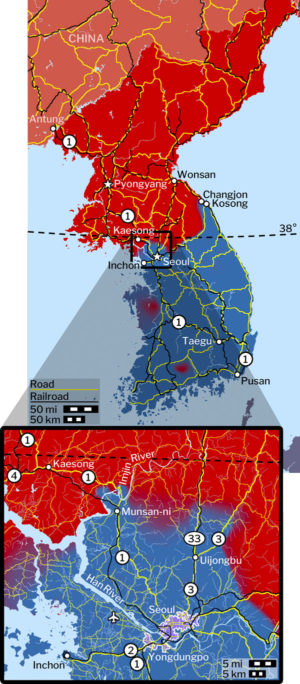 Oct 5: Korean War: South Koreans continue race up the coast. United Nations air forces heavily bomb the area around Wonsan, North Korea’s most important port. The bombing is part of the South’s Republic of Korea (ROK) II Corps race up the east coast. ROK forces are now in the fishing ports of Kosong and Changjon, and are expected to be in Wonsan just days from now. North of Seoul, U.S. Marines perform mop-up operations at Uijongbu (Uijeongbu) and slowly press northward toward the 38th Parallel against heavy enemy resistance. To the west, American forces at Munsan-ni are still organizing and collecting scarce supplies in preparation for moving on to Kaesong. Overnight, they will cross the Imjin River at two blown-out bridges, northwest and northeast of Munsan-ni, and establish beachheads on the opposite bank.
Oct 5: Korean War: South Koreans continue race up the coast. United Nations air forces heavily bomb the area around Wonsan, North Korea’s most important port. The bombing is part of the South’s Republic of Korea (ROK) II Corps race up the east coast. ROK forces are now in the fishing ports of Kosong and Changjon, and are expected to be in Wonsan just days from now. North of Seoul, U.S. Marines perform mop-up operations at Uijongbu (Uijeongbu) and slowly press northward toward the 38th Parallel against heavy enemy resistance. To the west, American forces at Munsan-ni are still organizing and collecting scarce supplies in preparation for moving on to Kaesong. Overnight, they will cross the Imjin River at two blown-out bridges, northwest and northeast of Munsan-ni, and establish beachheads on the opposite bank.
![]()
 Oct 5: Vietnam, Battle of RC4: French rescuers now need to be rescued. The French Foreign Legion’s First Paratrooper Battalion (1er BEP), the lead force for Groupement Bayard assigned to rescue the Foreign Legion’s 3rd Infantry (3e REI), is still trying to find its way down from the sheer cliffs of Hill 765. Their objective is the tiny hamlet of Coc Xa in the Quang Liet Valley below. In the daylight, they discover a double bowl on the side of 765, surrounded by steep walls on all sides. There’s an opening at the far end, where a steep passage opens out to a 75-foot (25 m) drop to the the valley below and Coc Xa beyond. The 1er BEP commander decides that the bowl is a safe place to rest, as long as they can hold the surrounding heights. Later that afternoon, the commander accedes to his officers’ worries that the bowl is indefensible and they need to move out. He directs the groupement to begin moving to Hill 477 across the valley. An hour later, as the first detachment of twenty soldiers reaches the valley, a wave of several hundred Viet Minh wipes them out. The 1er BEP now realize that the Viet Minh has swarmed the valley and that they are surrounded. Meanwhile to the north, the 3e REI convoy, which has been struggling its way south from Cao Bang, is given new orders: proceed to the Quang Liet Valley. They also have a new mission: to rescue their rescuers.
Oct 5: Vietnam, Battle of RC4: French rescuers now need to be rescued. The French Foreign Legion’s First Paratrooper Battalion (1er BEP), the lead force for Groupement Bayard assigned to rescue the Foreign Legion’s 3rd Infantry (3e REI), is still trying to find its way down from the sheer cliffs of Hill 765. Their objective is the tiny hamlet of Coc Xa in the Quang Liet Valley below. In the daylight, they discover a double bowl on the side of 765, surrounded by steep walls on all sides. There’s an opening at the far end, where a steep passage opens out to a 75-foot (25 m) drop to the the valley below and Coc Xa beyond. The 1er BEP commander decides that the bowl is a safe place to rest, as long as they can hold the surrounding heights. Later that afternoon, the commander accedes to his officers’ worries that the bowl is indefensible and they need to move out. He directs the groupement to begin moving to Hill 477 across the valley. An hour later, as the first detachment of twenty soldiers reaches the valley, a wave of several hundred Viet Minh wipes them out. The 1er BEP now realize that the Viet Minh has swarmed the valley and that they are surrounded. Meanwhile to the north, the 3e REI convoy, which has been struggling its way south from Cao Bang, is given new orders: proceed to the Quang Liet Valley. They also have a new mission: to rescue their rescuers.
![]()
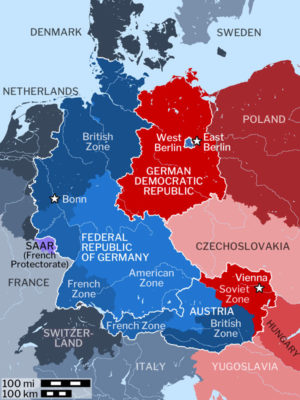 Oct 5: Austrian Communists halt trains in Vienna. Crowds of Austrian Communist demonstrators, frustrated by the failure of the general strike called for the previous day, halt all train traffic going into and out of Vienna for three hours from various points in the Soviet occupation zones of Vienna and surrounding eastern Austria. A week and a half earlier, the Austrian government passed a series of difficult fiscal measures to weaken the country’s price controls and allow prices to rise to levels that are more in line with those of neighboring countries. The Communists responded by calling for a general strike and demanding a 20% wage hike, a price freeze on goods, and no devaluation of the Austrian shilling. Austrians see the demands for what they are: impossible to meet, and a pretext for unrest. Austrian Socialist unions have rejected the strike call. A Socialist government minister sums up the general feeling: “Let it be clearly understood the issue is no longer the value of the schilling or the height of wages, but freedom of our country.” The city of Vienna, like Berlin, is divided by the four occupying powers — U.S., Britain, France, and the Soviet Union — with the entire city sitting inside the larger Soviet occupation zone of eastern Austria. Viennese shops have been stripped bare from panic buying as residents fear a Berlin-style blockade of food, telephone, gas and electricity. The Austrian government files a formal protest with the four occupying powers charging the Soviets with supporting Communist-led riots that have rocked the country for two days. The strikes will finally be called off the next day.
Oct 5: Austrian Communists halt trains in Vienna. Crowds of Austrian Communist demonstrators, frustrated by the failure of the general strike called for the previous day, halt all train traffic going into and out of Vienna for three hours from various points in the Soviet occupation zones of Vienna and surrounding eastern Austria. A week and a half earlier, the Austrian government passed a series of difficult fiscal measures to weaken the country’s price controls and allow prices to rise to levels that are more in line with those of neighboring countries. The Communists responded by calling for a general strike and demanding a 20% wage hike, a price freeze on goods, and no devaluation of the Austrian shilling. Austrians see the demands for what they are: impossible to meet, and a pretext for unrest. Austrian Socialist unions have rejected the strike call. A Socialist government minister sums up the general feeling: “Let it be clearly understood the issue is no longer the value of the schilling or the height of wages, but freedom of our country.” The city of Vienna, like Berlin, is divided by the four occupying powers — U.S., Britain, France, and the Soviet Union — with the entire city sitting inside the larger Soviet occupation zone of eastern Austria. Viennese shops have been stripped bare from panic buying as residents fear a Berlin-style blockade of food, telephone, gas and electricity. The Austrian government files a formal protest with the four occupying powers charging the Soviets with supporting Communist-led riots that have rocked the country for two days. The strikes will finally be called off the next day.
![]()
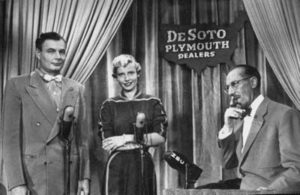 Oct 5: Groucho Marx’s You Bet Your Life premieres on television. Groucho Marx’s comedy quiz show You Bet Your Life, which began on radio in 1947, premieres on NBC television. The audio from the television broadcast went out over NBC radio the day before. The New York Times‘ Jack Gould remarks that showing a “premiere” that radio listeners have already heard “represents the first time that NBC has conceded publicly that a televiewer is not apt to turn on his radio. Boy, there’s going to be a conference this morning at 30 Rockefeller Plaza!”
Oct 5: Groucho Marx’s You Bet Your Life premieres on television. Groucho Marx’s comedy quiz show You Bet Your Life, which began on radio in 1947, premieres on NBC television. The audio from the television broadcast went out over NBC radio the day before. The New York Times‘ Jack Gould remarks that showing a “premiere” that radio listeners have already heard “represents the first time that NBC has conceded publicly that a televiewer is not apt to turn on his radio. Boy, there’s going to be a conference this morning at 30 Rockefeller Plaza!”
▲Friday, October 6
![]()
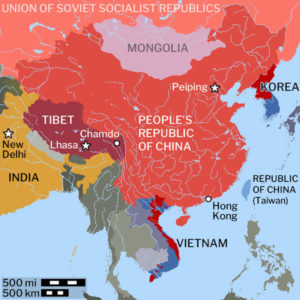 Oct 6: Communist China begins incursion into Tibet. The Chinese People’s Liberation Army crosses the Jinsha River on Tibet’s eastern border and enters Tibet. The next day, the PLA will arrive at Chamdo (Qamdo). The PLA’s objective is to capture the Tibetan Army’s garrison of about 3,000 soldiers. The PLA quickly surrounds Chamdo and begins an almost two-week siege. The next day, the Chinese will deny press reports that they have entered Tibet. Due to poor communication lines between Chamdo and Lhasa, the Tibetan delegation engaged with negotiations with a Chinese delegation in New Delhi also say they are unaware of any incursion.
Oct 6: Communist China begins incursion into Tibet. The Chinese People’s Liberation Army crosses the Jinsha River on Tibet’s eastern border and enters Tibet. The next day, the PLA will arrive at Chamdo (Qamdo). The PLA’s objective is to capture the Tibetan Army’s garrison of about 3,000 soldiers. The PLA quickly surrounds Chamdo and begins an almost two-week siege. The next day, the Chinese will deny press reports that they have entered Tibet. Due to poor communication lines between Chamdo and Lhasa, the Tibetan delegation engaged with negotiations with a Chinese delegation in New Delhi also say they are unaware of any incursion.
![]()
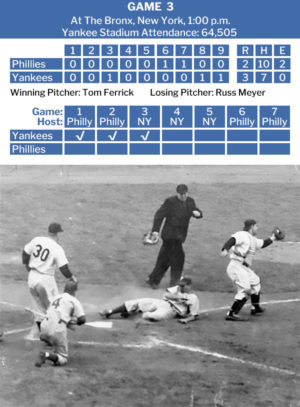 Oct 6: World Series, Game 3. The Phillies’ “Whiz Kids” go to New York for Game 3 against the New York Yankees. Box seats at Yankee stadium go for $8 (about $85 today) a ticket, reserved seats are $6 ($65), bleachers are $1 ($11) and standing room tickets can be had for $4 ($45). For Game 3, the Phillies take a 2-1 lead in the seventh inning, their first and only lead in the series, when shortstop Granny Hamner slides into home base. But after two outs in the eighth, Phillies starting pitcher Ken Heintzelman begins to lose control. He walks Jerry Coleman, Yogi Berra and Joe DiMaggio to load the bases. Star pitcher Jim Konstanty relieves Heintzelman, but the Yankees score on an error by Hamner before Heintzelman can close the inning. With the game now tied, and the Phillies failing to score in the ninth, it’s beginning to look like another extra-innings game. With the Yankees at bat, Phillies pitcher Russ Meyer comes in and quickly retires two batters. But then he gives up two consecutive singles to allow Jerry Coleman to drive in the winning run. The Yankees are now just one game away from a sweep.
Oct 6: World Series, Game 3. The Phillies’ “Whiz Kids” go to New York for Game 3 against the New York Yankees. Box seats at Yankee stadium go for $8 (about $85 today) a ticket, reserved seats are $6 ($65), bleachers are $1 ($11) and standing room tickets can be had for $4 ($45). For Game 3, the Phillies take a 2-1 lead in the seventh inning, their first and only lead in the series, when shortstop Granny Hamner slides into home base. But after two outs in the eighth, Phillies starting pitcher Ken Heintzelman begins to lose control. He walks Jerry Coleman, Yogi Berra and Joe DiMaggio to load the bases. Star pitcher Jim Konstanty relieves Heintzelman, but the Yankees score on an error by Hamner before Heintzelman can close the inning. With the game now tied, and the Phillies failing to score in the ninth, it’s beginning to look like another extra-innings game. With the Yankees at bat, Phillies pitcher Russ Meyer comes in and quickly retires two batters. But then he gives up two consecutive singles to allow Jerry Coleman to drive in the winning run. The Yankees are now just one game away from a sweep.
![]()
 Oct 6: Vietnam, Battle of RC4: French High Command issues optimistic statement. The French High Command in Saigon issues a rosy communiqué describing “the successful conclusion of the first phase of the land retreat from Caobang.” It claims that the the Foreign Legion’s 3rd Infantry (3e REI) “with weapons and vehicles … were said to have reached a rendezvous with a strong relieving force from the Chinese border post of Thatkhe. … So far there have been no Vietminh attacks on the Caobang column, and it is believed the combined force will soon reach Thatkhe from where a highway is regularly kept open to Langson.” This assessment couldn’t have been further from the truth. The two forces haven’t met up yet, although they do make radio contact. 3e REI arrives and is tasked with occupying Hill 590 and covering the western end of the valley. Their erstwhile rescuers, Groupement Bayard, led by the Foreign Legion’s First Paratrooper Battalion (1er BEP), is still in the bowl on the western face of Hill 765. The Groupement’s commander now realizes that he has stayed in the bowl too long. His only choice now is to move to Hill 477 in a night attack. His subordinates however convince him to wait until the next day, in the hopes that clearing weather will allow air support and resupply.
Oct 6: Vietnam, Battle of RC4: French High Command issues optimistic statement. The French High Command in Saigon issues a rosy communiqué describing “the successful conclusion of the first phase of the land retreat from Caobang.” It claims that the the Foreign Legion’s 3rd Infantry (3e REI) “with weapons and vehicles … were said to have reached a rendezvous with a strong relieving force from the Chinese border post of Thatkhe. … So far there have been no Vietminh attacks on the Caobang column, and it is believed the combined force will soon reach Thatkhe from where a highway is regularly kept open to Langson.” This assessment couldn’t have been further from the truth. The two forces haven’t met up yet, although they do make radio contact. 3e REI arrives and is tasked with occupying Hill 590 and covering the western end of the valley. Their erstwhile rescuers, Groupement Bayard, led by the Foreign Legion’s First Paratrooper Battalion (1er BEP), is still in the bowl on the western face of Hill 765. The Groupement’s commander now realizes that he has stayed in the bowl too long. His only choice now is to move to Hill 477 in a night attack. His subordinates however convince him to wait until the next day, in the hopes that clearing weather will allow air support and resupply.
▲Saturday, October 7
![]() Oct 7: U.N. General Assembly calls for Korea’s reunification. The U.N. General Assembly formally approves Resolution 376(V) in a 47 to 5 vote. It calls for Korea’s reunification and authorizes U.N. forces to cross the 38th Parallel. The U.S. and Great Britain reiterate their pledge before the General Assembly that they will not cross into China or the Soviet Union.
Oct 7: U.N. General Assembly calls for Korea’s reunification. The U.N. General Assembly formally approves Resolution 376(V) in a 47 to 5 vote. It calls for Korea’s reunification and authorizes U.N. forces to cross the 38th Parallel. The U.S. and Great Britain reiterate their pledge before the General Assembly that they will not cross into China or the Soviet Union.
![]()
 Oct 7: Korean War: South Koreans cross the 38th Parallel in two more places. The day before, the South’s Republic of Korea (ROK) 6th Division crossed the the Parallel in central Korea just north of Chunchon (Chuncheon). The 6th Division is now in its second day of intense battles with the North’s Korean People’s Army (KPA) as it presses northward toward Hwachon (Hwacheon). It will take Hwachon the next day. Today, the ROK 8th Division crosses the Parallel from Uijongbu (Uijeongbu), and is headed toward Chorwon (Cheorwon). Chorwon is at one corner of a heavily fortified area that reporters will later call the Iron Triangle. This relatively flat terrain, shaped like a slightly tilted equilateral triangle, sits in the mountains of east central Korea. Since time immemorial, it has been a favorite collection point for invading armies sweeping south or north through the peninsula. Now it is an important North Korean rail and road center, linking not just the east and west coasts, but also providing an important rail linkage between Seoul and Wonsan.
Oct 7: Korean War: South Koreans cross the 38th Parallel in two more places. The day before, the South’s Republic of Korea (ROK) 6th Division crossed the the Parallel in central Korea just north of Chunchon (Chuncheon). The 6th Division is now in its second day of intense battles with the North’s Korean People’s Army (KPA) as it presses northward toward Hwachon (Hwacheon). It will take Hwachon the next day. Today, the ROK 8th Division crosses the Parallel from Uijongbu (Uijeongbu), and is headed toward Chorwon (Cheorwon). Chorwon is at one corner of a heavily fortified area that reporters will later call the Iron Triangle. This relatively flat terrain, shaped like a slightly tilted equilateral triangle, sits in the mountains of east central Korea. Since time immemorial, it has been a favorite collection point for invading armies sweeping south or north through the peninsula. Now it is an important North Korean rail and road center, linking not just the east and west coasts, but also providing an important rail linkage between Seoul and Wonsan.
![]() Oct 7: Korean War: ROK nears Wonsan. North Koreans issue a morning communique saying that on Wednesday, “the enemy … attempted to make a landing near the port of Changjon but was repulsed by units of the People’s Army.” The communique further says that on Thursday, “in a second attempt, the enemy succeeded in landing,” but “units of the People’s Army in this area repulsed the enemy southward. In this battle the enemy suffered heavy losses.” In fact, the South Korean Army blew through Changjon two days ago and continued its rush up the east coast with little opposition. It is now just outside of the port city of Wonsan.
Oct 7: Korean War: ROK nears Wonsan. North Koreans issue a morning communique saying that on Wednesday, “the enemy … attempted to make a landing near the port of Changjon but was repulsed by units of the People’s Army.” The communique further says that on Thursday, “in a second attempt, the enemy succeeded in landing,” but “units of the People’s Army in this area repulsed the enemy southward. In this battle the enemy suffered heavy losses.” In fact, the South Korean Army blew through Changjon two days ago and continued its rush up the east coast with little opposition. It is now just outside of the port city of Wonsan.
![]() Oct 7: Korean War: Americans enter Kaesong. To the west, advance American reconnaissance troops enter the ancient Korean capital of Kaesong at about noon. By the following evening, they will be within small arms fire of the Thirty-eighth Parallel. In Seoul, the Republic of Korea’s National Assembly meets at the battered Capitol building for the first time since Seoul was liberated eleven days ago.
Oct 7: Korean War: Americans enter Kaesong. To the west, advance American reconnaissance troops enter the ancient Korean capital of Kaesong at about noon. By the following evening, they will be within small arms fire of the Thirty-eighth Parallel. In Seoul, the Republic of Korea’s National Assembly meets at the battered Capitol building for the first time since Seoul was liberated eleven days ago.
![]()
 Oct 7: World Series, Game 4. At Yankee Stadium, Phillies starter Bob Miller faces off against Yankees rookie Ed “Whitey” Ford, who is making his first World Series appearance. The Yankees quickly score twice in the first inning, and three more in the sixth. The Phillies don’t get on the scoreboard until the ninth, much too little, much too late. The Yankees win 5-2, sweeping the Phillies in four games in the lowest scoring series ever played so far. This is the last World Series to feature two all-white teams. Even so, the Yankees won’t integrate until 1955, and the Phillies will hold out until 1957.
Oct 7: World Series, Game 4. At Yankee Stadium, Phillies starter Bob Miller faces off against Yankees rookie Ed “Whitey” Ford, who is making his first World Series appearance. The Yankees quickly score twice in the first inning, and three more in the sixth. The Phillies don’t get on the scoreboard until the ninth, much too little, much too late. The Yankees win 5-2, sweeping the Phillies in four games in the lowest scoring series ever played so far. This is the last World Series to feature two all-white teams. Even so, the Yankees won’t integrate until 1955, and the Phillies will hold out until 1957.
![]()
 Oct 7: Vietnam: Battle of RC4: French forces nearly wiped out at Coc Xa. The French Foreign Legion’s First Paratrooper Battalion (1er BEP), the lead battalion of Groupement Bayard, begins the day in a desperate situation which sets up one of the biggest slaughters in Legion history. The Viet Minh’s artillery and ground troops vastly outnumber the French forces gathered in Quang Liet valley near the tiny hamlet of Coc Xa. What remains of Groupement Bayard is in a bowl on the western side of Hill 765, surrounded by high cliffs and with only one way out, an opening they call “the bottleneck.” Surrounded by Viet Minh all around, their only hope now is to force a breakout. Which they do, but the five-hundred-member battalion is virtually annihilated in the process. Those who survive do so by strapping the injured onto their backs and clambering down jungle vines from 75-foot (23 m) limestone cliffs. Many more are killed during the escape attempt, including those who fall to their deaths. In the end, only 130 1er BEP members make it, and many them are injured and none are in any condition to fight. But the fighting continues, and the Viet Minh makes quick work of the rest of Groupement Bayard. By the end of the afternoon, only 530 groupement survivors, many of them wounded, remain out of the 3,500 men who started the mission. Those survivors finally join up at Hill 477 with the 3rd Infantry (3e REI) , which has fought its way down from Hill 590 and is also badly depleted. The survivors agree to abandon the wounded with volunteer medics, split up into small groups, and embark on a desperate “march or die” through thick, mountainous jungle swarming with Viet Minh to That Khe, which is almost ten miles (16 km) away. Most of the wounded and medics left behind will be taken prisoners and die in captivity.
Oct 7: Vietnam: Battle of RC4: French forces nearly wiped out at Coc Xa. The French Foreign Legion’s First Paratrooper Battalion (1er BEP), the lead battalion of Groupement Bayard, begins the day in a desperate situation which sets up one of the biggest slaughters in Legion history. The Viet Minh’s artillery and ground troops vastly outnumber the French forces gathered in Quang Liet valley near the tiny hamlet of Coc Xa. What remains of Groupement Bayard is in a bowl on the western side of Hill 765, surrounded by high cliffs and with only one way out, an opening they call “the bottleneck.” Surrounded by Viet Minh all around, their only hope now is to force a breakout. Which they do, but the five-hundred-member battalion is virtually annihilated in the process. Those who survive do so by strapping the injured onto their backs and clambering down jungle vines from 75-foot (23 m) limestone cliffs. Many more are killed during the escape attempt, including those who fall to their deaths. In the end, only 130 1er BEP members make it, and many them are injured and none are in any condition to fight. But the fighting continues, and the Viet Minh makes quick work of the rest of Groupement Bayard. By the end of the afternoon, only 530 groupement survivors, many of them wounded, remain out of the 3,500 men who started the mission. Those survivors finally join up at Hill 477 with the 3rd Infantry (3e REI) , which has fought its way down from Hill 590 and is also badly depleted. The survivors agree to abandon the wounded with volunteer medics, split up into small groups, and embark on a desperate “march or die” through thick, mountainous jungle swarming with Viet Minh to That Khe, which is almost ten miles (16 km) away. Most of the wounded and medics left behind will be taken prisoners and die in captivity.
![]()
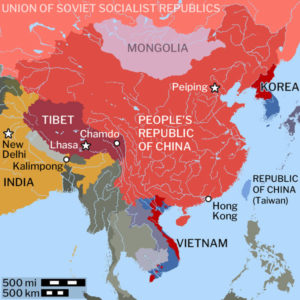 Oct 7: Rumors persist that Communist China’s Army has entered Tibet. Traders in the northwestern Bengal city of Kalimpong say that trade has been interrupted between the town and parts of eastern Tibet due to the Chinese Army’s presence at Chamdo (Qamdo). But the Tibetan Finance Minister Tsepon Shakabpa, who heads the Tibetan Mission in New Dehli that is negotiating with the Ambassador from Peiping (Beijing), says that he knows nothing about the Chinese Army’s presence in Tibet.
Oct 7: Rumors persist that Communist China’s Army has entered Tibet. Traders in the northwestern Bengal city of Kalimpong say that trade has been interrupted between the town and parts of eastern Tibet due to the Chinese Army’s presence at Chamdo (Qamdo). But the Tibetan Finance Minister Tsepon Shakabpa, who heads the Tibetan Mission in New Dehli that is negotiating with the Ambassador from Peiping (Beijing), says that he knows nothing about the Chinese Army’s presence in Tibet.
▲Sunday, October 8
![]() Oct 8: Defense Department releases its largest daily casualty list of the Korean War so far. Listed are the names of the dead, injured, missing, or captured American soldiers whose families have been notified since the previous list was released. Today’s list is 1,211 names long, representing service members from every state in the union and the District of Columbia. The numbers are grim: 255 killed, 822 wounded in action, 73 missing, 48 injured away from the lines, and 13 captured as prisoners of war.
Oct 8: Defense Department releases its largest daily casualty list of the Korean War so far. Listed are the names of the dead, injured, missing, or captured American soldiers whose families have been notified since the previous list was released. Today’s list is 1,211 names long, representing service members from every state in the union and the District of Columbia. The numbers are grim: 255 killed, 822 wounded in action, 73 missing, 48 injured away from the lines, and 13 captured as prisoners of war.
![]()
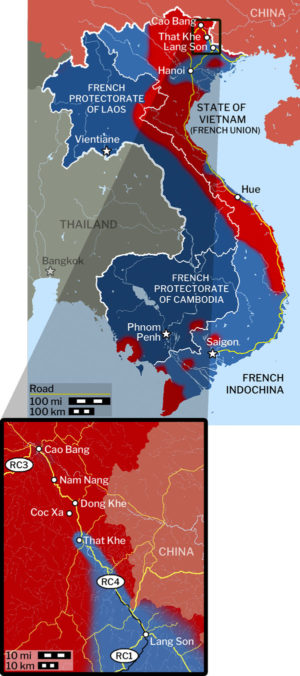 Oct 8: Vietnam, Battle of RC4: Entire French airborne battalion lost in action. The hellish Battle of Route Coloniale 4 in the French Indochina State of Vietnam enters its second week. The night before, a skeletal company of 270 paratroopers of the 3rd Colonial Commando Parachute Battalion (3e BCCP) and 130 Legionaries recently arrived from Algiers drop into That Khe. Their mission is to go out and try to rescue the straggling survivors of the RC4 disaster. Most of those rescued are picked up on RC4 just a few kilometers to the north. But over the next two days, only twenty-nine members of the French Foreign Legion’s First Paratrooper Battalion (1er BEP) reach safety. Just a week earlier, the 1er BEP counted five hundred men. This is the first time an entire French airborne battalion was ever lost in action. The 3rd Infantry (3e REI), whose evacuation from Cao Bang was the whole point of the operation, is similarly decimated. Only thirty-two return. Altogether, out of the 6,000 troops who began in mission on October 1, only about 700 make it to French lines. Incredibly, the disaster is still barely half over.
Oct 8: Vietnam, Battle of RC4: Entire French airborne battalion lost in action. The hellish Battle of Route Coloniale 4 in the French Indochina State of Vietnam enters its second week. The night before, a skeletal company of 270 paratroopers of the 3rd Colonial Commando Parachute Battalion (3e BCCP) and 130 Legionaries recently arrived from Algiers drop into That Khe. Their mission is to go out and try to rescue the straggling survivors of the RC4 disaster. Most of those rescued are picked up on RC4 just a few kilometers to the north. But over the next two days, only twenty-nine members of the French Foreign Legion’s First Paratrooper Battalion (1er BEP) reach safety. Just a week earlier, the 1er BEP counted five hundred men. This is the first time an entire French airborne battalion was ever lost in action. The 3rd Infantry (3e REI), whose evacuation from Cao Bang was the whole point of the operation, is similarly decimated. Only thirty-two return. Altogether, out of the 6,000 troops who began in mission on October 1, only about 700 make it to French lines. Incredibly, the disaster is still barely half over.
▲Monday, October 9
Thanksgiving Day (Canada)
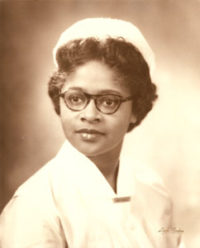 Oct 9: Supreme Court clears the way for integrating Maryland School of Nursing. The U.S. Supreme Court declines to hear an appeal by the University of Maryland, which has sought to overturn a Maryland Court of Appeals decision last April compelling the university to admit an African-American applicant to the School of Nursing at the University’s all-white campus at College Park. To keep the campus white, Maryland had entered into a compact with ten other Southern states in which they agreed to accept each others Negro students in cases where a particular study discipline isn’t offered in the students’ home state. Maryland had offered to send Esther McCready to Meharry Medical College in Nashville, Tennessee, because there are no nursing schools available for black students in Maryland. McCready’s attorneys (future Supreme Court Justice Thurgood Marshall is one of them) argued that Maryland has a “clear and constitutional obligation” to admit her to the university in her own state. Maryland’s highest court agreed, and the U.S. Supreme Court declined to review the case. This is in line with the Supreme Court’s June ruling that compels state all-white public colleges and universities to admit African-American students if the state does not provide equal facilities in black colleges for the students’ preferred course of study. McCready had already started classes at College Park on September 5th pending the Supreme Court’s decision on whether it would review the case.
Oct 9: Supreme Court clears the way for integrating Maryland School of Nursing. The U.S. Supreme Court declines to hear an appeal by the University of Maryland, which has sought to overturn a Maryland Court of Appeals decision last April compelling the university to admit an African-American applicant to the School of Nursing at the University’s all-white campus at College Park. To keep the campus white, Maryland had entered into a compact with ten other Southern states in which they agreed to accept each others Negro students in cases where a particular study discipline isn’t offered in the students’ home state. Maryland had offered to send Esther McCready to Meharry Medical College in Nashville, Tennessee, because there are no nursing schools available for black students in Maryland. McCready’s attorneys (future Supreme Court Justice Thurgood Marshall is one of them) argued that Maryland has a “clear and constitutional obligation” to admit her to the university in her own state. Maryland’s highest court agreed, and the U.S. Supreme Court declined to review the case. This is in line with the Supreme Court’s June ruling that compels state all-white public colleges and universities to admit African-American students if the state does not provide equal facilities in black colleges for the students’ preferred course of study. McCready had already started classes at College Park on September 5th pending the Supreme Court’s decision on whether it would review the case.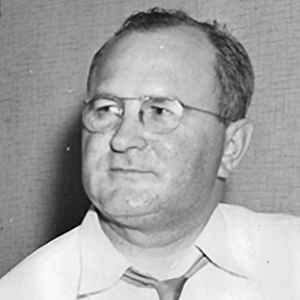 Oct 9: Georgia power broker says integration will mean “a lot of Negroes hurt, and hurt bad.” Georgia’s political kingmaker, former House Speaker Roy Harris, runs another editorial in his closely-watched weekly Augusta newspaper The Courier in which he lambasts efforts by two hundred Atlanta African-American parents to desegregate the city’s public schools. Harris ups his rhetoric from last week when he warned that a lawsuit filed by parents of Atlanta African-American students would lead Georgians to dismantle public education in the state altogether. This week, Harris warns that “if that day (when a court orders desegregation) ever comes we will have bloodshed, race riots, a race war and the most terrible time this state has ever known. If this ever happens, there are going to be a lot of Negroes hurt, and hurt bad, in Georgia.” He also repeats his suggestion that Georgia should abandon plans to “equalize” Negro schools in the state. “If they are not willing to live in a state of segregation and attend segregated schools, then the white people should and must make other plans and let the Negroes scout for themselves. … The issue of segregation of the races means more to Georgia people than anything else. Segregation has been sacred with the decent white people of the South always, and it always will be sacred to the decent white people of Georgia.”
Oct 9: Georgia power broker says integration will mean “a lot of Negroes hurt, and hurt bad.” Georgia’s political kingmaker, former House Speaker Roy Harris, runs another editorial in his closely-watched weekly Augusta newspaper The Courier in which he lambasts efforts by two hundred Atlanta African-American parents to desegregate the city’s public schools. Harris ups his rhetoric from last week when he warned that a lawsuit filed by parents of Atlanta African-American students would lead Georgians to dismantle public education in the state altogether. This week, Harris warns that “if that day (when a court orders desegregation) ever comes we will have bloodshed, race riots, a race war and the most terrible time this state has ever known. If this ever happens, there are going to be a lot of Negroes hurt, and hurt bad, in Georgia.” He also repeats his suggestion that Georgia should abandon plans to “equalize” Negro schools in the state. “If they are not willing to live in a state of segregation and attend segregated schools, then the white people should and must make other plans and let the Negroes scout for themselves. … The issue of segregation of the races means more to Georgia people than anything else. Segregation has been sacred with the decent white people of the South always, and it always will be sacred to the decent white people of Georgia.” Oct 9: St. Louis hotel refuses admittance to black convention attendees. The Congress of Correction, a national organization of penal officers, says that it will no longer hold conventions in cities where hotels practice racial segregation. The issue came to the for during the annual meeting held this year at the Statler Hotel in St. Louis, Missouri. The famously luxurious hotel has denied accommodations to three Negro delegates to the convention. Walter Gordon, chairman of the California Adult Authority, his wife, and H.C. McCormick, superintendent of a Negro boys school in Boley, Oklahoma, were all denied rooms by the Statler’s manager. Gordon, a former star football player for the University of California, sat with his wife in the hotel lobby for six hours before finally leaving the city, convention officials say. Donald Mumford, the Statler’s, defends his hotel’s policy and says that he offered to arrange housing at a Negro hotel for the three. The Congress’s new policy for selecting host hotels for future meetings won’t take effect until 1952 however; they’ve already signed contracts to hold next year’s meeting in Biloxi, Mississippi.
Oct 9: St. Louis hotel refuses admittance to black convention attendees. The Congress of Correction, a national organization of penal officers, says that it will no longer hold conventions in cities where hotels practice racial segregation. The issue came to the for during the annual meeting held this year at the Statler Hotel in St. Louis, Missouri. The famously luxurious hotel has denied accommodations to three Negro delegates to the convention. Walter Gordon, chairman of the California Adult Authority, his wife, and H.C. McCormick, superintendent of a Negro boys school in Boley, Oklahoma, were all denied rooms by the Statler’s manager. Gordon, a former star football player for the University of California, sat with his wife in the hotel lobby for six hours before finally leaving the city, convention officials say. Donald Mumford, the Statler’s, defends his hotel’s policy and says that he offered to arrange housing at a Negro hotel for the three. The Congress’s new policy for selecting host hotels for future meetings won’t take effect until 1952 however; they’ve already signed contracts to hold next year’s meeting in Biloxi, Mississippi. Oct 9: Home of South Carolina federal judge vandalized. The Charleston, South Carolina, home of Federal District Judge J. Waties Waring and his wife, who are both severe critics of segregation in the South, is targeted by vandals. Judge waring says that a window pane and a screen door in the front of the house has been smashed by bricks. Judge Waring says that the attack followed a number of “mysterious telephone calls received the last few days.”. The judge asserts, “You can expect this sort of thing in South Carolina. It’s a state dominated by the Klan. A crime committing Klan that goes unpunished.” The FBI is called to investigate after the Warings barred Charleston police detectives from entering the home. Says Judge Waring, “I prefer to have the federal officers investigate because evidently the attack is upon me as a federal judge.” Judge Waring ruled in 1948 that Negro voters must be allowed to participate in the Democratic primary. Like elsewhere in the South, South Carolina is essentially a one-party state where Democratic primary winners are virtually guaranteed to prevail in the general election. A cross was burned in front of the Waring home in March.
Oct 9: Home of South Carolina federal judge vandalized. The Charleston, South Carolina, home of Federal District Judge J. Waties Waring and his wife, who are both severe critics of segregation in the South, is targeted by vandals. Judge waring says that a window pane and a screen door in the front of the house has been smashed by bricks. Judge Waring says that the attack followed a number of “mysterious telephone calls received the last few days.”. The judge asserts, “You can expect this sort of thing in South Carolina. It’s a state dominated by the Klan. A crime committing Klan that goes unpunished.” The FBI is called to investigate after the Warings barred Charleston police detectives from entering the home. Says Judge Waring, “I prefer to have the federal officers investigate because evidently the attack is upon me as a federal judge.” Judge Waring ruled in 1948 that Negro voters must be allowed to participate in the Democratic primary. Like elsewhere in the South, South Carolina is essentially a one-party state where Democratic primary winners are virtually guaranteed to prevail in the general election. A cross was burned in front of the Waring home in March.![]() Oct 9: Korean War: MacArthur calls on North Korea to surrender “for the last time.”. Douglas MacArthur, supreme commander of United Nations forces in Korea, issues a call “for the last time” for North Koreans “forthwith to lay down your arms and cease hostilities.” MacArthur says that unless the North Korean government complies immediately, “I shall at once proceed to take such military action as may be necessary.” MacArthur releases the ultimatum at 10:00 a.m., and it is immediately broadcast to North Korea via radio stations in Seoul and Japan.
Oct 9: Korean War: MacArthur calls on North Korea to surrender “for the last time.”. Douglas MacArthur, supreme commander of United Nations forces in Korea, issues a call “for the last time” for North Koreans “forthwith to lay down your arms and cease hostilities.” MacArthur says that unless the North Korean government complies immediately, “I shall at once proceed to take such military action as may be necessary.” MacArthur releases the ultimatum at 10:00 a.m., and it is immediately broadcast to North Korea via radio stations in Seoul and Japan.
![]()
 Oct 9: Korean War: ROK forces stalled at Iron Triangle. In central Korea, the ROK 6th Division, which has taken Hwachon (Hwacheon) the day before, continues to meet strong resistance as it tries to move northward to the eastern corner of the Iron Triangle at Kumhwa (some press reports call the town Kimhwa, which is present-day Gimhwa-eup). Similarly, the ROK 8th Division makes little headway as it tries to move northward to Chorwon (Cheorwon), in the Triangle’s west corner after having crossed the Parallel two days ago.
Oct 9: Korean War: ROK forces stalled at Iron Triangle. In central Korea, the ROK 6th Division, which has taken Hwachon (Hwacheon) the day before, continues to meet strong resistance as it tries to move northward to the eastern corner of the Iron Triangle at Kumhwa (some press reports call the town Kimhwa, which is present-day Gimhwa-eup). Similarly, the ROK 8th Division makes little headway as it tries to move northward to Chorwon (Cheorwon), in the Triangle’s west corner after having crossed the Parallel two days ago.
![]() Oct 9: Korean War: South Koreans face heaving fighting at Wonsan. Two Republic of Korea (ROK) divisions — the 3rd and Capital — are at the southern edge of Wonsan, 110 miles (175 km) north of the Thirty-Eight Parallel, where they are engaged in fierce fighting against a determined enemy defending the important port city.
Oct 9: Korean War: South Koreans face heaving fighting at Wonsan. Two Republic of Korea (ROK) divisions — the 3rd and Capital — are at the southern edge of Wonsan, 110 miles (175 km) north of the Thirty-Eight Parallel, where they are engaged in fierce fighting against a determined enemy defending the important port city.
![]() Oct 9: Korean War: American forces prepare to cross the 38th Parallel. To the west, the U.S. 1st Cavalry Division begins pushing in force across the Parallel north of Kaesong. Progress in the division center along the main highways is slowed, with the road heavily mined. To the east, the U.S. 4th Cavalry Regiment moves up from Kaesong to the Parallel, and will cross the line the next day. West of Kaesong, the 7th Cavalry Regiment launches three hours of heavy artillery fire on the west bank of the Yesong River (Ryesong River) at the railroad bridge. That afternoon, they cross the bridge under cover of the barrage and seize the bridge’s western approaches and the hills flanking it. The bridge, though damaged, remains intact, and the engineering battalion will spend the night repairing it while under constant enemy fire. Mopping up operations continue in South Korea, where some 10,000 trapped North Korean soldiers have been captured in the past two days. This brings the total number of North Korean POWs held by U.N. forces to 50,000 — equivalent to five of the thirteen divisions the North had deployed at the Pusan Perimeter a month ago.
Oct 9: Korean War: American forces prepare to cross the 38th Parallel. To the west, the U.S. 1st Cavalry Division begins pushing in force across the Parallel north of Kaesong. Progress in the division center along the main highways is slowed, with the road heavily mined. To the east, the U.S. 4th Cavalry Regiment moves up from Kaesong to the Parallel, and will cross the line the next day. West of Kaesong, the 7th Cavalry Regiment launches three hours of heavy artillery fire on the west bank of the Yesong River (Ryesong River) at the railroad bridge. That afternoon, they cross the bridge under cover of the barrage and seize the bridge’s western approaches and the hills flanking it. The bridge, though damaged, remains intact, and the engineering battalion will spend the night repairing it while under constant enemy fire. Mopping up operations continue in South Korea, where some 10,000 trapped North Korean soldiers have been captured in the past two days. This brings the total number of North Korean POWs held by U.N. forces to 50,000 — equivalent to five of the thirteen divisions the North had deployed at the Pusan Perimeter a month ago.
![]() Oct 9: Vietnam, Battle of RC4: French Command reveals catastrophe. The French High Command in Saigon, capital of the French Indochina State of Vietnam, finally reveals the stinging defeat of French forces during the ill-fated evacuation of Cao Bang. The spokesman says fighting raged “foot by foot and rock by rock.” He doesn’t reveal casualty figures, but acknowledges that only a few hundred have escaped. “The remainder, encircled and attacked form all sides, succumbed after a bloody battle, but only after inflicting extremely heavy losses on the enemy.” He says that the Viet Minh victory was made easier “by the proximity of the Chinese frontier, if it is possible to speak of a frontier for the Viet Minh” and that “the Viet Minh has been well schooled” in training camps in China. “It should be emphasized that, for the first time, we have had to deal with a perfectly armed and equipped enemy, using an excellent radio transmission network and knowing how to coordinate his actions.” Vietnamese Permier Tran Van Huu, who has shown little interest in governing his quasi-independent state, finally ends his three-and-a-half-month holiday in Paris and flies back to Saigon. Vietnam’s President, former emperor Bao Dai, is less interested in events back home and remains at his posh vacation home on the French Riviera. Thanks to the President’s and Permier’s absences, Vietnam’s French-supported government has virtually ceased to function at the ministerial level. The French Cabinet, meeting in an emergency session, dispatches Colonial Minister Jean Le Tourneau and Gen. Alphonse Juin to Saigon to “take all dispositions necessary” to bolster French defenses.
Oct 9: Vietnam, Battle of RC4: French Command reveals catastrophe. The French High Command in Saigon, capital of the French Indochina State of Vietnam, finally reveals the stinging defeat of French forces during the ill-fated evacuation of Cao Bang. The spokesman says fighting raged “foot by foot and rock by rock.” He doesn’t reveal casualty figures, but acknowledges that only a few hundred have escaped. “The remainder, encircled and attacked form all sides, succumbed after a bloody battle, but only after inflicting extremely heavy losses on the enemy.” He says that the Viet Minh victory was made easier “by the proximity of the Chinese frontier, if it is possible to speak of a frontier for the Viet Minh” and that “the Viet Minh has been well schooled” in training camps in China. “It should be emphasized that, for the first time, we have had to deal with a perfectly armed and equipped enemy, using an excellent radio transmission network and knowing how to coordinate his actions.” Vietnamese Permier Tran Van Huu, who has shown little interest in governing his quasi-independent state, finally ends his three-and-a-half-month holiday in Paris and flies back to Saigon. Vietnam’s President, former emperor Bao Dai, is less interested in events back home and remains at his posh vacation home on the French Riviera. Thanks to the President’s and Permier’s absences, Vietnam’s French-supported government has virtually ceased to function at the ministerial level. The French Cabinet, meeting in an emergency session, dispatches Colonial Minister Jean Le Tourneau and Gen. Alphonse Juin to Saigon to “take all dispositions necessary” to bolster French defenses.
▲Tuesday, October 10
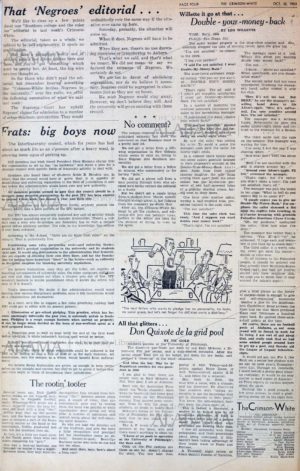 Oct 10:University of Alabama pro-integration editorial receives surprisingly little backlash. The surprising editorial published a week ago in the University of Alabama’s Crimson-White didn’t make nearly as much stir as might be expected. The editorial, which called on Alabamans to prepare themselves to accept the integration of the state’s colleges and universities. “Like it or not, we might as well get ready,” wrote acting editor Sam Harvey. While the wire services picked up the unexpected editorial, Alabamans, at least publicly, have maintained a studied silence. The Montgomery Advertiser, when it finally gets around to commenting ever so briefly, dismisses it as the work of a “puerule student … playing with racial fire and swallowing non-segregation.” But university officials have refused to comment, andhe state’s other newspapers generally remained silent. Even the Crimson-White grumbled, “Bamiams must be a pretty lazy lot. … We didn’t get a single letter from a student here.” But there must have been a few difficult private conversations, because the Crimson-White has come out another editorial “to clear up a few points.” “We did not mean or say we favored the entrance of Negroes. We certainly do not. We are not in favor of abolishing segregation, nor do we believe it necessary. Negroes could be segregated in classrooms just as they are on buses. We wish Negroes would stay away. However, we don’t believe they will. And the university will go on existing with them around.” The University of Alabama won’t enroll its first African-American students until 1963.
Oct 10:University of Alabama pro-integration editorial receives surprisingly little backlash. The surprising editorial published a week ago in the University of Alabama’s Crimson-White didn’t make nearly as much stir as might be expected. The editorial, which called on Alabamans to prepare themselves to accept the integration of the state’s colleges and universities. “Like it or not, we might as well get ready,” wrote acting editor Sam Harvey. While the wire services picked up the unexpected editorial, Alabamans, at least publicly, have maintained a studied silence. The Montgomery Advertiser, when it finally gets around to commenting ever so briefly, dismisses it as the work of a “puerule student … playing with racial fire and swallowing non-segregation.” But university officials have refused to comment, andhe state’s other newspapers generally remained silent. Even the Crimson-White grumbled, “Bamiams must be a pretty lazy lot. … We didn’t get a single letter from a student here.” But there must have been a few difficult private conversations, because the Crimson-White has come out another editorial “to clear up a few points.” “We did not mean or say we favored the entrance of Negroes. We certainly do not. We are not in favor of abolishing segregation, nor do we believe it necessary. Negroes could be segregated in classrooms just as they are on buses. We wish Negroes would stay away. However, we don’t believe they will. And the university will go on existing with them around.” The University of Alabama won’t enroll its first African-American students until 1963.![]() Oct 10: Korean War: Kim Il Sung rejects MacArthur’s surrender demand. As expected, North Korean Premier Kim Il Sung rejects Gen. Douglas MacArthur’s demand that the North Korean troops lay down their arms and end hostilities. A Pyongyang radio broadcast says that Kim acknowledges that “a grave crisis faced the motherland,” but he has instead ordered his Korean People’s Army to fight to the end. In Washington, President Truman announces that he will meet with Gen. Douglas MacArthur at an undisclosed location in the Pacific over the weekend to discuss “the final phase of United Nations actions in Korea.”
Oct 10: Korean War: Kim Il Sung rejects MacArthur’s surrender demand. As expected, North Korean Premier Kim Il Sung rejects Gen. Douglas MacArthur’s demand that the North Korean troops lay down their arms and end hostilities. A Pyongyang radio broadcast says that Kim acknowledges that “a grave crisis faced the motherland,” but he has instead ordered his Korean People’s Army to fight to the end. In Washington, President Truman announces that he will meet with Gen. Douglas MacArthur at an undisclosed location in the Pacific over the weekend to discuss “the final phase of United Nations actions in Korea.”
![]()
 Oct 10: Korean War: South Koreans enter Wonsan, Iron Triangle. The South’s Republic of Korea (ROK) 3rd and Capital Divisions enter the port city of Wonsan. In order to settle rival claims as to which division entered the city first, the corps commander, Brig. Gen. Kim Baik Yil decrees that both divisions got there simultaneously at 6:00 a.m. and that both secured it at 10:00. In fact, Wonsan hasn’t been secure, and street fighting continues through the night as North Korean artillery rains down on the city from surrounding hills. In central Korea, the ROK 8th Division enters the Iron Triangle at Chorwon after a large North Korean force executes a fighting withdrawal.
Oct 10: Korean War: South Koreans enter Wonsan, Iron Triangle. The South’s Republic of Korea (ROK) 3rd and Capital Divisions enter the port city of Wonsan. In order to settle rival claims as to which division entered the city first, the corps commander, Brig. Gen. Kim Baik Yil decrees that both divisions got there simultaneously at 6:00 a.m. and that both secured it at 10:00. In fact, Wonsan hasn’t been secure, and street fighting continues through the night as North Korean artillery rains down on the city from surrounding hills. In central Korea, the ROK 8th Division enters the Iron Triangle at Chorwon after a large North Korean force executes a fighting withdrawal.
![]() Oct 10: Korean War: Americans slowly cross 38th Parallel. Stretched supply lines and a shortage of trucks slow the Americans’ advance across the Thirty-Eighth Parallel north of Kaesong. Most combat vehicles, including tanks on the front lines, are operating without knowing whether they will have enough fuel on hand to continue their attacks the next day. One batallion does make some headway though, seizing Paekchon (Paechon), a few miles west of the Yesong (Ryesong) River, along with the high ground north of town .
Oct 10: Korean War: Americans slowly cross 38th Parallel. Stretched supply lines and a shortage of trucks slow the Americans’ advance across the Thirty-Eighth Parallel north of Kaesong. Most combat vehicles, including tanks on the front lines, are operating without knowing whether they will have enough fuel on hand to continue their attacks the next day. One batallion does make some headway though, seizing Paekchon (Paechon), a few miles west of the Yesong (Ryesong) River, along with the high ground north of town .
![]()
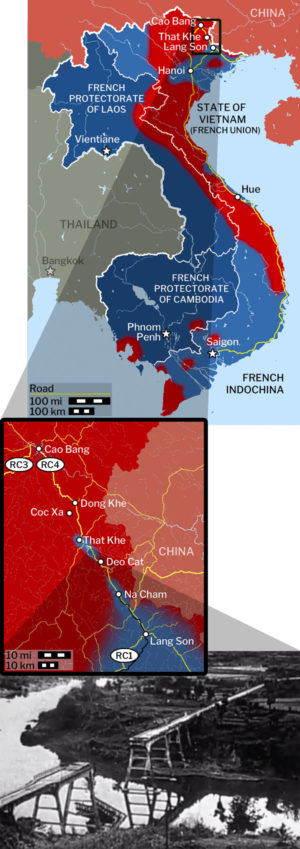 Oct 10: Vietnam, Battle of RC4: French commanders abrubtly order evacuation of entire highway. Just a few days ago, 270 paratroopers of the 3rd Colonial Commando Parachute Battalion (3e BCCP) and 130 Legionaries recently arrived from Algiers were dropped into That Khe. Since then, they have been going a few kilometers to the north on Route Coloniale 4, picking up survivors of the RC4 disaster as they emerge from the jungle. That task is abruptly halted when the French commander of the frontier zone headquartered in Lang Son orders a general evacuation along RC4 between That Khe and Na Cham, about 15 miles (25 km) to the south. The evacuation order soon expands to include Na Cham itself, with all personnel ordered to go straight to Long Son. This order, issued in an atmosphere of generalized panic among French military leaders at headquarters, effectively abandons unknown numbers of exhausted and starving French soldiers still trying to make their way to That Khe from the disaster at Coc Xa. It also triggers a chaotic withdrawal along French-controlled positions along RC4. That night at around midnight, as hundreds of French soldiers arrive at the Song Bac Khe River just south of That Khe, they find the bridge crossing the flooded river unguarded and destroyed. The 3e BCCP holds back while the rest of the French forces cross the river in makeshift rafts. By the time the last of the 3e BCCP-led groupement crosses, they discover that the garrisons at Deo Cat have already abandoned their posts in panic, leaving that stretch of RC4 in the hands of the Viet Minh. This will set up yet another disastrous fighting retreat, much like that suffered by the garrison from Cao Bang one week earlier, and with much the same results.
Oct 10: Vietnam, Battle of RC4: French commanders abrubtly order evacuation of entire highway. Just a few days ago, 270 paratroopers of the 3rd Colonial Commando Parachute Battalion (3e BCCP) and 130 Legionaries recently arrived from Algiers were dropped into That Khe. Since then, they have been going a few kilometers to the north on Route Coloniale 4, picking up survivors of the RC4 disaster as they emerge from the jungle. That task is abruptly halted when the French commander of the frontier zone headquartered in Lang Son orders a general evacuation along RC4 between That Khe and Na Cham, about 15 miles (25 km) to the south. The evacuation order soon expands to include Na Cham itself, with all personnel ordered to go straight to Long Son. This order, issued in an atmosphere of generalized panic among French military leaders at headquarters, effectively abandons unknown numbers of exhausted and starving French soldiers still trying to make their way to That Khe from the disaster at Coc Xa. It also triggers a chaotic withdrawal along French-controlled positions along RC4. That night at around midnight, as hundreds of French soldiers arrive at the Song Bac Khe River just south of That Khe, they find the bridge crossing the flooded river unguarded and destroyed. The 3e BCCP holds back while the rest of the French forces cross the river in makeshift rafts. By the time the last of the 3e BCCP-led groupement crosses, they discover that the garrisons at Deo Cat have already abandoned their posts in panic, leaving that stretch of RC4 in the hands of the Viet Minh. This will set up yet another disastrous fighting retreat, much like that suffered by the garrison from Cao Bang one week earlier, and with much the same results.
▲Wednesday, October 11
![]() Oct 11: Communist China threatens to intervene in Korea. The People’s Republic of China again warns that it may intervene in the Korean War. A Foreign Ministry statement read over Peiping (Beijing) radio says: “The American war of invasion in Korea has been a serious menace to the security of China from the very start. Now the American forces are attempting to cross the Thirty-eighth Parallel on a large scale. The Chinese people cannot stand by idly with regard to such a serious situation as is created by the invasion of Korea by the United States and its accomplice countries and to the dangerous trend toward extending the war.” This is the second such warning from China. On October 1, Premier Chou En-lai (Zhou Enlai) warned that his country “will not stand aside” if North Korea is invaded.
Oct 11: Communist China threatens to intervene in Korea. The People’s Republic of China again warns that it may intervene in the Korean War. A Foreign Ministry statement read over Peiping (Beijing) radio says: “The American war of invasion in Korea has been a serious menace to the security of China from the very start. Now the American forces are attempting to cross the Thirty-eighth Parallel on a large scale. The Chinese people cannot stand by idly with regard to such a serious situation as is created by the invasion of Korea by the United States and its accomplice countries and to the dangerous trend toward extending the war.” This is the second such warning from China. On October 1, Premier Chou En-lai (Zhou Enlai) warned that his country “will not stand aside” if North Korea is invaded.
![]()
 Oct 11: Korean war: South Koreans secure Wonsan city and airfield, move into Iron Triangle. The South’s Republic of Korea (ROK) 3rd Division secures the port city of Wonsan after battling enemy artillery, mortar and small arms for most of the day. By evening, the ROK has troops about a mile (1½ km) north of town. The airfield east of town becomes operational that evening and twenty-two cargo planes carrying 131 tons (120 metric tonnes) of supplies will arrive the next day. South of Wonsan, ROK forces are pushing inland and southward along the road that leads to the Iron Triangle. South of there, the ROK 8th and 7th Divisions converge on Pyonggang at the top of the Triangle. The 6th Division will arrive from Kumhwa two days later. This places all but one of the ROK’s divisions north of the Thirty-eighth Parallel before any American division completes a crossing.
Oct 11: Korean war: South Koreans secure Wonsan city and airfield, move into Iron Triangle. The South’s Republic of Korea (ROK) 3rd Division secures the port city of Wonsan after battling enemy artillery, mortar and small arms for most of the day. By evening, the ROK has troops about a mile (1½ km) north of town. The airfield east of town becomes operational that evening and twenty-two cargo planes carrying 131 tons (120 metric tonnes) of supplies will arrive the next day. South of Wonsan, ROK forces are pushing inland and southward along the road that leads to the Iron Triangle. South of there, the ROK 8th and 7th Divisions converge on Pyonggang at the top of the Triangle. The 6th Division will arrive from Kumhwa two days later. This places all but one of the ROK’s divisions north of the Thirty-eighth Parallel before any American division completes a crossing.
![]() Oct 11: Korean War: ROK, American forces push further across 38th Parallel. In the Kaesong area, major elements of the ROK 1st Division, the only ROK division still south of the Parallel, crosses the Imjin River at Korangpo-ri at down, and attacks on a secondary road toward the north and northwest. Later that day, the first American division will finally complete its crossing of the Parallel when the 3rd Battalion of the 7th Cavalry, 1st Cavalry Division attacks north from Paekchon (Paechon). It’s mission is to cut the North Koreans off at Hanpo-ri, on the main national highway and railroad line north of Kumchon, which it will do the following day.
Oct 11: Korean War: ROK, American forces push further across 38th Parallel. In the Kaesong area, major elements of the ROK 1st Division, the only ROK division still south of the Parallel, crosses the Imjin River at Korangpo-ri at down, and attacks on a secondary road toward the north and northwest. Later that day, the first American division will finally complete its crossing of the Parallel when the 3rd Battalion of the 7th Cavalry, 1st Cavalry Division attacks north from Paekchon (Paechon). It’s mission is to cut the North Koreans off at Hanpo-ri, on the main national highway and railroad line north of Kumchon, which it will do the following day.
![]() Oct 11: American Legion calls for Communist roundup. The American Legion, meeting at its annual convention in Los Angeles, approves resolutions calling for the immediate internment of all members of the Communist Party, and for putting them on trial as traitors or spies. Other resolutions, adopted unanimously, call for the dismissal of any government official allowing Communist activities in his department, the disbarment of National Lawyers Guild members “for following the (Communist) party line), and the peacetime application of the death penalty for treason, espionage and sabotage.
Oct 11: American Legion calls for Communist roundup. The American Legion, meeting at its annual convention in Los Angeles, approves resolutions calling for the immediate internment of all members of the Communist Party, and for putting them on trial as traitors or spies. Other resolutions, adopted unanimously, call for the dismissal of any government official allowing Communist activities in his department, the disbarment of National Lawyers Guild members “for following the (Communist) party line), and the peacetime application of the death penalty for treason, espionage and sabotage.
▲Thursday, October 12
Columbus Day (US)
![]() Oct 12: Korean War: Turkish troops arrive in Pusan. On 25 July, Turkey announced that it would send a brigade of 5,000 troops comprising three infantry battalions, an artillery battalion and auxiliary units, to fight under UN Command against North Korea. Turkey was the second country to answer the UN call, after the United States. Now the Turkish Brigade’s advance party has arrived in Pusan (Busan), and the main body will arrive five days later. The brigade will into bivouac near Taegu (Daegu) where it will undergo training and receive U.S. equipment to augment its weaponry. The brigade will be attached to the U.S. 25th Infantry Division. The Turks represent the fifth nation to send ground troops to Korea, joining the U.S., Britain, Australia and the Philippines.
Oct 12: Korean War: Turkish troops arrive in Pusan. On 25 July, Turkey announced that it would send a brigade of 5,000 troops comprising three infantry battalions, an artillery battalion and auxiliary units, to fight under UN Command against North Korea. Turkey was the second country to answer the UN call, after the United States. Now the Turkish Brigade’s advance party has arrived in Pusan (Busan), and the main body will arrive five days later. The brigade will into bivouac near Taegu (Daegu) where it will undergo training and receive U.S. equipment to augment its weaponry. The brigade will be attached to the U.S. 25th Infantry Division. The Turks represent the fifth nation to send ground troops to Korea, joining the U.S., Britain, Australia and the Philippines.
![]() Oct 12: Britain’s Conservatives rule out banning Communist Party. Britain’s Conservative Party opens its annual conference in Blackpool with a pledge to “employ every legitimate means to combat the insidious advance of communism.” One method that the 4,000 delegates quickly rule out is outlawing the Communist Party. Harold MacMillan says it would be a mistake to propose legislation that would effectively drive the Communist Party underground. He says that Communists are suffering from a disease for which “the best cure is the open air cure.” Last month, Britain’s Attorney General Sir Hartley Shawcross said that the Labour government will not introduce legislation to curb Communist activities.
Oct 12: Britain’s Conservatives rule out banning Communist Party. Britain’s Conservative Party opens its annual conference in Blackpool with a pledge to “employ every legitimate means to combat the insidious advance of communism.” One method that the 4,000 delegates quickly rule out is outlawing the Communist Party. Harold MacMillan says it would be a mistake to propose legislation that would effectively drive the Communist Party underground. He says that Communists are suffering from a disease for which “the best cure is the open air cure.” Last month, Britain’s Attorney General Sir Hartley Shawcross said that the Labour government will not introduce legislation to curb Communist activities.
![]()
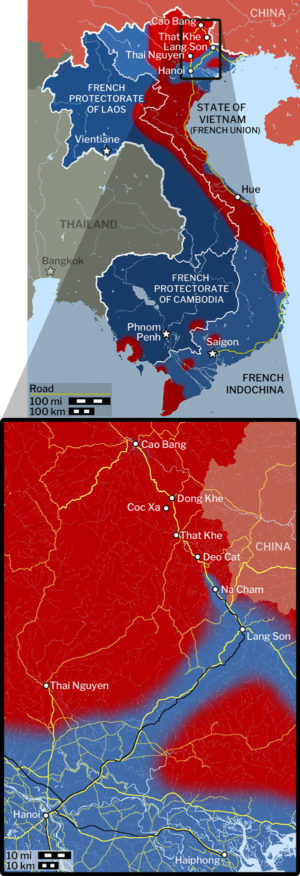 Oct 12: Vietnam, Battle of RC4: Second entire French unit wiped out; only 10% of entire French force survives. The French Army’s 3rd Colonial Commando Parachute Battalion (3e BCCP), which was ordered two days ago to evacuate That Khe for Na Cham has run into a buzz saw of Viet Minh resistance south of Deo Cat. Of the 400 who evacuated That Khe on October 10, half are now lost. What’s left splits up into small groups of a half dozen or so and leave RC4 for the jungles. Almost all of them will die over the next two days. The commander at Na Cham had ignored orders to evacuate, and instead waited for the paratroopers from That Khe to arrive. But only fourteen men will reach French positions, and the 3e BCCP becomes only the second French airborne battalion in history to be lost in action. The ill-fated First Paratrooper Battalion (1er BEP) was the the first on Sunday. Altogether, out of the more than 7,000 French and State of Vietnam soldiers committed to the battles of the past two weeks, only 700 return to French lines, and the French will never return to RC4 for the rest of its war in Indochina. The French High Command in Saigon is now in a state of full-blown panic. Gen. Marcel Carpentier, the commander in chief of French Indochina, orders an evacuation of Thai Nguyen, forty miles north of Hanoi. Thai Nguyen was taken by the French on October 1. With Viet Minh headquarters in the vicinity, the French entered Thai Nugyen in the hopes of creating a diversion for the planned evacuation from Cao Bang. But the Viet Minh refused to take the bait, and Thai Nguyen hasn’t been under any kind of a threat since then. The French communiqué justifies the withdrawal by saying that its objective of destroying Viet Minh military facilities in the area has been completed, and they can now withdraw to a defense line fifteen miles to the south “according to a prearranged plan.” French citizens in Hanoi worry that they will be abandoned to the Viet Minh, and many French firms there begin putting evacuation plans into action.
Oct 12: Vietnam, Battle of RC4: Second entire French unit wiped out; only 10% of entire French force survives. The French Army’s 3rd Colonial Commando Parachute Battalion (3e BCCP), which was ordered two days ago to evacuate That Khe for Na Cham has run into a buzz saw of Viet Minh resistance south of Deo Cat. Of the 400 who evacuated That Khe on October 10, half are now lost. What’s left splits up into small groups of a half dozen or so and leave RC4 for the jungles. Almost all of them will die over the next two days. The commander at Na Cham had ignored orders to evacuate, and instead waited for the paratroopers from That Khe to arrive. But only fourteen men will reach French positions, and the 3e BCCP becomes only the second French airborne battalion in history to be lost in action. The ill-fated First Paratrooper Battalion (1er BEP) was the the first on Sunday. Altogether, out of the more than 7,000 French and State of Vietnam soldiers committed to the battles of the past two weeks, only 700 return to French lines, and the French will never return to RC4 for the rest of its war in Indochina. The French High Command in Saigon is now in a state of full-blown panic. Gen. Marcel Carpentier, the commander in chief of French Indochina, orders an evacuation of Thai Nguyen, forty miles north of Hanoi. Thai Nguyen was taken by the French on October 1. With Viet Minh headquarters in the vicinity, the French entered Thai Nugyen in the hopes of creating a diversion for the planned evacuation from Cao Bang. But the Viet Minh refused to take the bait, and Thai Nguyen hasn’t been under any kind of a threat since then. The French communiqué justifies the withdrawal by saying that its objective of destroying Viet Minh military facilities in the area has been completed, and they can now withdraw to a defense line fifteen miles to the south “according to a prearranged plan.” French citizens in Hanoi worry that they will be abandoned to the Viet Minh, and many French firms there begin putting evacuation plans into action.
![]()
 Oct 12: FCC approves mechanical color television system. The Federal Communications Commission approves CBS’s method for transmitting color television. CBS’s method is an odd Rube Goldberg contraption of a system, relying on a disc of translucent color filters rotating at 1440 rpm inside the camera, capturing red, green and blue images in sequence as the filters spin behind the lens. On the television side, there is a similar color wheel in front of the TV screen, precisely synchronized with the camera’s wheel, which displays red, green and blue images at the rate of 24 frames per second. But because of color system requires so much more bandwidth, the image resolution is reduced by 23% vertically and 46% horizontally. This means that television sets sold already won’t receive the CBS signal without a cumbersome adapter/converter. A 19-inch set would require an unsightly spinning disk setup three feet in diameter. The decision satisfies no one, except CBS. The public is angry that their expensive new TV sets (even the cheapest tabletop models start at about $200, or more than $2,100 today) will soon become worthless without costly modifications or adapters. Those adaptor/converters will likely cost another $100 or more (about $1,050 today). Retailers are worried that TV sales will collapse unless customers are confident that their new TV’s will not go obsolete anytime soon. And television manufacturers say they won’t make the sets for such an impractical system. They call for an all-electronic system that would be backwards-compatible with current black & white televisions, similar to the system being developed by RCA. Ross D. Siruagusa, president of Admiral TV, predicts the CBS color system will “bumble along for a few months” before becoming “completely obsolete.” CEOs of Zenith, General Electric, Crosley, Philco, Motorola, and, of course, RCA, reject outright the manufacturing of color TV’s under CBS’s system. But the FCC rejects the RCA system, saying that it has, so far, inferior picture quality and is not sufficiently developed for deployment. CBS is authorized to begin color broadcasts on November 20, but network officials say they might not offer regular color programming until mid-December.
Oct 12: FCC approves mechanical color television system. The Federal Communications Commission approves CBS’s method for transmitting color television. CBS’s method is an odd Rube Goldberg contraption of a system, relying on a disc of translucent color filters rotating at 1440 rpm inside the camera, capturing red, green and blue images in sequence as the filters spin behind the lens. On the television side, there is a similar color wheel in front of the TV screen, precisely synchronized with the camera’s wheel, which displays red, green and blue images at the rate of 24 frames per second. But because of color system requires so much more bandwidth, the image resolution is reduced by 23% vertically and 46% horizontally. This means that television sets sold already won’t receive the CBS signal without a cumbersome adapter/converter. A 19-inch set would require an unsightly spinning disk setup three feet in diameter. The decision satisfies no one, except CBS. The public is angry that their expensive new TV sets (even the cheapest tabletop models start at about $200, or more than $2,100 today) will soon become worthless without costly modifications or adapters. Those adaptor/converters will likely cost another $100 or more (about $1,050 today). Retailers are worried that TV sales will collapse unless customers are confident that their new TV’s will not go obsolete anytime soon. And television manufacturers say they won’t make the sets for such an impractical system. They call for an all-electronic system that would be backwards-compatible with current black & white televisions, similar to the system being developed by RCA. Ross D. Siruagusa, president of Admiral TV, predicts the CBS color system will “bumble along for a few months” before becoming “completely obsolete.” CEOs of Zenith, General Electric, Crosley, Philco, Motorola, and, of course, RCA, reject outright the manufacturing of color TV’s under CBS’s system. But the FCC rejects the RCA system, saying that it has, so far, inferior picture quality and is not sufficiently developed for deployment. CBS is authorized to begin color broadcasts on November 20, but network officials say they might not offer regular color programming until mid-December.
![]()
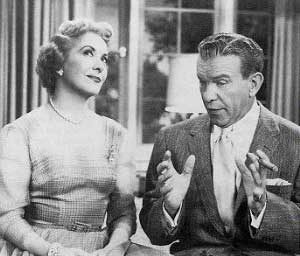 Oct 12: George Burns program transitions to television. The George Burns and Gracie Allen Show premieres on CBS, after running on radio for 13 years. The New York Times says the transition appears effortless. “This observation, no doubt, attests to how hard they and their production assistants have labored to make the change.” The program pokes fun at being on television by using a jumbled set that breaks the “fourth wall” while Burns looks at the audience and makes wry comments between scenes. George plays the straight man to his wife, Gracie, and the two together more or less play themselves, with plots often centered on their plans for their radio and television show. Gracie’s the star of the show, a ditzy, naive, and lovable character who regularly blurts out whatever enters her head. Burns says, in one of his asides to the home audience, “If she made sense I’d still be selling ties.” The show will run until 1958. (You can see the original premiere episode online here.)
Oct 12: George Burns program transitions to television. The George Burns and Gracie Allen Show premieres on CBS, after running on radio for 13 years. The New York Times says the transition appears effortless. “This observation, no doubt, attests to how hard they and their production assistants have labored to make the change.” The program pokes fun at being on television by using a jumbled set that breaks the “fourth wall” while Burns looks at the audience and makes wry comments between scenes. George plays the straight man to his wife, Gracie, and the two together more or less play themselves, with plots often centered on their plans for their radio and television show. Gracie’s the star of the show, a ditzy, naive, and lovable character who regularly blurts out whatever enters her head. Burns says, in one of his asides to the home audience, “If she made sense I’d still be selling ties.” The show will run until 1958. (You can see the original premiere episode online here.)
▲Friday, October 13
![]()
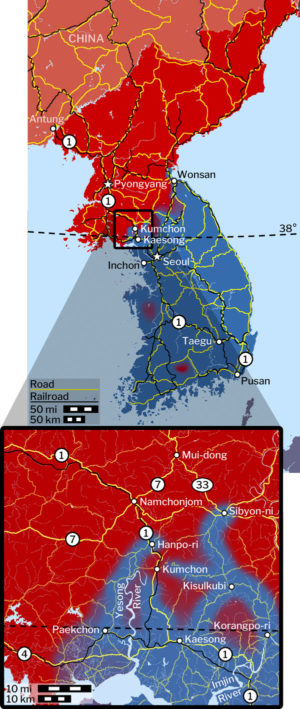 Oct 13: Korean War: Americans and South Koreans make progress in the Kumchon Pocket. Heavy fighting continues at the Kumchon Pocket, where the North’s Korean People’s Army (KPA) is stubbornly blocking American and South Korean advancement toward the North Korean capital of Pyongyang. The South’s Republic of Korea (ROK) 1st Division, which crossed the Thrity-eighth Parallel from Korangpo-ri two days ago, has met up with the U.S. 5th Cavalry Regiment at the tiny hamlet of Kisulkubi. From there, the ROK 1st advances northward and takes Sibyon-ni, while the 5th Cavalry Regiment turns west toward Kumchon, where it encounters a heavy minefield planted on the roadway and a strong enemy force waiting about eight miles (13 km) east of town. The 5th Cavalry overcomes these obstacles and advance elements begin entering Kumchon by nightfall. Meanwhile, the U.S. 8th Cavalry Regiment is fighting its way northward from Kaesong along the main national highway and railroad line, where it has been confronted with the heaviest KPA concentration in the Kumchon Pocket. The KPA puts up a stubborn resistance while trucks and carts evacuate an estimated thousand North Korean soldiers northward to Namchonjom. At Hanpo-ri, they encounter the 7th Cavalry Regiment which had raced around enemy lines and set up a roadblock the day before. In the ensuing action, the U.S. Cavalry, aided by air strikes, kill about half of the evacuating soldiers and take 201 prisoners. The rest escape into the hills northeast of town. The next morning the 5th Cavalry Regiment will resume its attack on Kumchon from the east and secure it by noon. The 5th Cavalary will then send one battalion north to Hanpo-ri and another one south on the main national highway to meet the 8th Cavalry, thereby closing both gaps. At the same time, the ROK 1st Division at Sibyon-ni will race northward and take Mui-dong by evening.
Oct 13: Korean War: Americans and South Koreans make progress in the Kumchon Pocket. Heavy fighting continues at the Kumchon Pocket, where the North’s Korean People’s Army (KPA) is stubbornly blocking American and South Korean advancement toward the North Korean capital of Pyongyang. The South’s Republic of Korea (ROK) 1st Division, which crossed the Thrity-eighth Parallel from Korangpo-ri two days ago, has met up with the U.S. 5th Cavalry Regiment at the tiny hamlet of Kisulkubi. From there, the ROK 1st advances northward and takes Sibyon-ni, while the 5th Cavalry Regiment turns west toward Kumchon, where it encounters a heavy minefield planted on the roadway and a strong enemy force waiting about eight miles (13 km) east of town. The 5th Cavalry overcomes these obstacles and advance elements begin entering Kumchon by nightfall. Meanwhile, the U.S. 8th Cavalry Regiment is fighting its way northward from Kaesong along the main national highway and railroad line, where it has been confronted with the heaviest KPA concentration in the Kumchon Pocket. The KPA puts up a stubborn resistance while trucks and carts evacuate an estimated thousand North Korean soldiers northward to Namchonjom. At Hanpo-ri, they encounter the 7th Cavalry Regiment which had raced around enemy lines and set up a roadblock the day before. In the ensuing action, the U.S. Cavalry, aided by air strikes, kill about half of the evacuating soldiers and take 201 prisoners. The rest escape into the hills northeast of town. The next morning the 5th Cavalry Regiment will resume its attack on Kumchon from the east and secure it by noon. The 5th Cavalary will then send one battalion north to Hanpo-ri and another one south on the main national highway to meet the 8th Cavalry, thereby closing both gaps. At the same time, the ROK 1st Division at Sibyon-ni will race northward and take Mui-dong by evening.
![]()
 Oct 13: All About Eve opens in theaters. Starring Bette Davis and Anne Baxter, and with a hilarious comic performance by an unknown Marilyn Monroe in one of her first major film appearances, the film is best remembered for Davis’s iconic line: “Fasten your seatbelts. It’s going to be a bumpy night.” All About Eve will earn fourteen Academy Award nominations, winning six, including one for Best Picture and one going to Joseph Mankiewicz for best director.
Oct 13: All About Eve opens in theaters. Starring Bette Davis and Anne Baxter, and with a hilarious comic performance by an unknown Marilyn Monroe in one of her first major film appearances, the film is best remembered for Davis’s iconic line: “Fasten your seatbelts. It’s going to be a bumpy night.” All About Eve will earn fourteen Academy Award nominations, winning six, including one for Best Picture and one going to Joseph Mankiewicz for best director.
▲Saturday, October 14
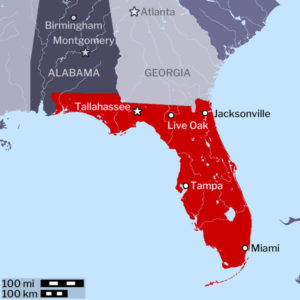 Oct 14: Klan rally held in Live Oak. Members of the Florida legislature were cordially invited to a Ku Klux Klan rally at the courthouse in Live Oak. Invitation cards sent to the legislators were signed by Bill Hendrix, Grand Dragon of the Original Southern Klans, Inc. The cards attacked the state welfare board as “one of the rottenest” boards in Florida for “promoting an illegitimate race of white and Negro children.” No legislators are observed at the Saturday night rally, which draws about a thousand spectators. Speaking from the Suwanee County courthouse steps, Hendrix denies that his organization is subversive, and tells the crowd that newspaper editors — he singles out the Tampa Tribune — write their anti-Klan editorials from behind “closed doors.” Pointing out that none of the Klan members attending the rally are masked, he asks who is really masked — the people who stand before him or the editors who attack him. Hendrix also denies that the Klan is anti-Semitic before denouncing B’nai B’rith, the Jewish Anti-Defamation League, as “probably one of the biggest spy rings for Communists in the United States.” He also attacks the Federal Council of Churches of Christ in America, which he says “preaches that American enterprise is no good.” But Hendrix saves his choicest words for the NAACP and the state welfare department. “The welfare scheme is Communistic,” he says,” turning the people against their officials and Negroes against white people.: He says he would not stand for “niggers sitting next to white children in Florida schools,” nor would he “sit next to niggers in a cafe.” Immediately after the courthouse rally, Hendrix leads a 73-car motorcade through the streets of Live Oak. Klansmen in the cars wear full regalia, but with their hoods pushed back to reveal their faces. Hendrix’s Klan outfit is one of 160 organizations that have been listed by the U.S. government as a subversive organization. Members of listed organizations, which include Communist and other far-left and far-right groups, are prohibited from inclusion in the armed forces, which is currently fighting in Korea under the auspices of the United Nations. Says Hamilton, “I warn you now to watch, and when the Stars and Stripes are pulled down and the U.N. flag placed above it, it is time for you to think.”
Oct 14: Klan rally held in Live Oak. Members of the Florida legislature were cordially invited to a Ku Klux Klan rally at the courthouse in Live Oak. Invitation cards sent to the legislators were signed by Bill Hendrix, Grand Dragon of the Original Southern Klans, Inc. The cards attacked the state welfare board as “one of the rottenest” boards in Florida for “promoting an illegitimate race of white and Negro children.” No legislators are observed at the Saturday night rally, which draws about a thousand spectators. Speaking from the Suwanee County courthouse steps, Hendrix denies that his organization is subversive, and tells the crowd that newspaper editors — he singles out the Tampa Tribune — write their anti-Klan editorials from behind “closed doors.” Pointing out that none of the Klan members attending the rally are masked, he asks who is really masked — the people who stand before him or the editors who attack him. Hendrix also denies that the Klan is anti-Semitic before denouncing B’nai B’rith, the Jewish Anti-Defamation League, as “probably one of the biggest spy rings for Communists in the United States.” He also attacks the Federal Council of Churches of Christ in America, which he says “preaches that American enterprise is no good.” But Hendrix saves his choicest words for the NAACP and the state welfare department. “The welfare scheme is Communistic,” he says,” turning the people against their officials and Negroes against white people.: He says he would not stand for “niggers sitting next to white children in Florida schools,” nor would he “sit next to niggers in a cafe.” Immediately after the courthouse rally, Hendrix leads a 73-car motorcade through the streets of Live Oak. Klansmen in the cars wear full regalia, but with their hoods pushed back to reveal their faces. Hendrix’s Klan outfit is one of 160 organizations that have been listed by the U.S. government as a subversive organization. Members of listed organizations, which include Communist and other far-left and far-right groups, are prohibited from inclusion in the armed forces, which is currently fighting in Korea under the auspices of the United Nations. Says Hamilton, “I warn you now to watch, and when the Stars and Stripes are pulled down and the U.N. flag placed above it, it is time for you to think.”![]()
 Oct 14: Cross burned at the home of a Black student applicant in Charleston. A small cross is burned in front of the Charleston, South Carolina, home of Hiram Bell, Jr., a black man who has been trying since February to gain admittance to Medical College of South Carolina in Charleston. Bell, a recent graduate of Lincoln Univeristy, remains unintimidated and presses again for admission to the state school. Police Detective Chief Herman Berkman denies that the Klan is involved, as police officials in the South almost always do. He calls the cross burning the work of “pranksters.”
Oct 14: Cross burned at the home of a Black student applicant in Charleston. A small cross is burned in front of the Charleston, South Carolina, home of Hiram Bell, Jr., a black man who has been trying since February to gain admittance to Medical College of South Carolina in Charleston. Bell, a recent graduate of Lincoln Univeristy, remains unintimidated and presses again for admission to the state school. Police Detective Chief Herman Berkman denies that the Klan is involved, as police officials in the South almost always do. He calls the cross burning the work of “pranksters.”
![]()
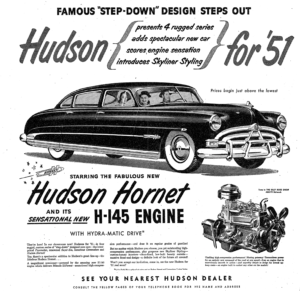 Oct 14: Hudson unveils the all new Hornet for 1951. The Hudson Motor Car Company unveils four models for 1951, including the all new Hudson Hornet. The Hornet features a functional “step-down” design with a dropped floor pan and a lighter-weight chassis. The resulting lower center of gravity and light weight provides exceptional handling for its day. It also gives it a lower, sleeker look that no other manufacturer can match. A high-compression, 145 horsepower straight-six engine, along with the better handling, makes it an instant stock car racing favorite. Famed NASCAR driver Marshall Teage will drive a Hornet, nicknamed the “Fabulous Hudson Hornet,” to win five of fifteen NASCAR Grand national races in 1951. Hornets will dominate NASCAR through 1954. Three other models join the Hornet to complete the Hudson lineup. They are Commodore Custom, the Super-Six Custom and the Pacemaker series. The GM-supplied four-speed Hydra-Matic Drive is available as an option for the Hornet and Commodore Custom. The lower-priced Super-Six and Pacemaker Custom series retain the older Super-Matic semi-automatic clutch and transmission as optional equipment. The new Hudson lineup will go on display at car dealerships across the country next Friday.
Oct 14: Hudson unveils the all new Hornet for 1951. The Hudson Motor Car Company unveils four models for 1951, including the all new Hudson Hornet. The Hornet features a functional “step-down” design with a dropped floor pan and a lighter-weight chassis. The resulting lower center of gravity and light weight provides exceptional handling for its day. It also gives it a lower, sleeker look that no other manufacturer can match. A high-compression, 145 horsepower straight-six engine, along with the better handling, makes it an instant stock car racing favorite. Famed NASCAR driver Marshall Teage will drive a Hornet, nicknamed the “Fabulous Hudson Hornet,” to win five of fifteen NASCAR Grand national races in 1951. Hornets will dominate NASCAR through 1954. Three other models join the Hornet to complete the Hudson lineup. They are Commodore Custom, the Super-Six Custom and the Pacemaker series. The GM-supplied four-speed Hydra-Matic Drive is available as an option for the Hornet and Commodore Custom. The lower-priced Super-Six and Pacemaker Custom series retain the older Super-Matic semi-automatic clutch and transmission as optional equipment. The new Hudson lineup will go on display at car dealerships across the country next Friday.
▲Sunday, October 15
![]()
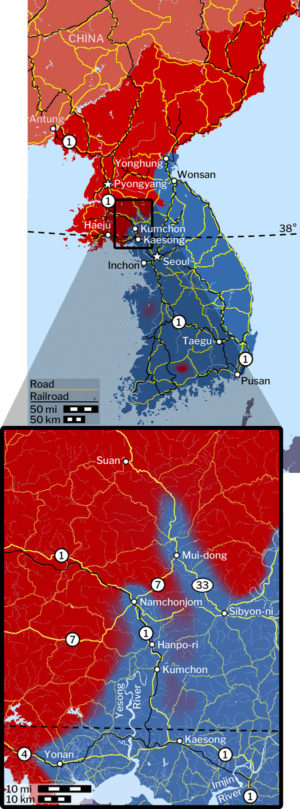 Oct 15: Korean War: South Koreans continue east coast drive; U.N. forces resume march to Pyongyang. On the east coast of North Korea, the South’s Republic of Korea (ROK) Capital Division seizes Yonhung and continues driving northward against light resistance. Other ROK divisions in central Korea push to the north and west toward Pyongyang. To the southwest, U.S. and ROK forces resume their march to the North Korean capital of Pyongyang. ROK forces to the east make impressive gains, and takes Mui-dong after making quick work of a regiment-sized force. After seizing Muid-dong, the ROK 1st Division continued pushing northward, reaching a point about ten miles (16 km) north of Miu-dong before stopping for the night. The following day, lead elements will enter Suan. Major Gen. Paik Sun Yup, commander of the ROK 1st Division, says that his tactics are simple: “No stop.” West of there, the U.S. 1st Cavalry Division marches from Hanpo-ri to Namchonjom, entering the town at noon following a long fight throughout the morning. North Korean prisoners say that the air force strafing attacks on Namchonjom that morning destroyed the KPA 19th Division’s command post and killed the division’s chief of staff. To the southwest, elements of the U.S. 24th Division enter Yonan. They will make rapid gains and take Haeju the next day.
Oct 15: Korean War: South Koreans continue east coast drive; U.N. forces resume march to Pyongyang. On the east coast of North Korea, the South’s Republic of Korea (ROK) Capital Division seizes Yonhung and continues driving northward against light resistance. Other ROK divisions in central Korea push to the north and west toward Pyongyang. To the southwest, U.S. and ROK forces resume their march to the North Korean capital of Pyongyang. ROK forces to the east make impressive gains, and takes Mui-dong after making quick work of a regiment-sized force. After seizing Muid-dong, the ROK 1st Division continued pushing northward, reaching a point about ten miles (16 km) north of Miu-dong before stopping for the night. The following day, lead elements will enter Suan. Major Gen. Paik Sun Yup, commander of the ROK 1st Division, says that his tactics are simple: “No stop.” West of there, the U.S. 1st Cavalry Division marches from Hanpo-ri to Namchonjom, entering the town at noon following a long fight throughout the morning. North Korean prisoners say that the air force strafing attacks on Namchonjom that morning destroyed the KPA 19th Division’s command post and killed the division’s chief of staff. To the southwest, elements of the U.S. 24th Division enter Yonan. They will make rapid gains and take Haeju the next day.
![]()
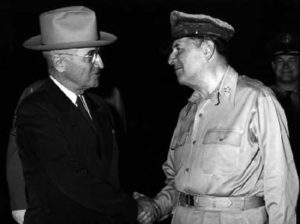 Oct 15: Truman and MacArthur meet at Wake Island. President Truman and Gen. MacArthur meet at Wake Island in the middle of the Pacific. The two talk privately for an hour upon Truman’s arrival in the morning, followed later by a larger conference with the president’s and the general’s advisers. The official purpose of the visit is to discuss the containment of Communism in Asia. Reporters however suspect that in the private meeting, the two likely discussed some very public disagreements that have arisen over the past few months. But Truman would only say that it was a “very pleasant and satisfactory meeting.”
Oct 15: Truman and MacArthur meet at Wake Island. President Truman and Gen. MacArthur meet at Wake Island in the middle of the Pacific. The two talk privately for an hour upon Truman’s arrival in the morning, followed later by a larger conference with the president’s and the general’s advisers. The official purpose of the visit is to discuss the containment of Communism in Asia. Reporters however suspect that in the private meeting, the two likely discussed some very public disagreements that have arisen over the past few months. But Truman would only say that it was a “very pleasant and satisfactory meeting.”
![]() Oct 15: East Germans vote in single-candidate elections. East German citizens go to the polls for the first general election since the founding of the German Democratic Republic the year before, to elect 400 deputies to the Volkskammer. There is only one candidate’s name on the Soviet-style ballot. Voters are given the option of voting yes or no, with the ballots pre-filled with a “yes” vote. Voters are rounded up and herded to polling stations, where they show their official identification papers to a police detective before being handed a ballot. The voter is then expected to walk directly to the ballot box and drop the ballot into the box. If the voter wants to vote against the candidate, he or she must walk, in full view of officials and the public, to one of two private booths to mark the ballot before dropping it in the box. Only 51,187 brave souls do this. The other 12,088,745 (99.6%) either support their official candidates or are too intimidated to vote otherwise. In some cities, voters are openly marched to the polls from neighborhoods, schools and factories. From early morning, East German radio exhorts everyone to get out to vote. An East German government official gives a veiled warning in one announcement: “You do not want it to be said of you that you were not at the polls, do you?” According to the official East German news agency, total voter turnout is 98.5% of all registered voters.
Oct 15: East Germans vote in single-candidate elections. East German citizens go to the polls for the first general election since the founding of the German Democratic Republic the year before, to elect 400 deputies to the Volkskammer. There is only one candidate’s name on the Soviet-style ballot. Voters are given the option of voting yes or no, with the ballots pre-filled with a “yes” vote. Voters are rounded up and herded to polling stations, where they show their official identification papers to a police detective before being handed a ballot. The voter is then expected to walk directly to the ballot box and drop the ballot into the box. If the voter wants to vote against the candidate, he or she must walk, in full view of officials and the public, to one of two private booths to mark the ballot before dropping it in the box. Only 51,187 brave souls do this. The other 12,088,745 (99.6%) either support their official candidates or are too intimidated to vote otherwise. In some cities, voters are openly marched to the polls from neighborhoods, schools and factories. From early morning, East German radio exhorts everyone to get out to vote. An East German government official gives a veiled warning in one announcement: “You do not want it to be said of you that you were not at the polls, do you?” According to the official East German news agency, total voter turnout is 98.5% of all registered voters.
▲Monday, October 16
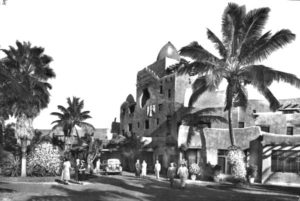 Oct 16: US Supreme Court orders reconsideration of public golf club’s segregation policy. The U.S. Supreme Court orders the Florida Supreme Court to reconsider its ruling that allows the city of Miami to only allow Negroes to play golf on a city-owned course only one day a week. Under Miami’s segregation rules, Negroes re only allowed to play at the Miami Springs Country Club on Monday only. The club is exclusively whites-only at all other times. The Supreme Court orders the Florida Supreme Court to direct “reconsideration in the light of” its June decision that gave two black students equal opportunities with whites at the Universities of Texas and Oklahoma. Under that decision, the Court ruled that if the “separate but equal” doctrine is to hold, public authorities must maintain truly equal facilities if they are to remain separate. The Florida Supreme Court will sit on the case for almost a year before reaffirming the segregation policy. The Florida Supreme Court will justify its move by saying that playing golf and seeking an education are two entirely different things. The Monday-only rule at Miami Springs will remain in place until 1957.
Oct 16: US Supreme Court orders reconsideration of public golf club’s segregation policy. The U.S. Supreme Court orders the Florida Supreme Court to reconsider its ruling that allows the city of Miami to only allow Negroes to play golf on a city-owned course only one day a week. Under Miami’s segregation rules, Negroes re only allowed to play at the Miami Springs Country Club on Monday only. The club is exclusively whites-only at all other times. The Supreme Court orders the Florida Supreme Court to direct “reconsideration in the light of” its June decision that gave two black students equal opportunities with whites at the Universities of Texas and Oklahoma. Under that decision, the Court ruled that if the “separate but equal” doctrine is to hold, public authorities must maintain truly equal facilities if they are to remain separate. The Florida Supreme Court will sit on the case for almost a year before reaffirming the segregation policy. The Florida Supreme Court will justify its move by saying that playing golf and seeking an education are two entirely different things. The Monday-only rule at Miami Springs will remain in place until 1957.▲Tuesday, October 17
![]()
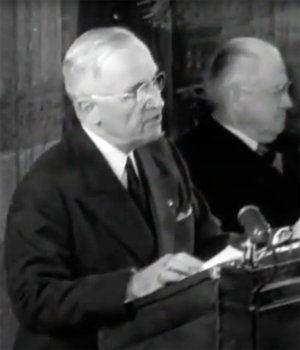 Oct 17: Truman gives nationwide radio address, vows to defeat Communist aggression. President Harry Truman gives a nationwide radio address from San Francisco after returning from Wake Island in the Pacific where he met with Gen. Douglas MacArthur. (National television appearances are not yet possible.) He declares that the U.S. will continue to use its strength to defeat Communist aggression, and he reiterated his commitment to work multilaterally with other nations. “I believe that my trip to Wake Island has given emphasis to the historic action taken by the United Nations in Korea. For Korea has been a symbol of united action against aggression.” He says the trip was necessary due to “a pressing need to make it perfectly clear that there was complete unanimity in the aims and conduct of our foreign policy in the Far East.” That explanation is apparently aimed at critics who have expressed their displeasure at the sometimes-contentious relationship, and the occasional public disagreements, between Truman and MacArthur. Truman lays out America’s aims in Korea this way: “Our sole purpose in Korea is to establish peace and independence. Our troops will stay there only so long as they are needed by the United Nations for that purpose. We seek no territory or special privilege. Let this be crystal clear to all — we have no aggressive designs in Korea or in any other place, in the Far East or elsewhere. … The only victory we seek is the victory of peace.” He contrasts this position with that of the Soviet Union. “If the Soviet Union really wants peace, it can prove it and could have proved it on any day since last June 25th by joining the rest of the United Nations in calling upon North Koreans to lay down their arms at once.”
Oct 17: Truman gives nationwide radio address, vows to defeat Communist aggression. President Harry Truman gives a nationwide radio address from San Francisco after returning from Wake Island in the Pacific where he met with Gen. Douglas MacArthur. (National television appearances are not yet possible.) He declares that the U.S. will continue to use its strength to defeat Communist aggression, and he reiterated his commitment to work multilaterally with other nations. “I believe that my trip to Wake Island has given emphasis to the historic action taken by the United Nations in Korea. For Korea has been a symbol of united action against aggression.” He says the trip was necessary due to “a pressing need to make it perfectly clear that there was complete unanimity in the aims and conduct of our foreign policy in the Far East.” That explanation is apparently aimed at critics who have expressed their displeasure at the sometimes-contentious relationship, and the occasional public disagreements, between Truman and MacArthur. Truman lays out America’s aims in Korea this way: “Our sole purpose in Korea is to establish peace and independence. Our troops will stay there only so long as they are needed by the United Nations for that purpose. We seek no territory or special privilege. Let this be crystal clear to all — we have no aggressive designs in Korea or in any other place, in the Far East or elsewhere. … The only victory we seek is the victory of peace.” He contrasts this position with that of the Soviet Union. “If the Soviet Union really wants peace, it can prove it and could have proved it on any day since last June 25th by joining the rest of the United Nations in calling upon North Koreans to lay down their arms at once.”
![]()
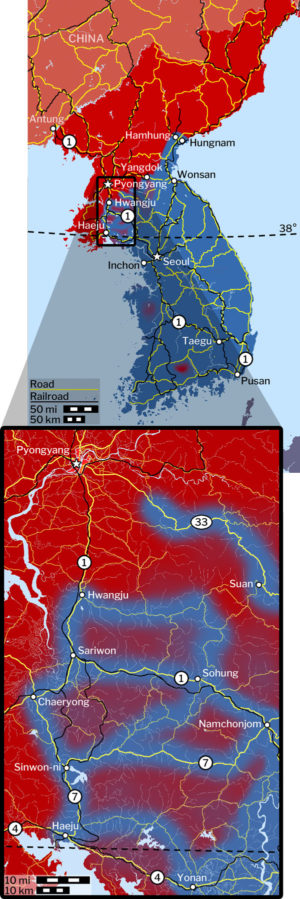 Oct 17: Korean War: South Korean and American troops converge on Pyongyang. On Korea’s east coast, The South’s Republic of Korea (ROK) Capital Division continues moving north from Wonsan against light resistance and capture the important industrial city of Hamhung and its port, Hungnam. To the southwest, the ROK 1st Division makes spectacular progress, racing up from Suan to a position just thirteen miles (24 km) from Pyongyang. American forces are also closing in on Pyongyang, but at a somewhat slower pace. From Namchonjom, the 24th Division moves west to take Sinwon-ni and Chaeryong, so that it can approach Sariwon from the south. At the same time, the U.S. 1st Cavalry division, followed by British and Australian forces, presses northwest to Sohung, where the 7th Cavalry Regiment splits off and strikes out to the north on secondary “cow paths” in a circuitous route to Hwangju. Their aim is to block escape routes north of Sariwon against retreating North Koreans. British forces continue up the main highway from Sohung, expecting a last stand by the North’s Korean People’s Army (KPA) in the heights south of Sarinwon. Instead, they find hungry and exhausted KPA soldiers waiting to surrender, alongside scores of abandoned Russian-built trucks with empty gas tanks. The British encounter one firefight at a hillside apple orchard south of town, but they quickly send the KPA fleeing into the hillsides. They soon take Sariwon and find it largely abandoned and in ruins. The Australian 3rd Battalion follows, and passes through Sariwon to continue northward to Hwangju. Meanwhile, the U.S. 7th Cavalry Regiment emerges from the secondary roads southwest of Hwangju and splits, sending one battalion south to meet up with the Australians and the British, while the rest moves northward to secure Hwangju. At the close of the day the American and British units are now racing four ROK divisions to be the first to enter Pyongyang. The ROK 1st division is the closest, about 13 miles (24 km) southeast of the capital on Highway 33. The ROK 7th Division in central Korea is swinging over from the east. The ROK 6th and 8th, which have been moving steadily northward from the Iron Triangle are converging in Yangdok, giving them access to the Pyongyang-Wonsan road and rail line. The final news of the day comes from western Korea, where the U.S. 21st Infantry of the 24th Division captures Haeju.
Oct 17: Korean War: South Korean and American troops converge on Pyongyang. On Korea’s east coast, The South’s Republic of Korea (ROK) Capital Division continues moving north from Wonsan against light resistance and capture the important industrial city of Hamhung and its port, Hungnam. To the southwest, the ROK 1st Division makes spectacular progress, racing up from Suan to a position just thirteen miles (24 km) from Pyongyang. American forces are also closing in on Pyongyang, but at a somewhat slower pace. From Namchonjom, the 24th Division moves west to take Sinwon-ni and Chaeryong, so that it can approach Sariwon from the south. At the same time, the U.S. 1st Cavalry division, followed by British and Australian forces, presses northwest to Sohung, where the 7th Cavalry Regiment splits off and strikes out to the north on secondary “cow paths” in a circuitous route to Hwangju. Their aim is to block escape routes north of Sariwon against retreating North Koreans. British forces continue up the main highway from Sohung, expecting a last stand by the North’s Korean People’s Army (KPA) in the heights south of Sarinwon. Instead, they find hungry and exhausted KPA soldiers waiting to surrender, alongside scores of abandoned Russian-built trucks with empty gas tanks. The British encounter one firefight at a hillside apple orchard south of town, but they quickly send the KPA fleeing into the hillsides. They soon take Sariwon and find it largely abandoned and in ruins. The Australian 3rd Battalion follows, and passes through Sariwon to continue northward to Hwangju. Meanwhile, the U.S. 7th Cavalry Regiment emerges from the secondary roads southwest of Hwangju and splits, sending one battalion south to meet up with the Australians and the British, while the rest moves northward to secure Hwangju. At the close of the day the American and British units are now racing four ROK divisions to be the first to enter Pyongyang. The ROK 1st division is the closest, about 13 miles (24 km) southeast of the capital on Highway 33. The ROK 7th Division in central Korea is swinging over from the east. The ROK 6th and 8th, which have been moving steadily northward from the Iron Triangle are converging in Yangdok, giving them access to the Pyongyang-Wonsan road and rail line. The final news of the day comes from western Korea, where the U.S. 21st Infantry of the 24th Division captures Haeju.
![]()
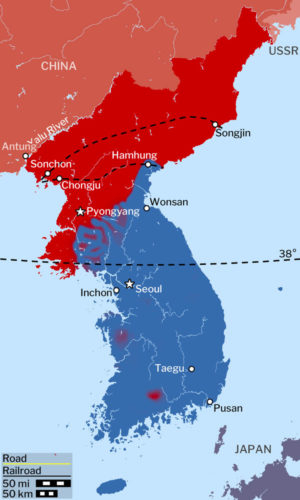 Oct 17: MacArthur imposes northern limit for non-South Korean troops. Until now, Gen. Douglas MacArthurs orders has prohibited U.N. ground forces other than South Korean troops from operating north of a line extending from Chongju on the west coast to Hamhung on the east. The order was based on a September 27 directive from the U.S. Joint Chiefs of Staff to avoid approaching the Chinese border and triggering their intervention in the war. In a new order, MacArthur lifts the previous restriction and imposes a new line extending from Sonchon in the west, extending through the mountains of far northern Korea and continuing on to Songjin (now Kimchaek) on the east coast. Under this directive, only South Korean forces can be deployed in provinces adjoining the Yalu River which marks much of the border with China.
Oct 17: MacArthur imposes northern limit for non-South Korean troops. Until now, Gen. Douglas MacArthurs orders has prohibited U.N. ground forces other than South Korean troops from operating north of a line extending from Chongju on the west coast to Hamhung on the east. The order was based on a September 27 directive from the U.S. Joint Chiefs of Staff to avoid approaching the Chinese border and triggering their intervention in the war. In a new order, MacArthur lifts the previous restriction and imposes a new line extending from Sonchon in the west, extending through the mountains of far northern Korea and continuing on to Songjin (now Kimchaek) on the east coast. Under this directive, only South Korean forces can be deployed in provinces adjoining the Yalu River which marks much of the border with China.
![]()
 Oct 17: Eisenhower says he has no desire to become President. Gen. Dwight D. Eisenhower, World War II hero and president of Columbia University, denies that he has any interest in running for President of the United States. In an interview published in the university newspaper The Columbia Daily Spectator, Eisenhower tells reporter David Wise, “I don’t know of anyone who has made himself clearer… So far as I’m concerned, I put my hand to a job and am doing my best. I don’t know why people are always nagging me to run for President.” Eisenhower, who has been university president since 1948, adds, “I think I’ve gotten too old. I have no desire to go anywhere else if I can help do what I want here at Columbia. This is the place for me.” On Sunday, New York Governor and 1948 Republican Presidential candidate Thomas E. Dewey told NBC’s Meet the Press that he, Dewey, wouldn’t run for the 1952 GOP nomination and that, instead, his choice is for Eisenhower. Eisenhower’s interview with the Daily Spectator took place on Thursday, three days before Dewey’s appearance. Despite Eisenhower’s public denials, observers are quick to detect what they believe to be a loophole: Eisenhower doesn’t say he will refuse to accept the nomination if the 1952 Republican Convention drafts him. An informal student poll published in the Daily Spectator the next day shows that about two-thirds of fifty students aren’t convinced about Eisenhower’s plans. Says one student, “Saying that he likes the Columbia presidency doesn’t mean he dislikes any other type of presidency.” Says another, “I think he is headed for the Presidency. By taking the presidency of Columbia and disassociating himself from his military past, and by his various political and social activities in the past year, I think he is trying to make the people think of him as an all-around citizen.” The New York World Telegram and Sun, in a front page story, quotes an unidentified “close friend of the General’s” as saying that Eisenhower “is definitely a candidate for the Presidency in 1952.”
Oct 17: Eisenhower says he has no desire to become President. Gen. Dwight D. Eisenhower, World War II hero and president of Columbia University, denies that he has any interest in running for President of the United States. In an interview published in the university newspaper The Columbia Daily Spectator, Eisenhower tells reporter David Wise, “I don’t know of anyone who has made himself clearer… So far as I’m concerned, I put my hand to a job and am doing my best. I don’t know why people are always nagging me to run for President.” Eisenhower, who has been university president since 1948, adds, “I think I’ve gotten too old. I have no desire to go anywhere else if I can help do what I want here at Columbia. This is the place for me.” On Sunday, New York Governor and 1948 Republican Presidential candidate Thomas E. Dewey told NBC’s Meet the Press that he, Dewey, wouldn’t run for the 1952 GOP nomination and that, instead, his choice is for Eisenhower. Eisenhower’s interview with the Daily Spectator took place on Thursday, three days before Dewey’s appearance. Despite Eisenhower’s public denials, observers are quick to detect what they believe to be a loophole: Eisenhower doesn’t say he will refuse to accept the nomination if the 1952 Republican Convention drafts him. An informal student poll published in the Daily Spectator the next day shows that about two-thirds of fifty students aren’t convinced about Eisenhower’s plans. Says one student, “Saying that he likes the Columbia presidency doesn’t mean he dislikes any other type of presidency.” Says another, “I think he is headed for the Presidency. By taking the presidency of Columbia and disassociating himself from his military past, and by his various political and social activities in the past year, I think he is trying to make the people think of him as an all-around citizen.” The New York World Telegram and Sun, in a front page story, quotes an unidentified “close friend of the General’s” as saying that Eisenhower “is definitely a candidate for the Presidency in 1952.”
![]()
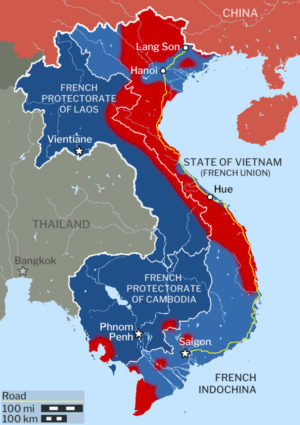 Oct 17: Vietnam, Battle of RC4: French abandon Lang Son, leaving tons of supplies and weaponry behind. The Battle of Route Coloniale 4 in far northern Vietnam ended four days ago, but the panic it induced in the French High Command leads it to hand yet another massive victory to the Viet Minh, this time with neither side firing a single bullet. Lang Son, the headquarters for the northern border zone, is ordered evacuated. Lang Son’s commander gets his troops out with little problem, but he leaves behind enough military supplies to support ten thousand men. When the Viet Minh arrive, they find 11,000 tons of ammunition, 4,000 brand new submachine guns, hundreds of gallons of gasoline, and enough food, clothing and medical supplies to last for years. Much of what the Viet Minh will fire at the French for the next four years will be of French origin from Lang Son. And with the entire stretch of RC4 along the Chinese border now in Viet Minh hands, they now have an unimpeded supply line from their colossal patron to the north.
Oct 17: Vietnam, Battle of RC4: French abandon Lang Son, leaving tons of supplies and weaponry behind. The Battle of Route Coloniale 4 in far northern Vietnam ended four days ago, but the panic it induced in the French High Command leads it to hand yet another massive victory to the Viet Minh, this time with neither side firing a single bullet. Lang Son, the headquarters for the northern border zone, is ordered evacuated. Lang Son’s commander gets his troops out with little problem, but he leaves behind enough military supplies to support ten thousand men. When the Viet Minh arrive, they find 11,000 tons of ammunition, 4,000 brand new submachine guns, hundreds of gallons of gasoline, and enough food, clothing and medical supplies to last for years. Much of what the Viet Minh will fire at the French for the next four years will be of French origin from Lang Son. And with the entire stretch of RC4 along the Chinese border now in Viet Minh hands, they now have an unimpeded supply line from their colossal patron to the north.
![]()
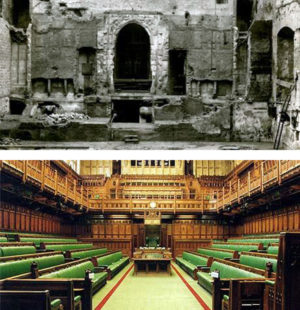 Oct 17: Reporters shown reconstructed British House of Commons. A redesigned and reconstructed British House of Commons is opened to reporters and photographers, nine and a half years after its destruction by German bombs during the London Blitz. Observers hail the reconstructed chamber as representing a triumph of craftsmanship that is gradually disappearing elsewhere in the country. Sone masons, one of them was 83-years-old, were brought out of retirement to help build the House. Former Prime Minister Winston Churchill decided to keep the chamber’s original size intact, opting to preserve its intimate conversational scale. He also retained its adversarial rectangular layout instead of adopting the semi-circular design increasingly favored by other legislative assemblies. Churchill says that the chamber’s design is responsible for the two-party system and is essential to British parliamentary democracy. Said Churchill, “We shape our buildings and afterwards our buildings shape us.” As a consequence, there is only enough seating on its traditional green leather-covered benches for 436 of the House’s 625 members. The lack of seating isn’t seen as a problem because the chamber is only used for debates and is rarely overflowing. Voting takes place in the division lobbies, the Aye Lobby and the No Lobby, which run along either side of the chamber. The chamber does have one new feature. Members will enter it through an archway, dubbed the Churchill Arch, made of chipped and weathered stones picked up from the debris after the bombing. The House will hold its first session in the new chamber on October 26.
Oct 17: Reporters shown reconstructed British House of Commons. A redesigned and reconstructed British House of Commons is opened to reporters and photographers, nine and a half years after its destruction by German bombs during the London Blitz. Observers hail the reconstructed chamber as representing a triumph of craftsmanship that is gradually disappearing elsewhere in the country. Sone masons, one of them was 83-years-old, were brought out of retirement to help build the House. Former Prime Minister Winston Churchill decided to keep the chamber’s original size intact, opting to preserve its intimate conversational scale. He also retained its adversarial rectangular layout instead of adopting the semi-circular design increasingly favored by other legislative assemblies. Churchill says that the chamber’s design is responsible for the two-party system and is essential to British parliamentary democracy. Said Churchill, “We shape our buildings and afterwards our buildings shape us.” As a consequence, there is only enough seating on its traditional green leather-covered benches for 436 of the House’s 625 members. The lack of seating isn’t seen as a problem because the chamber is only used for debates and is rarely overflowing. Voting takes place in the division lobbies, the Aye Lobby and the No Lobby, which run along either side of the chamber. The chamber does have one new feature. Members will enter it through an archway, dubbed the Churchill Arch, made of chipped and weathered stones picked up from the debris after the bombing. The House will hold its first session in the new chamber on October 26.
![]()
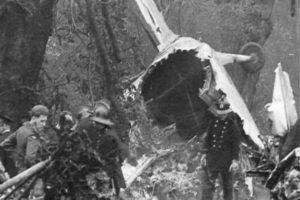 Oct 17: Airliner crashes in northwest London, killing 28. A twin-engine Douglas C-47 Dakota airliner flown by British European Airways crashes into a brick garden wall in the northwest London suburb of Mill Hill, killing all but one of the twenty-nine on board. The aircraft is trying to make it back to RAF Northold Airport in foggy and rainy weather, after the right (starboard) engine fails. According to several witnesses, the plane emerges from the mist, skims rooftops, breaks tree branches and telephone lines, and flips upside down and crashes into “a big ball of fire.” The crash occurs at about 3:00 p.m., shortly after the plane has taken off for Glasgow. A steward on board, James McKissick, is flung about 100 years (100 m) from the crash and survives. The rest on board — four other crew members and fourteen passengers, including one infant — are all killed. The investigation will find that the engine failure is due to the failure of the master rod bearings. But it finds that the loss of the engine was just one of “a number of coincident factors none of which standing alone would not have been sufficient to bring about the disaster.” An inquest will learn that the co-pilot was sitting in the captain’s chair, with the captain was sitting in the co-pilot’s chair, a practice that is often done in good weather to give co-pilots more experience. But weather conditions made such an arrangement “not suitable.” It will also find that the co-pilot, who was now acting as the aircraft’s captain, only had 48 hours of experience flying Dakotas, his license had expired five days earlier, and that he had failed a BEA instrument rating check in September. It is the worst British airline disaster since March 12, when eighty people were killed while returning from Belfast on an overloaded charter flight in Wales. The Wales crash remains the world’s worst air disaster so far.
Oct 17: Airliner crashes in northwest London, killing 28. A twin-engine Douglas C-47 Dakota airliner flown by British European Airways crashes into a brick garden wall in the northwest London suburb of Mill Hill, killing all but one of the twenty-nine on board. The aircraft is trying to make it back to RAF Northold Airport in foggy and rainy weather, after the right (starboard) engine fails. According to several witnesses, the plane emerges from the mist, skims rooftops, breaks tree branches and telephone lines, and flips upside down and crashes into “a big ball of fire.” The crash occurs at about 3:00 p.m., shortly after the plane has taken off for Glasgow. A steward on board, James McKissick, is flung about 100 years (100 m) from the crash and survives. The rest on board — four other crew members and fourteen passengers, including one infant — are all killed. The investigation will find that the engine failure is due to the failure of the master rod bearings. But it finds that the loss of the engine was just one of “a number of coincident factors none of which standing alone would not have been sufficient to bring about the disaster.” An inquest will learn that the co-pilot was sitting in the captain’s chair, with the captain was sitting in the co-pilot’s chair, a practice that is often done in good weather to give co-pilots more experience. But weather conditions made such an arrangement “not suitable.” It will also find that the co-pilot, who was now acting as the aircraft’s captain, only had 48 hours of experience flying Dakotas, his license had expired five days earlier, and that he had failed a BEA instrument rating check in September. It is the worst British airline disaster since March 12, when eighty people were killed while returning from Belfast on an overloaded charter flight in Wales. The Wales crash remains the world’s worst air disaster so far.
▲Wednesday, October 18
 Oct 18: KKK parades through city, warns resident to leave. The Opelika Daily News in far eastern Alabama, just a few miles from the state line with Georgia, will inform its readers the next morning, based on information obtained from “an inside Ku Klux Klan source,” that members of a local Klavern have called at the home of a local Negro “believed to be a Communist sympathizer” tonight. The paper’s inside source informs it however that the Klavern “allowed him to leave Opelika unharmed after he was questioned.” The Negro is unidentified, except to say that he is “a temporary resident of Jeter street.” All of that will be reported on tomorrow’s front page, along with news of “an alleged 10-car Klan procession parading in the city.” Alleged, because Police Chief Clanton Chandler says he knows nothing of any Klan demonstration anywhere in the city. Police Commissioner Ealon Lambert is equally surprised, and can’t imagine where such a rumor would come from. The procession takes place on Jeter Street, in a predominantly African-American neighborhood on the town’s northeast side. “There is little regular traffic on the street, and a ten-car procession would have attracted attention according to residents. But nobody on Jeter Street is talking about it, at least not to the reporter at the Opelika Daily News who has the benefit of this scoop from “an inside Ku Klux Klan source.” Opelika residents are somewhat accustomed to Klan activity in the area. A larger forty to fifty-car Klan caravan, accompanied by a police escort, took place in the city’s southern neighborhoods last January, which caused a tremendous public outcry at the time. Late last month, the Klan applied for a parade permit for October 6 to “demonstrate against the Communist enemies of our country.” Their plan was to parade through black neighborhoods and leave small crosses “where Communist activity occurred.” The City Commissioners refused to grant the permit.
Oct 18: KKK parades through city, warns resident to leave. The Opelika Daily News in far eastern Alabama, just a few miles from the state line with Georgia, will inform its readers the next morning, based on information obtained from “an inside Ku Klux Klan source,” that members of a local Klavern have called at the home of a local Negro “believed to be a Communist sympathizer” tonight. The paper’s inside source informs it however that the Klavern “allowed him to leave Opelika unharmed after he was questioned.” The Negro is unidentified, except to say that he is “a temporary resident of Jeter street.” All of that will be reported on tomorrow’s front page, along with news of “an alleged 10-car Klan procession parading in the city.” Alleged, because Police Chief Clanton Chandler says he knows nothing of any Klan demonstration anywhere in the city. Police Commissioner Ealon Lambert is equally surprised, and can’t imagine where such a rumor would come from. The procession takes place on Jeter Street, in a predominantly African-American neighborhood on the town’s northeast side. “There is little regular traffic on the street, and a ten-car procession would have attracted attention according to residents. But nobody on Jeter Street is talking about it, at least not to the reporter at the Opelika Daily News who has the benefit of this scoop from “an inside Ku Klux Klan source.” Opelika residents are somewhat accustomed to Klan activity in the area. A larger forty to fifty-car Klan caravan, accompanied by a police escort, took place in the city’s southern neighborhoods last January, which caused a tremendous public outcry at the time. Late last month, the Klan applied for a parade permit for October 6 to “demonstrate against the Communist enemies of our country.” Their plan was to parade through black neighborhoods and leave small crosses “where Communist activity occurred.” The City Commissioners refused to grant the permit.![]()
 Oct 18: David Greenglass pleads guilty of espionage. David Greenglass, a former technician at the Oak Ridge and Los Alamos nuclear facilities, who was arrested in June on espionage charges, pleads guilty in Federal court to passing atomic secrets to the Soviet Union during World War II. He admits that while he was in the Army in 1945 at Los Alamos, he supplied Harry Gold with secret sketches and documents. Greenglass says that his brother-in-law, Julius Rosenberg, recruited him into the spy ring. As part of Greenglass’s plea deal, he agrees to turn government witness against Julius Rosenberg. He will later become a witness against his sister, Ethel Rosenberg. Greenglass’s wife, Ruth, was named as a co-conspirator in the federal indictment, but she has not been named as a defendant. She is believed to be cooperating with the government.
Oct 18: David Greenglass pleads guilty of espionage. David Greenglass, a former technician at the Oak Ridge and Los Alamos nuclear facilities, who was arrested in June on espionage charges, pleads guilty in Federal court to passing atomic secrets to the Soviet Union during World War II. He admits that while he was in the Army in 1945 at Los Alamos, he supplied Harry Gold with secret sketches and documents. Greenglass says that his brother-in-law, Julius Rosenberg, recruited him into the spy ring. As part of Greenglass’s plea deal, he agrees to turn government witness against Julius Rosenberg. He will later become a witness against his sister, Ethel Rosenberg. Greenglass’s wife, Ruth, was named as a co-conspirator in the federal indictment, but she has not been named as a defendant. She is believed to be cooperating with the government.
![]()
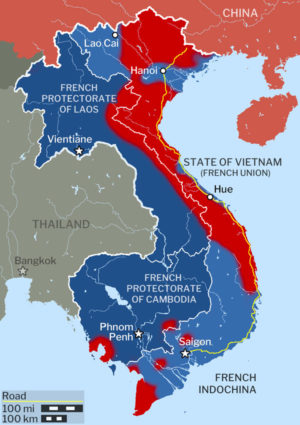 Oct 18: Vietnam: France orders preemptive evacuation of Lao Cai. The French High Command in Saigon, in its continuing panic due to the massive losses in the Battle of Route Coloniale 4, orders the evacuation of Lao Cai, in far northern Vietnam on the border with China. As with Lang Son which was evacuated yesterday, Lao Cai is not in any immediate threat from the Viet Minh. France’s humiliation is now complete. The Viet Minh has wiped out eight battalions, half of them elite Foreign Legion and paratrooper outfits. Almost 7,000 men are lost, as are almost 3,000 tons of heavy weapons and equipment. The French losses, much of which were self-inflicted, sends morale plunging among French troops. It also set off a wave of panic among French civilians in Hanoi, who were now hearing rumors that Hanoi will be evacuated next. France will replace the hapless commander in chief of French Indochina, Gen. Marcel Carpentier, with Gen. Jean de Lattre de Tassigny, who is often described as France’s answer to Douglas MacArthur. His arrival will raise morale among the troops and reassure jittery civilians.
Oct 18: Vietnam: France orders preemptive evacuation of Lao Cai. The French High Command in Saigon, in its continuing panic due to the massive losses in the Battle of Route Coloniale 4, orders the evacuation of Lao Cai, in far northern Vietnam on the border with China. As with Lang Son which was evacuated yesterday, Lao Cai is not in any immediate threat from the Viet Minh. France’s humiliation is now complete. The Viet Minh has wiped out eight battalions, half of them elite Foreign Legion and paratrooper outfits. Almost 7,000 men are lost, as are almost 3,000 tons of heavy weapons and equipment. The French losses, much of which were self-inflicted, sends morale plunging among French troops. It also set off a wave of panic among French civilians in Hanoi, who were now hearing rumors that Hanoi will be evacuated next. France will replace the hapless commander in chief of French Indochina, Gen. Marcel Carpentier, with Gen. Jean de Lattre de Tassigny, who is often described as France’s answer to Douglas MacArthur. His arrival will raise morale among the troops and reassure jittery civilians.
![]()
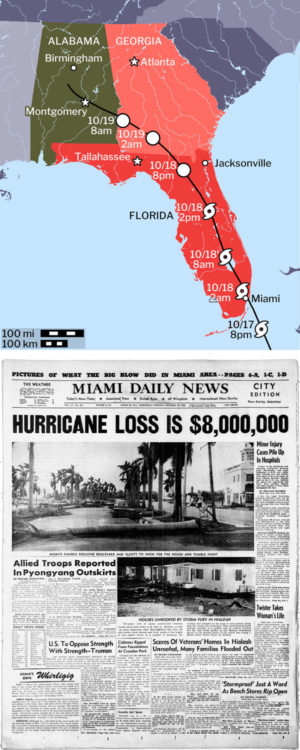 Oct 18-19: Hurricane hits Florida. A hurricane with peak winds estimated at about 130 mph (210 km/h, Category 4) strikes Miami at around midnight early on Tuesday morning. When the western edge of the eye reaches Miami International Airport, it reports wind gusts of 125 mph (202 km/h). The eastern eye wall hits the Miami Weather Bureau office, which records sustained winds of 122 mph (197 km/h). The path of damage is a narrow one, only about 14 miles (22½ km) wide. The Miami Hurricane Warning Center likens the narrow path of destruction as resembling the path of a large tornado. Damage in Miami totals about $15 million ($160 million today), while the rest of Florida suffers another $12.75 million ($135 million today) in damages. Crop damage is severe in central Florida, where about a third of the grapefruit crop along the Indian River is lost. The hurricane spawns at least one tornado in Davie. It is the worst hurricane to strike Miami since 1926. Three people are killed in Miami, about eight others elsewhere, and about fifty are injured. Thousands are left homeless, and millions are without power. The hurricane moves up the length of Florida, It will weaken to a tropical storm before crossing into western Georgia, then dissipate as a tropical depression over Alabama.
Oct 18-19: Hurricane hits Florida. A hurricane with peak winds estimated at about 130 mph (210 km/h, Category 4) strikes Miami at around midnight early on Tuesday morning. When the western edge of the eye reaches Miami International Airport, it reports wind gusts of 125 mph (202 km/h). The eastern eye wall hits the Miami Weather Bureau office, which records sustained winds of 122 mph (197 km/h). The path of damage is a narrow one, only about 14 miles (22½ km) wide. The Miami Hurricane Warning Center likens the narrow path of destruction as resembling the path of a large tornado. Damage in Miami totals about $15 million ($160 million today), while the rest of Florida suffers another $12.75 million ($135 million today) in damages. Crop damage is severe in central Florida, where about a third of the grapefruit crop along the Indian River is lost. The hurricane spawns at least one tornado in Davie. It is the worst hurricane to strike Miami since 1926. Three people are killed in Miami, about eight others elsewhere, and about fifty are injured. Thousands are left homeless, and millions are without power. The hurricane moves up the length of Florida, It will weaken to a tropical storm before crossing into western Georgia, then dissipate as a tropical depression over Alabama.
▲Thursday, October 19
![]()
 Oct 19: Korean War: Pyongyang falls to South Korean and American forces. The U.S. 1st Cavalry Division had been delayed the day before with an all-day battle at Hukkyo-ri. After defeating the North’s Korean People’s Army (KPA) forces there, the 1st Cavalry Division moves up to Pyongyang. The city straddles the Taedong River, which averages 400 to 500 yards (350-450m) in width. The portion of Pyongyang south of the river consists of industrial suburbs, while the main government buildings are on the north bank. With the bridges out, the Taedong poses a significant barrier, leaving the 1st Cavalry stranded in the southern portions of Pyongyang. Meanwhile, the South’s Republic of Korea (ROK) 1st Division, approaching Pyongyang on Highway 33. Battling against heavy resistance and dense anti-tank mines, it is able reach the southern portion of Pyongyang at about the same time as the 1st Cavalry Division. Major Gen. Paik Sun Yup, commander of the ROK 1st Division, is a native of Pyongyang, and he knows where the best fords across the Taedong are east of the city. The ROK 1st crosses to the north bank and enters the main part of Pyongyang from the northeast. Later that afternoon, the ROK 7th Division enters northern Pyongyang from the east, and takes possession of Kim Il Sung University. By the following morning at 10:00 a.m. the ROK 1st will report that the entire city is secured, including the City Hall, the Provincial Government offices, and the North Korean People’s Committee offices. Pyongyang residents say that the North Korean government has fled to Huichon and military headquarters has relocated to Sunchon. U.N. forces have recovered twenty American prisoners who have escaped or were rescued from the North Koreans. But most of the larger number of prisoners that had been held in Pyongyang have been moved northward over several previous days. Southwest of Pyongyang, the U.S. 24th Division pushes north and takes Anak, Ojong-ni, and the principle ferry crossings opposite of Chinnampo.
Oct 19: Korean War: Pyongyang falls to South Korean and American forces. The U.S. 1st Cavalry Division had been delayed the day before with an all-day battle at Hukkyo-ri. After defeating the North’s Korean People’s Army (KPA) forces there, the 1st Cavalry Division moves up to Pyongyang. The city straddles the Taedong River, which averages 400 to 500 yards (350-450m) in width. The portion of Pyongyang south of the river consists of industrial suburbs, while the main government buildings are on the north bank. With the bridges out, the Taedong poses a significant barrier, leaving the 1st Cavalry stranded in the southern portions of Pyongyang. Meanwhile, the South’s Republic of Korea (ROK) 1st Division, approaching Pyongyang on Highway 33. Battling against heavy resistance and dense anti-tank mines, it is able reach the southern portion of Pyongyang at about the same time as the 1st Cavalry Division. Major Gen. Paik Sun Yup, commander of the ROK 1st Division, is a native of Pyongyang, and he knows where the best fords across the Taedong are east of the city. The ROK 1st crosses to the north bank and enters the main part of Pyongyang from the northeast. Later that afternoon, the ROK 7th Division enters northern Pyongyang from the east, and takes possession of Kim Il Sung University. By the following morning at 10:00 a.m. the ROK 1st will report that the entire city is secured, including the City Hall, the Provincial Government offices, and the North Korean People’s Committee offices. Pyongyang residents say that the North Korean government has fled to Huichon and military headquarters has relocated to Sunchon. U.N. forces have recovered twenty American prisoners who have escaped or were rescued from the North Koreans. But most of the larger number of prisoners that had been held in Pyongyang have been moved northward over several previous days. Southwest of Pyongyang, the U.S. 24th Division pushes north and takes Anak, Ojong-ni, and the principle ferry crossings opposite of Chinnampo.
![]() Oct 19: Vietnam: Reporters accuse French officials of censorship. The Associated Press complains that “French Military censorship and a lack of accurate information are preventing foreign correspondents cabling factual, comprehensive accounts of the serious reverses being suffered by the French army in North Indochina. Military authorities are refusing to furnish to war correspondents the facilities normally accorded them. Army censors make deletions in dispatches without the sender. Correspondents have been advised by their home offices that some messages arrive after delays of up to seventy-two hours, so badly cut as to be unintelligible. Dispatches have been censored or delayed for reasons other than what is ordinarily considered military security. Messages on political questions affecting the French army have been tampered with.” Reporters are angered at having been misled into believing that the evacuation of French forces from Cao Bang had been successfully concluded without a major fight, only to learn later that entire elite French forces have been virtually annihilated. They point out that the full extent of the losses still have not been disclosed.
Oct 19: Vietnam: Reporters accuse French officials of censorship. The Associated Press complains that “French Military censorship and a lack of accurate information are preventing foreign correspondents cabling factual, comprehensive accounts of the serious reverses being suffered by the French army in North Indochina. Military authorities are refusing to furnish to war correspondents the facilities normally accorded them. Army censors make deletions in dispatches without the sender. Correspondents have been advised by their home offices that some messages arrive after delays of up to seventy-two hours, so badly cut as to be unintelligible. Dispatches have been censored or delayed for reasons other than what is ordinarily considered military security. Messages on political questions affecting the French army have been tampered with.” Reporters are angered at having been misled into believing that the evacuation of French forces from Cao Bang had been successfully concluded without a major fight, only to learn later that entire elite French forces have been virtually annihilated. They point out that the full extent of the losses still have not been disclosed.
![]()
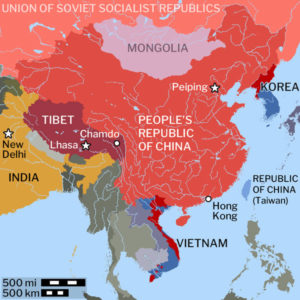 Oct 19: Tibetans surrender to Chinese forces at Chamdo. The Governor of Chamdo (Qamdo) and commander of Tibetan forces there, Ngabo Ngawang Jigme, surrender with his 2,700 soldiers after a more than two week siege by two units of Communist China’s People’s Liberation Army. The PLA confiscates the Tibetan soldiers’ weapons and sends them home. The PLA sends Ngabo to Lhasa to reiterate the terms of negotiation, which includes moving them from New Dehli to Peiping (Beijing).
Oct 19: Tibetans surrender to Chinese forces at Chamdo. The Governor of Chamdo (Qamdo) and commander of Tibetan forces there, Ngabo Ngawang Jigme, surrender with his 2,700 soldiers after a more than two week siege by two units of Communist China’s People’s Liberation Army. The PLA confiscates the Tibetan soldiers’ weapons and sends them home. The PLA sends Ngabo to Lhasa to reiterate the terms of negotiation, which includes moving them from New Dehli to Peiping (Beijing).
![]() Oct 19: Australia passes Communist Party Dissolution Act. Australia’s Liberal Prime Minister Robert Menzies wins passage of a second version of the Communist Party Dissolution Bill, which declare the Australian Communist Party illegal and confiscates its property without compensation. The bill also empowers the Governor-General to declare unlawful any organization that it deems to be a Communist front. Any officers of those organizations who continue their activities or try to enlist others to their causes face imprisonment for up to five years. Anyone who is declared to be a Communist or who is “likely to engage” in activities “prejudicial” to the government is prohibited from holding public or trade union office, and is barred from government employment. Such a person will also be banned from holding jobs in “key” positions, including coal, iron, building, steel, transportation, power, engineering or other industries deemed vital to Australia’s defense and security. The Senate has already rejected an earlier version of the bill once, but Menzies wins passage this time by threatening a double dissolution of Parliament. The Labor Party, which controls the Senate, allows the bill to proceed rather than risk further losses in an election. The law will gain royal assent the following day, when it will be immediately challenged in the High Court.
Oct 19: Australia passes Communist Party Dissolution Act. Australia’s Liberal Prime Minister Robert Menzies wins passage of a second version of the Communist Party Dissolution Bill, which declare the Australian Communist Party illegal and confiscates its property without compensation. The bill also empowers the Governor-General to declare unlawful any organization that it deems to be a Communist front. Any officers of those organizations who continue their activities or try to enlist others to their causes face imprisonment for up to five years. Anyone who is declared to be a Communist or who is “likely to engage” in activities “prejudicial” to the government is prohibited from holding public or trade union office, and is barred from government employment. Such a person will also be banned from holding jobs in “key” positions, including coal, iron, building, steel, transportation, power, engineering or other industries deemed vital to Australia’s defense and security. The Senate has already rejected an earlier version of the bill once, but Menzies wins passage this time by threatening a double dissolution of Parliament. The Labor Party, which controls the Senate, allows the bill to proceed rather than risk further losses in an election. The law will gain royal assent the following day, when it will be immediately challenged in the High Court.
▲Friday, October 20
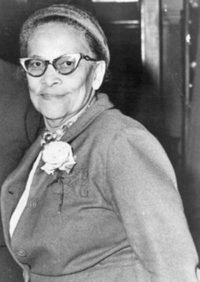 Oct 20: Black nursing organization to merge with American Nurses Association. Mabel K. Staupers, president of the National Association of Colored Graduate Nurses, announces that her organization will merge with the American Nurses Association in January. The NACGN was established in 1908 to help African-American women gain admission to nursing schools, find jobs, and provide professional assistance. “Now, the situation has changed a lot,” explains Staupers. Just before World War II, only forty-two nursing schools, twenty-eight of them at all black institutions, admitted African-American students. But when war broke out, the NACGN’s hard lobbying under Staupers’s leadership resulted in an integrated Cadet Nurse Corps. By the end of the war, the U.S. military was accepting all qualified nursing applicants regardless of race. This had a knock-on effect on nursing schools and hiring practices during and after the war. Black nursing students can now be admitted to 330 out of the nation’s 1,200 nursing schools, and those graduates are being hired at more hospitals and public health agencies. And since 1948, black nurses in areas where state affiliates of the American Nurses Association still refuse to admit them — Georgia, Louisiana, South Carolina, Texas, Virginia, and the District of Columbia — those nurses can now gain membership in the national organization directly. Staupers explains that out of 10,000 black nurses in the country, only about 2,000 hold membership in the NACGN. “They’ve been leaving us fast and going to the American Nurses Association,” she says, “which is just what we want them to do.”
Oct 20: Black nursing organization to merge with American Nurses Association. Mabel K. Staupers, president of the National Association of Colored Graduate Nurses, announces that her organization will merge with the American Nurses Association in January. The NACGN was established in 1908 to help African-American women gain admission to nursing schools, find jobs, and provide professional assistance. “Now, the situation has changed a lot,” explains Staupers. Just before World War II, only forty-two nursing schools, twenty-eight of them at all black institutions, admitted African-American students. But when war broke out, the NACGN’s hard lobbying under Staupers’s leadership resulted in an integrated Cadet Nurse Corps. By the end of the war, the U.S. military was accepting all qualified nursing applicants regardless of race. This had a knock-on effect on nursing schools and hiring practices during and after the war. Black nursing students can now be admitted to 330 out of the nation’s 1,200 nursing schools, and those graduates are being hired at more hospitals and public health agencies. And since 1948, black nurses in areas where state affiliates of the American Nurses Association still refuse to admit them — Georgia, Louisiana, South Carolina, Texas, Virginia, and the District of Columbia — those nurses can now gain membership in the national organization directly. Staupers explains that out of 10,000 black nurses in the country, only about 2,000 hold membership in the NACGN. “They’ve been leaving us fast and going to the American Nurses Association,” she says, “which is just what we want them to do.”![]()
 Oct 20: Korean War: U.S. 11th Arborne Division parachutes 30 miles north of Pyongyang. While American and ROK forces are securing Pyongyang and surrounding areas, the U.S. 11th Airborne Division jumps into North Korean-held territory about thirty miles (50 km) north of Pyongyang. The goal is to cut off Communist escape routes. In addition, recent intelligence reports have suggested that a trainload of American prisoners, traveling slowly and only at night, is moving north from the former North Korean capital. After the Air Force laid down heavy rocket and strafing fire at the drop zone near Sukchon, the 187th Regiment, commanded by Col. W. S. Bowens, makes its descent. After the troop drop comes that of the heavy equipment: jeeps, antitank guns, howitzers, ammunition, gasoline, rations, and a 2½-ton mobile radio transmission set. This is the first time heavy equipment has been dropped in combat. The 1st Battalion quickly seizes Sukchon and sets up a roadblock north of town. The 2nd Battalion jumps in the second landing zone two miles (3¼ km) southwest of Sunchon, followed by its heavy equipment and supplies. The 2nd Battalion seizes Sunchon and makes contact with advance elements of the ROK 6th Division arriving from the southeast. Overseeing the entire operation is Gen. Douglas MacArthur, who flew in from Japan and watches it all unfold from his unarmed Constellation. He later returns to Seoul and tells reporters that the airborne landing was an “expert performance” that caught the enemy by complete surprise. He estimates that about 30,000 North Korean troops are caught in the trap. In fact, there aren’t that many enemy troops between Sukchon, Sunchon and Pyongyang. The main body of the KPA is well to the north, either north of the Chongchon River or in the process of crossing it.
Oct 20: Korean War: U.S. 11th Arborne Division parachutes 30 miles north of Pyongyang. While American and ROK forces are securing Pyongyang and surrounding areas, the U.S. 11th Airborne Division jumps into North Korean-held territory about thirty miles (50 km) north of Pyongyang. The goal is to cut off Communist escape routes. In addition, recent intelligence reports have suggested that a trainload of American prisoners, traveling slowly and only at night, is moving north from the former North Korean capital. After the Air Force laid down heavy rocket and strafing fire at the drop zone near Sukchon, the 187th Regiment, commanded by Col. W. S. Bowens, makes its descent. After the troop drop comes that of the heavy equipment: jeeps, antitank guns, howitzers, ammunition, gasoline, rations, and a 2½-ton mobile radio transmission set. This is the first time heavy equipment has been dropped in combat. The 1st Battalion quickly seizes Sukchon and sets up a roadblock north of town. The 2nd Battalion jumps in the second landing zone two miles (3¼ km) southwest of Sunchon, followed by its heavy equipment and supplies. The 2nd Battalion seizes Sunchon and makes contact with advance elements of the ROK 6th Division arriving from the southeast. Overseeing the entire operation is Gen. Douglas MacArthur, who flew in from Japan and watches it all unfold from his unarmed Constellation. He later returns to Seoul and tells reporters that the airborne landing was an “expert performance” that caught the enemy by complete surprise. He estimates that about 30,000 North Korean troops are caught in the trap. In fact, there aren’t that many enemy troops between Sukchon, Sunchon and Pyongyang. The main body of the KPA is well to the north, either north of the Chongchon River or in the process of crossing it.
![]() Oct 20: National Women’s Council warns of Kinsey Report dangers. The National Council of Women of the United States, alarmed by what it sees as the growing “moral lapse” caused its says is being promoted by the Kinsey Report, adopts an “emergency resolution” urging coordinated community efforts to ensure the “the establishment and maintenance of secure homes and wholesome communities.” Alfred Kinsey’s 1948 best-seller Sexual Behavior in the Human Male shocked the American public who, for the first time, learned of the sexual practices of large numbers of fellow Americans. Learning that so many people were engaged in extramarital affairs, premarital sex, homosexuality, and various sexual practices that went far beyond what was required for procreation, the book, popularly called the Kinsey Report, has set off a wave of moral panic that shows no sign of weakening. The NCWUS resolution, adopted at its biennial meeting in New York City, comes in response to a talk given by Esther Emerson Sweeney, Director of Community Service for the American Social Hygiene Association. Sweeney warns that Kinsey has set off a “weakening of standards” which threaten the future of home life. “The Kinsey Report is endangering relations in the home instead of improving them,” she says. Its statistics are especially dangerous, because they suggest that sexual standards should be re-examined in light of the large numbers of people who regularly violate them. The “test of validity does not lie in violations,” she says. “Our own future strength as fathers and mothers are threatened if moral standards are not high and based on conviction.” She asserts that Americans “are unwilling to change their ethical standards” and calls on schools and churches to provide “more than a namby-pamby guidance to morals.”
Oct 20: National Women’s Council warns of Kinsey Report dangers. The National Council of Women of the United States, alarmed by what it sees as the growing “moral lapse” caused its says is being promoted by the Kinsey Report, adopts an “emergency resolution” urging coordinated community efforts to ensure the “the establishment and maintenance of secure homes and wholesome communities.” Alfred Kinsey’s 1948 best-seller Sexual Behavior in the Human Male shocked the American public who, for the first time, learned of the sexual practices of large numbers of fellow Americans. Learning that so many people were engaged in extramarital affairs, premarital sex, homosexuality, and various sexual practices that went far beyond what was required for procreation, the book, popularly called the Kinsey Report, has set off a wave of moral panic that shows no sign of weakening. The NCWUS resolution, adopted at its biennial meeting in New York City, comes in response to a talk given by Esther Emerson Sweeney, Director of Community Service for the American Social Hygiene Association. Sweeney warns that Kinsey has set off a “weakening of standards” which threaten the future of home life. “The Kinsey Report is endangering relations in the home instead of improving them,” she says. Its statistics are especially dangerous, because they suggest that sexual standards should be re-examined in light of the large numbers of people who regularly violate them. The “test of validity does not lie in violations,” she says. “Our own future strength as fathers and mothers are threatened if moral standards are not high and based on conviction.” She asserts that Americans “are unwilling to change their ethical standards” and calls on schools and churches to provide “more than a namby-pamby guidance to morals.”
▲Saturday, October 21
![]()
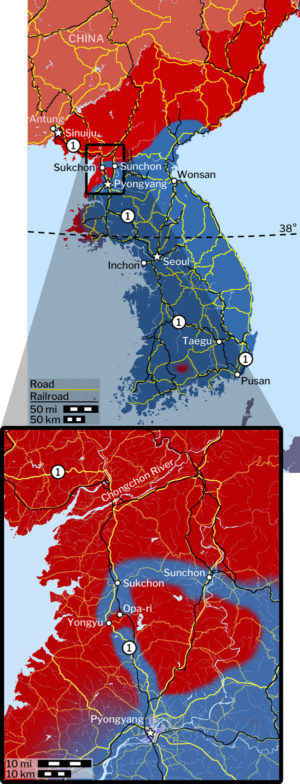 Oct 21: North Korea announces temporary capital in Sinuiju. The North Korean government announces that it has established its temporary seat of government in Sinuiju, located just across the Yalu River from Antung, China. This coincides with reports of increased massing of an estimated 250,000 Chinese troops along the border. American officials believe that the troop movement reflect’s China’s intention to defend the border, and that the Chinese are not preparing to cross into North Korea. In Tokyo. Gen. Douglas MacArthur predicts that “the war is very definitely coming to an end shortly.
Oct 21: North Korea announces temporary capital in Sinuiju. The North Korean government announces that it has established its temporary seat of government in Sinuiju, located just across the Yalu River from Antung, China. This coincides with reports of increased massing of an estimated 250,000 Chinese troops along the border. American officials believe that the troop movement reflect’s China’s intention to defend the border, and that the Chinese are not preparing to cross into North Korea. In Tokyo. Gen. Douglas MacArthur predicts that “the war is very definitely coming to an end shortly.
![]() Oct 21: Korean War: U.S. Airborne units encircle fleeing North Koreans. The battalions of the U.S. 11th Airborne Division which jumped into Sukchon and Sunchon yesterday establish contact between the two towns to form a broad barrier to catch any North Korean troops which may be fleeing northward from Pyongyang, some of whom are believed to be moving American and South Korean POWs with them. At the same time, a battalion moves south from Sukchon toward Pyongyang. Their progress is halted at Opa-ri, where an enemy battalion attacks them, overrunning two positions. The American’s establish defensive positions east of Opa-ri, while the North Koreans move to the hills to the west. Meanwhile, another company advancing south along the highway, is attacked about a mile (1½ km) north of Yongyu. They push the North Koreans to the hills between Yongyu and Opa-ri. This North Korean regiment, the last to leave Pyongyang, established defensive positions in these hills in anticipation of the American and South Korean armies moving up from the south. Instead, they have find themselves being attacked from their rear. That same afternoon, British, American, and South Korean forces begin moving north from Pyongyang and arrive at Yongyu and Opa-ri that evening, where they stop for the night and prepare for the next day’s battle.
Oct 21: Korean War: U.S. Airborne units encircle fleeing North Koreans. The battalions of the U.S. 11th Airborne Division which jumped into Sukchon and Sunchon yesterday establish contact between the two towns to form a broad barrier to catch any North Korean troops which may be fleeing northward from Pyongyang, some of whom are believed to be moving American and South Korean POWs with them. At the same time, a battalion moves south from Sukchon toward Pyongyang. Their progress is halted at Opa-ri, where an enemy battalion attacks them, overrunning two positions. The American’s establish defensive positions east of Opa-ri, while the North Koreans move to the hills to the west. Meanwhile, another company advancing south along the highway, is attacked about a mile (1½ km) north of Yongyu. They push the North Koreans to the hills between Yongyu and Opa-ri. This North Korean regiment, the last to leave Pyongyang, established defensive positions in these hills in anticipation of the American and South Korean armies moving up from the south. Instead, they have find themselves being attacked from their rear. That same afternoon, British, American, and South Korean forces begin moving north from Pyongyang and arrive at Yongyu and Opa-ri that evening, where they stop for the night and prepare for the next day’s battle.
![]() Oct 21: Vietnam head of state returns from lengthy holiday in France. The former emperor Bao Dai, the President of the French Indochina quasi-independent State of Vietnam, finally arrives in Vietnam from a three and a half long holiday in Cannes, where he has picked up the nickname, “the night club emperor”. Thus far, he has shown almost no interest in Vietnam. His continued absence, despite the military catastrophes taking place in his country, has irritated French authorities, angered the French public, and made him even less popular — if that were possible — back home in Vietnam. Before departing Paris, he declares that he is returning “to be at the side of my people,” but his disinterest remains undiminished. His plane bypasses Saigon, the capital, and flies directly to the mountain resort city of Dalat.
Oct 21: Vietnam head of state returns from lengthy holiday in France. The former emperor Bao Dai, the President of the French Indochina quasi-independent State of Vietnam, finally arrives in Vietnam from a three and a half long holiday in Cannes, where he has picked up the nickname, “the night club emperor”. Thus far, he has shown almost no interest in Vietnam. His continued absence, despite the military catastrophes taking place in his country, has irritated French authorities, angered the French public, and made him even less popular — if that were possible — back home in Vietnam. Before departing Paris, he declares that he is returning “to be at the side of my people,” but his disinterest remains undiminished. His plane bypasses Saigon, the capital, and flies directly to the mountain resort city of Dalat.
![]()
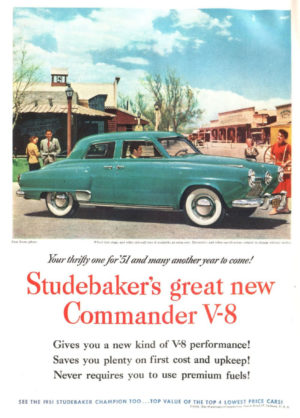 Oct 21: Studebaker reveals 1951 models. The Studebaker Corporation of South Bend, Indiana, presents its 1951 line consisting of two models: the venerable Champion and the larger Commander. Body styles don’t change that much for 1951. Studebaker was the first car manufacturer to debut fresh new body styles after the war, while its competitors were still making do with tweaked 1942 designs. Consequently, Studebaker designs were still relatively fresh. Styling changes are limited to both models getting one-piece windshields and an updated bullet-nosed “spinner” front grille. Studebaker spent most of its money developing a new 120 horsepower V-8 engine for the Commander. The Champion retains its 85 horsepower six. The Champion comes in three trim levels and five body styles including a convertible, and starts at $1,612 (about $16,550 today) for a two-door sedan, and tops out at $2,106 ($21,600 today) for the convertible in Regal trim. The larger Commander is available in five body styles, including a convertible, for $2,329 ($23,900 today) and a top-of-the-line four-door with a longer wheelbase they call the Land Cruiser (not to be confused with the SUV’s of later decades) for $2,156 ($22,100 today). The new Studebakers will show up in dealerships early next month.
Oct 21: Studebaker reveals 1951 models. The Studebaker Corporation of South Bend, Indiana, presents its 1951 line consisting of two models: the venerable Champion and the larger Commander. Body styles don’t change that much for 1951. Studebaker was the first car manufacturer to debut fresh new body styles after the war, while its competitors were still making do with tweaked 1942 designs. Consequently, Studebaker designs were still relatively fresh. Styling changes are limited to both models getting one-piece windshields and an updated bullet-nosed “spinner” front grille. Studebaker spent most of its money developing a new 120 horsepower V-8 engine for the Commander. The Champion retains its 85 horsepower six. The Champion comes in three trim levels and five body styles including a convertible, and starts at $1,612 (about $16,550 today) for a two-door sedan, and tops out at $2,106 ($21,600 today) for the convertible in Regal trim. The larger Commander is available in five body styles, including a convertible, for $2,329 ($23,900 today) and a top-of-the-line four-door with a longer wheelbase they call the Land Cruiser (not to be confused with the SUV’s of later decades) for $2,156 ($22,100 today). The new Studebakers will show up in dealerships early next month.
▲Sunday, October 22
![]()
 Oct 22: Korean War: South Korean forces press gains. On the east coast, the South’s Republic of Korea (ROK) 3rd and Capital Divisions move rapidly northeast and take Pukchang and portions of the mountainous territory northwest of town. In north-central Korea, the ROK 6th Division sweeps northward and takes Huichon, placing that outfit the closest to the border with China. In the west, a tank-infantry force of the ROK 1st Division race north from Sunchon and captures Anju on the south bank of the Chongchon River, They then turn northeast along the river and take Kuni-ri and Kujang-dong.
Oct 22: Korean War: South Korean forces press gains. On the east coast, the South’s Republic of Korea (ROK) 3rd and Capital Divisions move rapidly northeast and take Pukchang and portions of the mountainous territory northwest of town. In north-central Korea, the ROK 6th Division sweeps northward and takes Huichon, placing that outfit the closest to the border with China. In the west, a tank-infantry force of the ROK 1st Division race north from Sunchon and captures Anju on the south bank of the Chongchon River, They then turn northeast along the river and take Kuni-ri and Kujang-dong.
![]() Korean War: North Koreans defeated at Yongyu and Opa-ri. The North Korean regiment that is surrounded by American, Australian, and British forces between Opa-ri and Yongyu tries to break out to the north in four attacks between midnight and six a.m. Those attacks inflicting heavy losses on American forces, who have them trapped from the north. British and Australian forces a mile or so to the south hear the fighting and advance into Yongyu at first daylight. After fierce fighting involving hand-to-hand combat between the Australians and North Koreans, the enemy is finally forced to retreat. The British and Australian forces are then able to join up with the Americans just north of Yongyu. While there are occasional instances where the North Koreans put up a fierce fight here or there, for the most part it appears that enemy resistance has largely melted away. The next morning, New York Times reporter Lindesay Parrot will write, “Military observers here believed that there was no question of the smashing North Korean defeat. The question in their minds was what would happen and whether refuge would be made available to the enemy in Communist-controlled Manchuria when the Yalu River was reached.”
Korean War: North Koreans defeated at Yongyu and Opa-ri. The North Korean regiment that is surrounded by American, Australian, and British forces between Opa-ri and Yongyu tries to break out to the north in four attacks between midnight and six a.m. Those attacks inflicting heavy losses on American forces, who have them trapped from the north. British and Australian forces a mile or so to the south hear the fighting and advance into Yongyu at first daylight. After fierce fighting involving hand-to-hand combat between the Australians and North Koreans, the enemy is finally forced to retreat. The British and Australian forces are then able to join up with the Americans just north of Yongyu. While there are occasional instances where the North Koreans put up a fierce fight here or there, for the most part it appears that enemy resistance has largely melted away. The next morning, New York Times reporter Lindesay Parrot will write, “Military observers here believed that there was no question of the smashing North Korean defeat. The question in their minds was what would happen and whether refuge would be made available to the enemy in Communist-controlled Manchuria when the Yalu River was reached.”
![]() Oct 22: Korean War: Seventy-two murdered American POWs discovered. At Sunchon, site of the second drop zone two days earlier, things are mostly quiet. Sometime before noon, local civilians arrive at the command post, saying that the North Koreans had murdered American prisoners of war at a railroad tunnel at Myongucham, about five miles (8 km) northwest of town. The American commanders, with two reporters in tow, head out there, where they discover the bodies of sixty-six dead American soldiers, many holding their rice bowls in anticipation of their evening meal. They immediately find six survivors, who tell their story: Two trains, each carrying about 150 American POWs, left Pyongyang on October 17. The trains moved slowly, making frequent stops to repair tracks and avoid being spotted by U.N. air forces. Each day, a half dozen men died of disease, starvation or exposure. On October 20th, as the parachute jump was taking place, the first train left, but the second one stayed in the tunnel to escape air activity. Now, there are only about a hundred prisoners left on this train, crowded into open coal gondolas and boxcars. The North Korean guards stoke the steam engine to flood the tunnel with smoke in an effort to asphyxiate the prisoners. When that didn’t work, the prisoners were taken from the train in three groups, ostensibly to receive their evening meal. They were shot down as they waited for it. The train and the North Korean guards left that night. Altogether, the rescuers find sixty-six POWs dead. One group is buried in shallow graves; the rest are found out in the open. In addition, there are six more dead POWs in the tunnel who apparently died of starvation or disease. Rescuers find twenty-three survivors, two of whom die during the night.
Oct 22: Korean War: Seventy-two murdered American POWs discovered. At Sunchon, site of the second drop zone two days earlier, things are mostly quiet. Sometime before noon, local civilians arrive at the command post, saying that the North Koreans had murdered American prisoners of war at a railroad tunnel at Myongucham, about five miles (8 km) northwest of town. The American commanders, with two reporters in tow, head out there, where they discover the bodies of sixty-six dead American soldiers, many holding their rice bowls in anticipation of their evening meal. They immediately find six survivors, who tell their story: Two trains, each carrying about 150 American POWs, left Pyongyang on October 17. The trains moved slowly, making frequent stops to repair tracks and avoid being spotted by U.N. air forces. Each day, a half dozen men died of disease, starvation or exposure. On October 20th, as the parachute jump was taking place, the first train left, but the second one stayed in the tunnel to escape air activity. Now, there are only about a hundred prisoners left on this train, crowded into open coal gondolas and boxcars. The North Korean guards stoke the steam engine to flood the tunnel with smoke in an effort to asphyxiate the prisoners. When that didn’t work, the prisoners were taken from the train in three groups, ostensibly to receive their evening meal. They were shot down as they waited for it. The train and the North Korean guards left that night. Altogether, the rescuers find sixty-six POWs dead. One group is buried in shallow graves; the rest are found out in the open. In addition, there are six more dead POWs in the tunnel who apparently died of starvation or disease. Rescuers find twenty-three survivors, two of whom die during the night.
▲Monday, October 23
Labour Day (New Zealand)
 Oct 23: Georgia power broker says Negroes will be driven from 50 rural counties if schools are desegregated. Georgia’s former House Speaker and gubernatorial kingmaker Roy Harris comes out with another warning to the state’s Negros who insist on filing lawsuits seeking to desegregate the state’s public schools. Writing in his closely watched weekly newspaper The Courier, Harris predicts that if Atlanta’s African-American parents’ lawsuit against the city’s schools is successful, Negroes living in the state’s rural counties will be forced out of those communities. Harris quotes an “informant” as saying that Negroes would be driven from as many as fifty of the state’s 159 counties in order to keep their children out of public schools. Harris doesn’t say how this would be done, but he writes: “Negroes could be dispensed with on the farms of Georgia more easily now than at any other time in the history of the state. … Our informant says that in some few communities practically all the farmers have entered into the agreement and are now devising ways to get a state-wide campaign organized for the purpose of securing the same agreement elsewhere. While this movement at first might seem fanciful, it is not beyond the realm of possibility.” Harris says that Georgia’s Negroes are “being exploited and misled by their national organizations” and blames “some of the Negro churches” and the NAACP. Harris’s earlier editorials on October 2 and October 9 have warned that Georgia may abandon public education altogether if the courts order the schools desegregated.
Oct 23: Georgia power broker says Negroes will be driven from 50 rural counties if schools are desegregated. Georgia’s former House Speaker and gubernatorial kingmaker Roy Harris comes out with another warning to the state’s Negros who insist on filing lawsuits seeking to desegregate the state’s public schools. Writing in his closely watched weekly newspaper The Courier, Harris predicts that if Atlanta’s African-American parents’ lawsuit against the city’s schools is successful, Negroes living in the state’s rural counties will be forced out of those communities. Harris quotes an “informant” as saying that Negroes would be driven from as many as fifty of the state’s 159 counties in order to keep their children out of public schools. Harris doesn’t say how this would be done, but he writes: “Negroes could be dispensed with on the farms of Georgia more easily now than at any other time in the history of the state. … Our informant says that in some few communities practically all the farmers have entered into the agreement and are now devising ways to get a state-wide campaign organized for the purpose of securing the same agreement elsewhere. While this movement at first might seem fanciful, it is not beyond the realm of possibility.” Harris says that Georgia’s Negroes are “being exploited and misled by their national organizations” and blames “some of the Negro churches” and the NAACP. Harris’s earlier editorials on October 2 and October 9 have warned that Georgia may abandon public education altogether if the courts order the schools desegregated.![]()
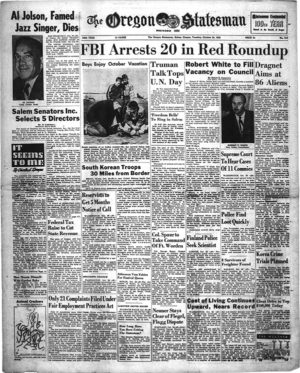 Oct 23: Justice Department begins nationwide roundup of Communists. With the remaining provisions of the new Internal Security Law going into effect today, the Justice Department begins a country-wide roundup of eighty-six people accused of being alien Communists. The new law is commonly known as the McCarran Act for the bill’s sponsor, Sen. Pat McCarran (D-NV). Congress had passed it a month ago over President Harry Truman’s veto. Under the McCarran Act, Communist organizations and their members are required to register with the Attorney General. The law also prohibits the employment of Communists in the federal government, prevents Communists from holding passports, and sets up the Subversive Activities Control Board to ferret out suspected Communists. Most controversial is a prevision within the act called the “Detention Act,” which gives the President the power to declare an emergency and place suspected Communists or Communist sympathizers into concentration camps. Today’s roundup is unrelated to the Detention Act, but is being carried out under “alien control” provisions in the new law. Those detained will either be deported or, if their country of origin refuses to accept them, they will be put under six month’s detention. If after six months they still can’t be deported, the aliens will be subject to indefinite surveillance by the Immigration Service. As for the Detention Act provisions, FBI director J. Edgar Hoover says that he already has a list of 12,000 “dangerous Communists,” about half of them U.S. citizens, that the bureau is prepared to round up when such an emergency is declared.
Oct 23: Justice Department begins nationwide roundup of Communists. With the remaining provisions of the new Internal Security Law going into effect today, the Justice Department begins a country-wide roundup of eighty-six people accused of being alien Communists. The new law is commonly known as the McCarran Act for the bill’s sponsor, Sen. Pat McCarran (D-NV). Congress had passed it a month ago over President Harry Truman’s veto. Under the McCarran Act, Communist organizations and their members are required to register with the Attorney General. The law also prohibits the employment of Communists in the federal government, prevents Communists from holding passports, and sets up the Subversive Activities Control Board to ferret out suspected Communists. Most controversial is a prevision within the act called the “Detention Act,” which gives the President the power to declare an emergency and place suspected Communists or Communist sympathizers into concentration camps. Today’s roundup is unrelated to the Detention Act, but is being carried out under “alien control” provisions in the new law. Those detained will either be deported or, if their country of origin refuses to accept them, they will be put under six month’s detention. If after six months they still can’t be deported, the aliens will be subject to indefinite surveillance by the Immigration Service. As for the Detention Act provisions, FBI director J. Edgar Hoover says that he already has a list of 12,000 “dangerous Communists,” about half of them U.S. citizens, that the bureau is prepared to round up when such an emergency is declared.
![]() Oct 23: Communists must register with the Justice Department. Under the McCarran Act, this is also the last day for Communists and members of alleged Communist-front groups to register with the Justice Department. Those who fail to register face jail terms of up to five years and fines of up to $10,000 (about $105,000 today) for each day of non-registration. Representatives of designated organizations already have announced that they will refuse to register and will fight the law in court. Attorney General J. Howard McGrath promises “vigorous enforcement,” although it may take two to four years of investigations and legal actions before the first cases result in penalties for refusing to register.
Oct 23: Communists must register with the Justice Department. Under the McCarran Act, this is also the last day for Communists and members of alleged Communist-front groups to register with the Justice Department. Those who fail to register face jail terms of up to five years and fines of up to $10,000 (about $105,000 today) for each day of non-registration. Representatives of designated organizations already have announced that they will refuse to register and will fight the law in court. Attorney General J. Howard McGrath promises “vigorous enforcement,” although it may take two to four years of investigations and legal actions before the first cases result in penalties for refusing to register.
![]() Oct 23: McCarthy accuses scientists, including one Nobel Prize winner, of Communist ties. On the occasion of the last provisions of the McCarran Act going into effect, Sen. Joseph McCarthy (R-WI) takes to the Senate floor, where he enjoys immunity from libel suits, and renews his attacks on alleged Communists in government employment. This time, he aims his charges against the Atomic Energy Commission, charging that it has “ignored” the problem or treated it “far too lightly.” He also accuses the American Federation of Scientists of being “heavily infiltrated with Communist fellow-travelers.” He attacks a Harvard professor, by name, as having been “affiliated with upward of forty Communist front organizations.” He also names five other scientists, including Nobel Prize winner Harold C. Urey. Urey responds that he hasn’t worked with the AEC or any other classified governmental project since 1945. “One very good reason I haven’t.” he says, “is that there are too many ignorant politicians of the McCarthy kind who hide behind immunity to abuse and slander those engaged in secret research. Long ago I decided life is too short to spend one’s time defending himself and at the same time trying to do scientific research.” Nuclear physicist Philip Morrison, who McCarthy also names, denies McCarthy’s allegations and adds, “When Senator McCarthy approves of my activities, I shall have reason to be concerned about my patriotism.”
Oct 23: McCarthy accuses scientists, including one Nobel Prize winner, of Communist ties. On the occasion of the last provisions of the McCarran Act going into effect, Sen. Joseph McCarthy (R-WI) takes to the Senate floor, where he enjoys immunity from libel suits, and renews his attacks on alleged Communists in government employment. This time, he aims his charges against the Atomic Energy Commission, charging that it has “ignored” the problem or treated it “far too lightly.” He also accuses the American Federation of Scientists of being “heavily infiltrated with Communist fellow-travelers.” He attacks a Harvard professor, by name, as having been “affiliated with upward of forty Communist front organizations.” He also names five other scientists, including Nobel Prize winner Harold C. Urey. Urey responds that he hasn’t worked with the AEC or any other classified governmental project since 1945. “One very good reason I haven’t.” he says, “is that there are too many ignorant politicians of the McCarthy kind who hide behind immunity to abuse and slander those engaged in secret research. Long ago I decided life is too short to spend one’s time defending himself and at the same time trying to do scientific research.” Nuclear physicist Philip Morrison, who McCarthy also names, denies McCarthy’s allegations and adds, “When Senator McCarthy approves of my activities, I shall have reason to be concerned about my patriotism.”
![]()
 Oct 23: Al Jolson dies. Entertainer Al Jolson dies of a heart attack while playing cards with friends at the St. Francis Hotel in San Francisco, California. He had just returned to the U.S. after entertaining troops in Korea. Jolson starred in “The Jazz Singer,” the 1927 film that heralded the arrival of “talkies” and which gave him his nickname for most of his career. Jolson, an otherwise well-regarded interpreter of jazz and African-American music for white audiences, often performed in blackface while popularizing such songs as “Swanee,” “My Mammy,” and “Rock-a-Bye Your Baby with a Dixie Melody.”
Oct 23: Al Jolson dies. Entertainer Al Jolson dies of a heart attack while playing cards with friends at the St. Francis Hotel in San Francisco, California. He had just returned to the U.S. after entertaining troops in Korea. Jolson starred in “The Jazz Singer,” the 1927 film that heralded the arrival of “talkies” and which gave him his nickname for most of his career. Jolson, an otherwise well-regarded interpreter of jazz and African-American music for white audiences, often performed in blackface while popularizing such songs as “Swanee,” “My Mammy,” and “Rock-a-Bye Your Baby with a Dixie Melody.”
![]()
 Oct 23: New 1951 Mercuries unveiled. The Lincoln-Mercury division of the Ford Motor Company introduces the 1951 Mercury line today. A new option for this model year is the Merc-O-Matic automatic transmission, which adds $168.50 (about $1,800 toady) to the price. Models for 1951 include the standard coup ($1,979, or $20,600 today), the Monterey coup ($2,245, or $23,400 today), a four-door sedan ($2,129, or $22,200 today), a six-passenger convertible ($2,515, or $26,250 today) and station wagon ($2,665, or $27,800 today).
Oct 23: New 1951 Mercuries unveiled. The Lincoln-Mercury division of the Ford Motor Company introduces the 1951 Mercury line today. A new option for this model year is the Merc-O-Matic automatic transmission, which adds $168.50 (about $1,800 toady) to the price. Models for 1951 include the standard coup ($1,979, or $20,600 today), the Monterey coup ($2,245, or $23,400 today), a four-door sedan ($2,129, or $22,200 today), a six-passenger convertible ($2,515, or $26,250 today) and station wagon ($2,665, or $27,800 today).
▲Tuesday, October 24
![]()
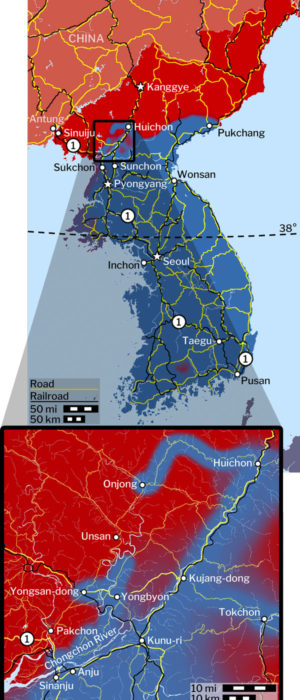 Oct 24: Korean War: U.S. 8th Army Command moves into Kim Il Sung’s office. Lt. Gen. Walton H. Walker, commander of the U.S. Eighth Army who oversaw the desperate defense of the Pusan (Busan) Perimiter in August and September, takes personal command of his advance Eight Army headquarters in the undamaged gray block building in Pyongyang which had previously been the headquarters of North Korea’s Premier Kim Il Sung. Meanwhile, and although there has been no official announcement from North Korea, it appears that Premier Kim Il Sung has moved his government from Sinuiju to the mountainous stronghold of Kanggye, which is also where much of the remnants of North Korea’s army is gathering. This rugged mountainous region was for decades a base of operations for the guerrilla campaigns against Japanese occupiers through most of the first half of the twentieth century. Kim Il Sung’s own guerrilla movement had its base of operations during and after World War II. Kanggye also enjoys easy access to China, by a narrow and winding road, and also by rail, which is something of a rarity in far northern Korea.
Oct 24: Korean War: U.S. 8th Army Command moves into Kim Il Sung’s office. Lt. Gen. Walton H. Walker, commander of the U.S. Eighth Army who oversaw the desperate defense of the Pusan (Busan) Perimiter in August and September, takes personal command of his advance Eight Army headquarters in the undamaged gray block building in Pyongyang which had previously been the headquarters of North Korea’s Premier Kim Il Sung. Meanwhile, and although there has been no official announcement from North Korea, it appears that Premier Kim Il Sung has moved his government from Sinuiju to the mountainous stronghold of Kanggye, which is also where much of the remnants of North Korea’s army is gathering. This rugged mountainous region was for decades a base of operations for the guerrilla campaigns against Japanese occupiers through most of the first half of the twentieth century. Kim Il Sung’s own guerrilla movement had its base of operations during and after World War II. Kanggye also enjoys easy access to China, by a narrow and winding road, and also by rail, which is something of a rarity in far northern Korea.
![]() Oct 24: Korean War: South Koreans, British cross the Chongchon River. After overnight repairs to a wooden bridge at Anju, the ROK 1st Division crosses the Chongchon River and attacks northeast to Yongbyon and Yongsan-dong. From there, they turn northeast toward Unsan. Just a few miles downstream at Sinanju where the Chongchon is much wider, the British Middlesex 1st Battalion crosses in assault boats and moves north toward Pakchon. With these actions, U.N. forces have breeched the last major river barrier south of the Chinese border. Further up the Chongchon valley, the ROK 8th Division arrives at Kujang-dong after taking Tokchon two days before, and the ROK 6th Division at Huichon leaves the valley and moves west to Onjong, arriving there at night.
Oct 24: Korean War: South Koreans, British cross the Chongchon River. After overnight repairs to a wooden bridge at Anju, the ROK 1st Division crosses the Chongchon River and attacks northeast to Yongbyon and Yongsan-dong. From there, they turn northeast toward Unsan. Just a few miles downstream at Sinanju where the Chongchon is much wider, the British Middlesex 1st Battalion crosses in assault boats and moves north toward Pakchon. With these actions, U.N. forces have breeched the last major river barrier south of the Chinese border. Further up the Chongchon valley, the ROK 8th Division arrives at Kujang-dong after taking Tokchon two days before, and the ROK 6th Division at Huichon leaves the valley and moves west to Onjong, arriving there at night.
![]() Oct 24: Korean War: U.N. Soldier’s predict war’s end by Thanksgiving. Moral is high among U.N. troops. Many are already making plans to be back in Tokyo by Thanksgiving. The 1st Cavalry Division is even starting to turn in some of its equipment on the expectation of being the first organization to be sent back to Japan.
Oct 24: Korean War: U.N. Soldier’s predict war’s end by Thanksgiving. Moral is high among U.N. troops. Many are already making plans to be back in Tokyo by Thanksgiving. The 1st Cavalry Division is even starting to turn in some of its equipment on the expectation of being the first organization to be sent back to Japan.
![]() Oct 24: MacArthur lifts order barring non-South Korean troops on the Chinese border. As the leading U.N. forces are crossing the Chongchon River, Gen. Douglas MacArthur, without consulting with the U.S. Joint Chiefs of Staff in Washington, D.C., lifts his October 17 order prohibiting all U.N. forces, except for the South’s Republic of Korea (ROK) forces, from crossing a line that runs about 35 miles (55 km) south of the Chinese border. Last week’s order, which replaced an earlier order establishing a line further south, was based on a September 27 directive from the Joint Chiefs to avoid approaching the Chinese border and triggering their intervention in the war. MacArthur now instructs his commanders to press forward all the way to the Yalu River. The next day, the Joint Chiefs will send a message asking for an explanation. MacArthur will reply that ROK forces can’t complete the task by themselves, despite the impressive gains they have been making the past few weeks. MacArthur will also claim that the whole subject had been discussed at the Wake Island conference with President Truman, ignoring the fact that his previous order had been issued following the Wake Island meeting.
Oct 24: MacArthur lifts order barring non-South Korean troops on the Chinese border. As the leading U.N. forces are crossing the Chongchon River, Gen. Douglas MacArthur, without consulting with the U.S. Joint Chiefs of Staff in Washington, D.C., lifts his October 17 order prohibiting all U.N. forces, except for the South’s Republic of Korea (ROK) forces, from crossing a line that runs about 35 miles (55 km) south of the Chinese border. Last week’s order, which replaced an earlier order establishing a line further south, was based on a September 27 directive from the Joint Chiefs to avoid approaching the Chinese border and triggering their intervention in the war. MacArthur now instructs his commanders to press forward all the way to the Yalu River. The next day, the Joint Chiefs will send a message asking for an explanation. MacArthur will reply that ROK forces can’t complete the task by themselves, despite the impressive gains they have been making the past few weeks. MacArthur will also claim that the whole subject had been discussed at the Wake Island conference with President Truman, ignoring the fact that his previous order had been issued following the Wake Island meeting.
▲Wednesday, October 25
![]() Oct 25: Korean war: Pentagon begins planning for the war’s end. The war in Korea has been going so well in recent weeks that the Pentagon is now making plans for the war’s end. The Department of the Army is making plans to redeploy units to the U.S. or Europe. Already, all ships loaded with ammunition arriving in Asia re being diverted to Japan on the belief that there is plenty on hand in Korea to complete the job. Some of those ships are even being sent back to Hawaii or the U.S. mainland. Ammunition ships still in port in in San Francisco are ordered to unload. Today, the Army notifies MacArthur that it is planning to cancel shipment of enlisted reserve corps troops to Asia that had been scheduled for October and November.
Oct 25: Korean war: Pentagon begins planning for the war’s end. The war in Korea has been going so well in recent weeks that the Pentagon is now making plans for the war’s end. The Department of the Army is making plans to redeploy units to the U.S. or Europe. Already, all ships loaded with ammunition arriving in Asia re being diverted to Japan on the belief that there is plenty on hand in Korea to complete the job. Some of those ships are even being sent back to Hawaii or the U.S. mainland. Ammunition ships still in port in in San Francisco are ordered to unload. Today, the Army notifies MacArthur that it is planning to cancel shipment of enlisted reserve corps troops to Asia that had been scheduled for October and November.
![]()
 Oct 25: South Korean troops get within 18 miles of China. Parts of the ROK 6th Division leaves Onjong and advances rapidly north to Kojang, just eighteen air miles (29 km) from its objective at Chosan on the Chinese border. It is now far in front of any other U.N. division.
Oct 25: South Korean troops get within 18 miles of China. Parts of the ROK 6th Division leaves Onjong and advances rapidly north to Kojang, just eighteen air miles (29 km) from its objective at Chosan on the Chinese border. It is now far in front of any other U.N. division.
![]() Oct 25: Chinese troops destroy South Korean battalion at Pukchin. the ROK 6th Division’s 3rd Battalion, 2nd Regiment moves northwest from Onjong and heads for Pukchin and, ultimately, Pyoktong, also on the Chinese border. But eight miles (13 km) west of Onjong the battalion comes under enemy fire. Troops dismount from their vehicles, expecting to deal with a small force of North Koreans. Instead, they discover that the roadblock is a Chinese trap. The Chinese soldiers destroys the battalion as an organized force, although about 400 of the 750 South Korean solders make their way back to Onjong. The 3rd Battalion is sent out from Onjong to relieve the 2nd, only to discover enemy soldiers moving in the hills north of the road. Patrols sent out to investigate return with a Chinese prisoner, who says that Chinese forces have been waiting in the mountains around Pukchin since October 17.
Oct 25: Chinese troops destroy South Korean battalion at Pukchin. the ROK 6th Division’s 3rd Battalion, 2nd Regiment moves northwest from Onjong and heads for Pukchin and, ultimately, Pyoktong, also on the Chinese border. But eight miles (13 km) west of Onjong the battalion comes under enemy fire. Troops dismount from their vehicles, expecting to deal with a small force of North Koreans. Instead, they discover that the roadblock is a Chinese trap. The Chinese soldiers destroys the battalion as an organized force, although about 400 of the 750 South Korean solders make their way back to Onjong. The 3rd Battalion is sent out from Onjong to relieve the 2nd, only to discover enemy soldiers moving in the hills north of the road. Patrols sent out to investigate return with a Chinese prisoner, who says that Chinese forces have been waiting in the mountains around Pukchin since October 17.
![]() Oct 25: Chinese forces discovered north of Unsan. South of the fighting in Onjong, the ROK 1st Division, accompanied by American tanks, is strung out along a road running from the Chonchon River to Unsan. Just before 11:00 a.m. as a tank battalion is approaching a bridge 1½ miles (2½ km) northeast of town, enemy mortar fire brings the column to a halt. ROK forces engage the enemy, and discover about 300 Chinese troops in the hills north of Unsan. A captured Chinese soldier says there are about 10,000 Chinese soldiers in the hills north and northwest of Unsan, and another 10,000 over towards Huinchon. Another ROK column which turned west from Unsan also encounters Chinese troops blocking the way. By nightfall, it becomes apparent that the Chinese have nearly surrounded Unsan.
Oct 25: Chinese forces discovered north of Unsan. South of the fighting in Onjong, the ROK 1st Division, accompanied by American tanks, is strung out along a road running from the Chonchon River to Unsan. Just before 11:00 a.m. as a tank battalion is approaching a bridge 1½ miles (2½ km) northeast of town, enemy mortar fire brings the column to a halt. ROK forces engage the enemy, and discover about 300 Chinese troops in the hills north of Unsan. A captured Chinese soldier says there are about 10,000 Chinese soldiers in the hills north and northwest of Unsan, and another 10,000 over towards Huinchon. Another ROK column which turned west from Unsan also encounters Chinese troops blocking the way. By nightfall, it becomes apparent that the Chinese have nearly surrounded Unsan.
![]() Oct 25: In the coastal area, the 27 British Commonwealth Brigade crosses the Taeryong River at Pakchon, where it meets enemy opposition on the west side. The battles that unfold over the next three days convinces the commander that the days of “rolling” are over for the time being.
Oct 25: In the coastal area, the 27 British Commonwealth Brigade crosses the Taeryong River at Pakchon, where it meets enemy opposition on the west side. The battles that unfold over the next three days convinces the commander that the days of “rolling” are over for the time being.
![]()
 Oct 25: Peiping Radio broadcasts “salutes” to the “People’s Army advancing toward Tibet. The radio broadcast says that a political mobilization directive has been issued to “People’s Army units which have been ordered to advance into Tibet to free three million Tibetans from imperialist oppression and to consolidate national defenses of the western borders of China.” The broadcast ads: “Every effort must be made to enhance the economic and cultural development of Tibet as soon as hostilities come to an end.” Representatives of the Chinese Communist government have been negotiating with the Chinese Ambassador to India in New Delhi, but the Ambassador recommended that the Tibet representatives go to Peiping (Beijing) instead. Tibet had been a highly autonomous region in China for centuries, but it became effectively independent after the Republic of China overthrew the Qing dynasty in 1912. The Republic was never able to assert control over the entire country. Both the Chinese Communists and the Republicans (Nationalists) on Taiwan still consider Tibet a part of China, and no other nation has recognized Tibet’s independence. This is the first acknowledgement from Peiping that their army has entered Tibet. The People’s Liberation Army had completed it siege of a small Tibetan garrison at Chamdo (Quamdo) almost a week ago after crossing into eastern Tibet on October 6. But due to poor communication and road links between Chamdo and Lhasa, the incursion has gone largely unnoticed by the outside world, and authorities in Lhasa and Peiping have denied that an invasion has taken place. Even now, U.S. State Department observers still dismiss the likelihood that Chinese troops have entered eastern Tibet. Citing the high altitudes and brutal winter weather that has already descended on the region, observers still say that any such invasion won’t occur for several more months.
Oct 25: Peiping Radio broadcasts “salutes” to the “People’s Army advancing toward Tibet. The radio broadcast says that a political mobilization directive has been issued to “People’s Army units which have been ordered to advance into Tibet to free three million Tibetans from imperialist oppression and to consolidate national defenses of the western borders of China.” The broadcast ads: “Every effort must be made to enhance the economic and cultural development of Tibet as soon as hostilities come to an end.” Representatives of the Chinese Communist government have been negotiating with the Chinese Ambassador to India in New Delhi, but the Ambassador recommended that the Tibet representatives go to Peiping (Beijing) instead. Tibet had been a highly autonomous region in China for centuries, but it became effectively independent after the Republic of China overthrew the Qing dynasty in 1912. The Republic was never able to assert control over the entire country. Both the Chinese Communists and the Republicans (Nationalists) on Taiwan still consider Tibet a part of China, and no other nation has recognized Tibet’s independence. This is the first acknowledgement from Peiping that their army has entered Tibet. The People’s Liberation Army had completed it siege of a small Tibetan garrison at Chamdo (Quamdo) almost a week ago after crossing into eastern Tibet on October 6. But due to poor communication and road links between Chamdo and Lhasa, the incursion has gone largely unnoticed by the outside world, and authorities in Lhasa and Peiping have denied that an invasion has taken place. Even now, U.S. State Department observers still dismiss the likelihood that Chinese troops have entered eastern Tibet. Citing the high altitudes and brutal winter weather that has already descended on the region, observers still say that any such invasion won’t occur for several more months.
▲Thursday, October 26
![]()
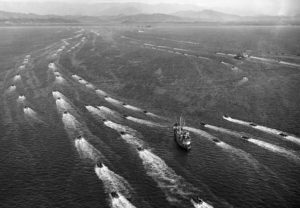 Oct 26: U.N. Marines land in Wonsan. The 1st Marine Division finally — finally! — lands in Wonsan, after a long comedy of errors that turned what was supposed to be a daring amphibious assault into an embarrassing arrival at a city that has been in South Korean and U.S. Army hands for weeks. The whole farce began soon after Seoul’s liberation, when Gen. Douglas MacArthur decided to repeat the 1st Marine Division’s successful landing behind enemy lines at Inchon (Incheon) with another spectacular landing behind enemy lines at Wonsan. The first problem, however, was that the South’s Republic of Korea (ROK) 3rd and Capital Divisions decided not stand on ceremony and blew right past the 38th Parallel. They were in Wonsan while the 1st Marine Division was still trying to get its personnel and equipment loaded onto ships and landing craft at Inchon. And speaking of which, because of the Inchon port’s limited capacity, for every hour spent loading the 1st Marines and their supplies at Inchon, that’s an hour that was unavailable for ships to unload desperately needed supplies for the battles north of Seoul. Then, when the Marines finally make it to Wonson, they are kept out at sea for six extra days while minesweepers struggle to clear the port of thousands of Soviet mines. After traveling up and down the coast outside of Wonsan, in what Marines have called “Operation Yo-yo,” they are finally directed on shore through a very narrow, cleared channel to the beach. There, they find that ROK and U.S. Army personnel already have the situation well at hand. They’ve even gotten around to renaming a street MacArthur Boulevard. The Marine “assault” yields impressive photographs for newspapers and magazines back home, but Marines ambling about on the beach are calling it “Operation What-the-Hell.” Says Lt. Raymond J. Elledge of San Gabriel, California, “Nobody likes to get shot at going ashore, but this isn’t the way the Marine Corps works. This is more like an Army job.”
Oct 26: U.N. Marines land in Wonsan. The 1st Marine Division finally — finally! — lands in Wonsan, after a long comedy of errors that turned what was supposed to be a daring amphibious assault into an embarrassing arrival at a city that has been in South Korean and U.S. Army hands for weeks. The whole farce began soon after Seoul’s liberation, when Gen. Douglas MacArthur decided to repeat the 1st Marine Division’s successful landing behind enemy lines at Inchon (Incheon) with another spectacular landing behind enemy lines at Wonsan. The first problem, however, was that the South’s Republic of Korea (ROK) 3rd and Capital Divisions decided not stand on ceremony and blew right past the 38th Parallel. They were in Wonsan while the 1st Marine Division was still trying to get its personnel and equipment loaded onto ships and landing craft at Inchon. And speaking of which, because of the Inchon port’s limited capacity, for every hour spent loading the 1st Marines and their supplies at Inchon, that’s an hour that was unavailable for ships to unload desperately needed supplies for the battles north of Seoul. Then, when the Marines finally make it to Wonson, they are kept out at sea for six extra days while minesweepers struggle to clear the port of thousands of Soviet mines. After traveling up and down the coast outside of Wonsan, in what Marines have called “Operation Yo-yo,” they are finally directed on shore through a very narrow, cleared channel to the beach. There, they find that ROK and U.S. Army personnel already have the situation well at hand. They’ve even gotten around to renaming a street MacArthur Boulevard. The Marine “assault” yields impressive photographs for newspapers and magazines back home, but Marines ambling about on the beach are calling it “Operation What-the-Hell.” Says Lt. Raymond J. Elledge of San Gabriel, California, “Nobody likes to get shot at going ashore, but this isn’t the way the Marine Corps works. This is more like an Army job.”
![]()
 Oct 26: South Koreans move toward Chosin Reservoir, capture Chinese prisoner. In northeast Korea, the ROK 3rd Division continues its attacks north from the Hamhung area toward the Chosin (Changjin) Reservoir, which sits in the heart of the rugged Taebaek Mountain range. The Taebaeks are characterized by peaks of 6,000 feet (1,800 m) or more, steep slopes, narrow and twisting valleys, and very poor roads, most of which are barely more than mountain trails. Winter temperatures often reach -20°F to -30°F (-30°C to -35°C) The ROK 3rd reaches the first and second hydroelectric plants of the Chosin (Changjin) Reservoir area, about halfway between Hungnam and the reservoir itself. There, a regiment captures a prisoner who is definitively identified as a Chinese soldier. The prisoner says that he’s part of the 5th Regiment of the Chinese 8th Army, and that there are between 4,000 and 5,000 Chinese soldiers in the immediate area.
Oct 26: South Koreans move toward Chosin Reservoir, capture Chinese prisoner. In northeast Korea, the ROK 3rd Division continues its attacks north from the Hamhung area toward the Chosin (Changjin) Reservoir, which sits in the heart of the rugged Taebaek Mountain range. The Taebaeks are characterized by peaks of 6,000 feet (1,800 m) or more, steep slopes, narrow and twisting valleys, and very poor roads, most of which are barely more than mountain trails. Winter temperatures often reach -20°F to -30°F (-30°C to -35°C) The ROK 3rd reaches the first and second hydroelectric plants of the Chosin (Changjin) Reservoir area, about halfway between Hungnam and the reservoir itself. There, a regiment captures a prisoner who is definitively identified as a Chinese soldier. The prisoner says that he’s part of the 5th Regiment of the Chinese 8th Army, and that there are between 4,000 and 5,000 Chinese soldiers in the immediate area.
![]() Oct 26: South Korean force reaches the Chinese border. The ROK 6th Division’s Reconnaissance Platoon moves northward from Kojang and enters Chosan, where they find retreating North Koreans crossing the Yalu River over a floating footbridge into China . U.S. military adviser Maj. Harry Fleming accompanies the group. This is the first U.N. unit to reach the northern border with China.
Oct 26: South Korean force reaches the Chinese border. The ROK 6th Division’s Reconnaissance Platoon moves northward from Kojang and enters Chosan, where they find retreating North Koreans crossing the Yalu River over a floating footbridge into China . U.S. military adviser Maj. Harry Fleming accompanies the group. This is the first U.N. unit to reach the northern border with China.
![]() Oct 26: Chinese troops drive South Koreans from Onjong. At 3:00 a.m., the Chinese attack other elements of the ROK 6th Division at Onjong. The South Koreans panic before officers succeed in re-organizing them at the southeast edge of town. When the Chinese attack this position at 6:00 a.m., the ROK starts withdrawing eastward, only to discover a Chinese roadblock at their rear three miles from Onjing. The ROK scatters into the hills. Two U.S. military advisers make it to Huichon, but a third is captured. Most of the South Koreans will make their way to the Chongchon River. That evening, the 6th Division’s 7th Regiment in Kojang, which had been planning to send a full occupation force to Chosan the next morning, is ordered to retreat south to rejoin the division. The regiment, however, decides it can’t fight its way south unless it is resupplied with fuel, food, and ammunition. An airdrop two days later will resupply the regiment and allow it to withdraw south over the next two days.
Oct 26: Chinese troops drive South Koreans from Onjong. At 3:00 a.m., the Chinese attack other elements of the ROK 6th Division at Onjong. The South Koreans panic before officers succeed in re-organizing them at the southeast edge of town. When the Chinese attack this position at 6:00 a.m., the ROK starts withdrawing eastward, only to discover a Chinese roadblock at their rear three miles from Onjing. The ROK scatters into the hills. Two U.S. military advisers make it to Huichon, but a third is captured. Most of the South Koreans will make their way to the Chongchon River. That evening, the 6th Division’s 7th Regiment in Kojang, which had been planning to send a full occupation force to Chosan the next morning, is ordered to retreat south to rejoin the division. The regiment, however, decides it can’t fight its way south unless it is resupplied with fuel, food, and ammunition. An airdrop two days later will resupply the regiment and allow it to withdraw south over the next two days.
![]() Oct 26: U.S. intelligence downplays reports of Chinese forces despite attack at Unsan. Chinese forces attack an infantry unit of the ROK 1st Division, accompanied by an American tank battalion, north of Unsan. The Americans and South Koreans are pushed back to Unsan, where they discover that the Chinese have cut off a supply road to the south. The U.N. group digs in, but is prepared to withdraw at a moment’s notice. A air drop of supplies by ten C-119s the next morning will allow the ROK 1st to remain, and even gain some ground to the north and clear the roadblock to the south. Major Gen. Paik Sun Yup, commander of the ROK 1st Division, estimates that it is confronting a full division of about ten thousand Chinese troops. But U.S. 8th Army Intelligence concludes that the Chinese troops in Unsan and Onjong represent merely “some further reinforcement of North Korean units with personnel taken from the Chinese Communist forces, in order to assist in the defense of the border approaches.” The assessment adds that there are “no indications of open intervention on the part of Chinese Communist Forces in Korea.”
Oct 26: U.S. intelligence downplays reports of Chinese forces despite attack at Unsan. Chinese forces attack an infantry unit of the ROK 1st Division, accompanied by an American tank battalion, north of Unsan. The Americans and South Koreans are pushed back to Unsan, where they discover that the Chinese have cut off a supply road to the south. The U.N. group digs in, but is prepared to withdraw at a moment’s notice. A air drop of supplies by ten C-119s the next morning will allow the ROK 1st to remain, and even gain some ground to the north and clear the roadblock to the south. Major Gen. Paik Sun Yup, commander of the ROK 1st Division, estimates that it is confronting a full division of about ten thousand Chinese troops. But U.S. 8th Army Intelligence concludes that the Chinese troops in Unsan and Onjong represent merely “some further reinforcement of North Korean units with personnel taken from the Chinese Communist forces, in order to assist in the defense of the border approaches.” The assessment adds that there are “no indications of open intervention on the part of Chinese Communist Forces in Korea.”
▲Friday, October 27
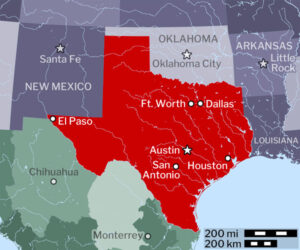 Oct 27: Texas Regents drop race ban at El Paso stadium. Texas Western College will no longer have to worry about the racial composition of its competitors when it schedules home games at El Paso. The University of Texas Regents, which oversees the entire state university system, lifts a ban against Negro football players competing against white students at Kidd Field. The El Paso Chamber of Commerce had petitioned for the rule change after Loyola University of Los Angeles chose to forfeit a game at El Paso scheduled for last month rather than bench their black players for the game. The Regents vote 6-3 to remove the racial barrier only for Texas Western which, due to its geographic remoteness, mostly plays out-of-state teams, many of which have black players. Maintaining the racial ban, says the Regents, “will completely destroy intercollegiate athletics at Texas Western College.” Also, the Regents note, “The stadium was constructed with funds provided partly by the citizens of El Paso and partly by the City of El Paso,” which gives the Regents some technical ground on which to change their policy. Regents chairman Dudley Woodward emphasizes that the move “constitutes no change in policy of the Board of Regents with reference to any other branch of the University of Texas” and “relates wholly to the peculiar conditions existing at Texas Western College.” The three Regents voting against the rule change are prominent San Antonio arts patron Margaret Lynn Tobin, Houston businessman James Rockwell, and Nacogdoches businessman Edward B. Tucker.
Oct 27: Texas Regents drop race ban at El Paso stadium. Texas Western College will no longer have to worry about the racial composition of its competitors when it schedules home games at El Paso. The University of Texas Regents, which oversees the entire state university system, lifts a ban against Negro football players competing against white students at Kidd Field. The El Paso Chamber of Commerce had petitioned for the rule change after Loyola University of Los Angeles chose to forfeit a game at El Paso scheduled for last month rather than bench their black players for the game. The Regents vote 6-3 to remove the racial barrier only for Texas Western which, due to its geographic remoteness, mostly plays out-of-state teams, many of which have black players. Maintaining the racial ban, says the Regents, “will completely destroy intercollegiate athletics at Texas Western College.” Also, the Regents note, “The stadium was constructed with funds provided partly by the citizens of El Paso and partly by the City of El Paso,” which gives the Regents some technical ground on which to change their policy. Regents chairman Dudley Woodward emphasizes that the move “constitutes no change in policy of the Board of Regents with reference to any other branch of the University of Texas” and “relates wholly to the peculiar conditions existing at Texas Western College.” The three Regents voting against the rule change are prominent San Antonio arts patron Margaret Lynn Tobin, Houston businessman James Rockwell, and Nacogdoches businessman Edward B. Tucker.![]()
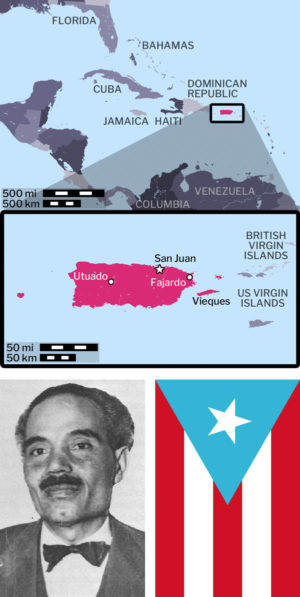 Oct 27: Utuado uprising: police arrest independence movement leaders. A nearly week-long uprising for Puerto Rico’s independence begins rather haphazardly when the Insular Police intercept two cars, including one carrying Pedro Albizu Campos, who is returning to San Juan following a political meeting in Fajardo. Albizu Campos’s car manages to escape, but police arrest all four occupants of the other car. Albizu Campo, the first Puerto Rican graduate from Harvard Law School, is a charismatic public speaker and head of the Puerto Rican Nationalist Party, a banned organization that calls for Puerto Rico’s independence from the U.S. He was released in 1947 from U.S. Federal prison after serving ten years for sedition. The Insular Police, which has very nearly arrested him, is more like a typical American state National Guard and is answerable to the conservative and authoritarian governor, Luis Muñoz Marín. In 1948, as Senate president, Muñoz Marín ushered through the legislature the repressive Gag Law, which makes it a felony to advocate for Puerto Rico’s independence, to speak against the U.S. government, or to print, publish, exhibit or sell any material “intended to paralyze or destroy the insular government.” It even makes it a felony to own or display the Puerto Rican flag, even in the privacy of one’s own home. Despite the law’s obvious violations of the First Amendment of the U.S. Constitution, Muñoz Marín, governor since January 1949, has used this law to arrest, without due process, thousands of Puerto Ricans — not just Nationalists, but political opponents as well. On July 3, when President Harry Truman signed the Puerto Rico Federal Relations Act defining Puerto Rico as a “Free Associated State,” Albizu Campos denounced it as a continuation of American colonialism. His Nationalists began planning for an uprising tentatively set for 1952 when Puerto Rico is expected to enter Commonwealth status. After this encounter with police on the road from Fajardo, Albizu Campos returns to his home in San Juan, which is soon surrounded by Insular police. Albizu Campos abrubtly pulls up the revolutions timetable to October 30. Nationalists in eight towns across Puerto Rico are ordered to simultaneously burn down police headquarters, U.S. Post Offices and draft boards at noon. They are then to converge on Utuado in the central mountains, and hold out there in the hope that the violence will draw international attention and support from the United Nations.
Oct 27: Utuado uprising: police arrest independence movement leaders. A nearly week-long uprising for Puerto Rico’s independence begins rather haphazardly when the Insular Police intercept two cars, including one carrying Pedro Albizu Campos, who is returning to San Juan following a political meeting in Fajardo. Albizu Campos’s car manages to escape, but police arrest all four occupants of the other car. Albizu Campo, the first Puerto Rican graduate from Harvard Law School, is a charismatic public speaker and head of the Puerto Rican Nationalist Party, a banned organization that calls for Puerto Rico’s independence from the U.S. He was released in 1947 from U.S. Federal prison after serving ten years for sedition. The Insular Police, which has very nearly arrested him, is more like a typical American state National Guard and is answerable to the conservative and authoritarian governor, Luis Muñoz Marín. In 1948, as Senate president, Muñoz Marín ushered through the legislature the repressive Gag Law, which makes it a felony to advocate for Puerto Rico’s independence, to speak against the U.S. government, or to print, publish, exhibit or sell any material “intended to paralyze or destroy the insular government.” It even makes it a felony to own or display the Puerto Rican flag, even in the privacy of one’s own home. Despite the law’s obvious violations of the First Amendment of the U.S. Constitution, Muñoz Marín, governor since January 1949, has used this law to arrest, without due process, thousands of Puerto Ricans — not just Nationalists, but political opponents as well. On July 3, when President Harry Truman signed the Puerto Rico Federal Relations Act defining Puerto Rico as a “Free Associated State,” Albizu Campos denounced it as a continuation of American colonialism. His Nationalists began planning for an uprising tentatively set for 1952 when Puerto Rico is expected to enter Commonwealth status. After this encounter with police on the road from Fajardo, Albizu Campos returns to his home in San Juan, which is soon surrounded by Insular police. Albizu Campos abrubtly pulls up the revolutions timetable to October 30. Nationalists in eight towns across Puerto Rico are ordered to simultaneously burn down police headquarters, U.S. Post Offices and draft boards at noon. They are then to converge on Utuado in the central mountains, and hold out there in the hope that the violence will draw international attention and support from the United Nations.
▲Saturday, October 28
![]()
 Oct 28: Korean War: South Koreans gain on east coast, encounter more Chinese soldiers south of Chosin Reservoir. On Korea’s east coast, the South’s Republic of Korea (ROK) Capital Division continues its attack along the coastal road against strong opposition and captures Songjin (present-day Kimchaek). A Cap Division regiment pushes rapidly northward and approaches Pungsan, which is about halfway to Hyesanjin (Hyesan) on the Chinese border. West of there on the road from Hamhung to the Chosin (Changkin) Reservoir, ROK forces move very slowly against increasing resistance as they approach the treacherous Funchilin Pass. They suffer very heavy casualties at Sudon. ROK patrols sent to Sinhung and Koto-ri return with news that they have seen what they believe to be Chinese soldiers. That same day, two Chinese soldiers are captured one mile (1½ km) west of Sudong.
Oct 28: Korean War: South Koreans gain on east coast, encounter more Chinese soldiers south of Chosin Reservoir. On Korea’s east coast, the South’s Republic of Korea (ROK) Capital Division continues its attack along the coastal road against strong opposition and captures Songjin (present-day Kimchaek). A Cap Division regiment pushes rapidly northward and approaches Pungsan, which is about halfway to Hyesanjin (Hyesan) on the Chinese border. West of there on the road from Hamhung to the Chosin (Changkin) Reservoir, ROK forces move very slowly against increasing resistance as they approach the treacherous Funchilin Pass. They suffer very heavy casualties at Sudon. ROK patrols sent to Sinhung and Koto-ri return with news that they have seen what they believe to be Chinese soldiers. That same day, two Chinese soldiers are captured one mile (1½ km) west of Sudong.
![]() Oct 28: Chinese troops disperse South Koreans from Onjong On the other side of the impenetrable Taebaek Mountain range in north-central Korea, the ROK 8th Division at Huichon sends two regiments to Onjong in an attempt to recover abandoned vehicles and artillery pieces from the battle two days aerlier. The regiments reach a point where they can look down from the mountains overlooking Onjong and see the abandoned equipment, but they won’t get any closer. They will be attacked the next day and scattered into the hills, leaving behind their own vehicles and artillery. Southwest of there at Unson, the situation improved somewhat for South Korean defenders as they make slight gains north and west of town, and clear the southern supply road from Chinese roadblocks. To the west, American forces cross the Taeryong River above Pakchon and take Taechon, while the British Commonwealth Brigade pushes westward and comes to within three miles (5 km) of Chongju.
Oct 28: Chinese troops disperse South Koreans from Onjong On the other side of the impenetrable Taebaek Mountain range in north-central Korea, the ROK 8th Division at Huichon sends two regiments to Onjong in an attempt to recover abandoned vehicles and artillery pieces from the battle two days aerlier. The regiments reach a point where they can look down from the mountains overlooking Onjong and see the abandoned equipment, but they won’t get any closer. They will be attacked the next day and scattered into the hills, leaving behind their own vehicles and artillery. Southwest of there at Unson, the situation improved somewhat for South Korean defenders as they make slight gains north and west of town, and clear the southern supply road from Chinese roadblocks. To the west, American forces cross the Taeryong River above Pakchon and take Taechon, while the British Commonwealth Brigade pushes westward and comes to within three miles (5 km) of Chongju.
![]()
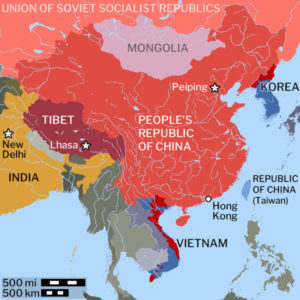 Oct 28: India confirms that China has ordered troops into Tibet. India’s Foreign Office announces that K.M. Panikkar, India’s Ambassador to Peiping (Beijing) has received confirmation that Communist China has, in fact, ordered its troops to enter Tibet. India’s agent in Lhasa, who is the only foreign representative in the Tibetan capital, has also notified New Delhi that the Dalai Lama’s government has received reports that Chinese troops are in the territory. The Foreign Office says that in light of these developments, India’s friendly policies toward the Peiping government, including its advocacy for Communist China’s admittance to the United Nations, has been “taken under very careful review.” Tibet is officially an autonomous region of China. It has never declared its independence and no other country recognizes Tibet. Observers believe that India will ultimately concede that China’s movement of troops into Tibet is an internal affair. But with several border disputes still unresolved between India and China, including regions bordering on Tibet, India is not eager to see Chinese troops stationed on India’s frontier.
Oct 28: India confirms that China has ordered troops into Tibet. India’s Foreign Office announces that K.M. Panikkar, India’s Ambassador to Peiping (Beijing) has received confirmation that Communist China has, in fact, ordered its troops to enter Tibet. India’s agent in Lhasa, who is the only foreign representative in the Tibetan capital, has also notified New Delhi that the Dalai Lama’s government has received reports that Chinese troops are in the territory. The Foreign Office says that in light of these developments, India’s friendly policies toward the Peiping government, including its advocacy for Communist China’s admittance to the United Nations, has been “taken under very careful review.” Tibet is officially an autonomous region of China. It has never declared its independence and no other country recognizes Tibet. Observers believe that India will ultimately concede that China’s movement of troops into Tibet is an internal affair. But with several border disputes still unresolved between India and China, including regions bordering on Tibet, India is not eager to see Chinese troops stationed on India’s frontier.
![]() Oct 28: Utuado uprising: 111 prison inmates escape from Puerto Rico prison. Complicating the situation in Puerto Rico where Nationalists are preparing to stage an uprising in their quest for independence, 111 inmates of the Rio Piedras Prison, ten miles form San Juan, overpower guards and escape. Two guards are killed in the worst mass prison escape in Puerto Rico’s history. The fiften-year-old prison was built to house a thousand inmates, but it currently holds 2,648 of the islands most violent prisoners. The overcrowding and generally poor conditions have sparked several instances of unrest. The breakout puts the government on high alert as it calls out the Insular Police and National Guard to round up the escapees. The National Guard mobilizes and immediately fans out across the island. There no indication that the prison break has anything to do with the Nationalists’ planned uprising. But Gov. Muñoz Marín will use the incident to justify harsh measures against the Nationalists.
Oct 28: Utuado uprising: 111 prison inmates escape from Puerto Rico prison. Complicating the situation in Puerto Rico where Nationalists are preparing to stage an uprising in their quest for independence, 111 inmates of the Rio Piedras Prison, ten miles form San Juan, overpower guards and escape. Two guards are killed in the worst mass prison escape in Puerto Rico’s history. The fiften-year-old prison was built to house a thousand inmates, but it currently holds 2,648 of the islands most violent prisoners. The overcrowding and generally poor conditions have sparked several instances of unrest. The breakout puts the government on high alert as it calls out the Insular Police and National Guard to round up the escapees. The National Guard mobilizes and immediately fans out across the island. There no indication that the prison break has anything to do with the Nationalists’ planned uprising. But Gov. Muñoz Marín will use the incident to justify harsh measures against the Nationalists.
![]() Oct 28: Southern newspaper editors denounce “campaign of smear, vilification and falshood against the South.” The Southern Newspaper Publishers Association, meeting in White Sulphur Springs, West Virginia, adopts a resolution against “a malicious, determined campaign of smear, vilification and falsehood against the South as a region.” James G. Stahlman, ultra-conservative publisher of the Nashville Banner, presents the resolution which directs the Association’s president to collect and distribute “facts” in defense of the South. The South, declares Stahlman, has maintained its character “despite the vicious assaults of political mountebanks, sociological crackpots and subversive malcontents.” J.N. Heiskell of Little Rock, Arkansas, suggests that the resolution is “somewhat intemperate and perhaps should be toned down.” But Stahlman, always the firebrand, counters that he has “no apologies for the wording in either the preamble or the text.” The original language is allowed to stand.
Oct 28: Southern newspaper editors denounce “campaign of smear, vilification and falshood against the South.” The Southern Newspaper Publishers Association, meeting in White Sulphur Springs, West Virginia, adopts a resolution against “a malicious, determined campaign of smear, vilification and falsehood against the South as a region.” James G. Stahlman, ultra-conservative publisher of the Nashville Banner, presents the resolution which directs the Association’s president to collect and distribute “facts” in defense of the South. The South, declares Stahlman, has maintained its character “despite the vicious assaults of political mountebanks, sociological crackpots and subversive malcontents.” J.N. Heiskell of Little Rock, Arkansas, suggests that the resolution is “somewhat intemperate and perhaps should be toned down.” But Stahlman, always the firebrand, counters that he has “no apologies for the wording in either the preamble or the text.” The original language is allowed to stand.
![]()
 Oct 28: Jack Benny Program moves to television. The Jack Benny Program, for years a staple of radio, makes its television debut on CBS. Jack Gould, of The New York Times, writes that “the comedian quickly confirmed that his droll and easygoing style is going to be ideally suited to the needs of the camera. But his show as a whole, particularly after the inevitable advance ballyhoo, was something of a letdown. It had too much familiar radio and not enough original video.” His second show for television isn’t scheduled for another eight weeks.
Oct 28: Jack Benny Program moves to television. The Jack Benny Program, for years a staple of radio, makes its television debut on CBS. Jack Gould, of The New York Times, writes that “the comedian quickly confirmed that his droll and easygoing style is going to be ideally suited to the needs of the camera. But his show as a whole, particularly after the inevitable advance ballyhoo, was something of a letdown. It had too much familiar radio and not enough original video.” His second show for television isn’t scheduled for another eight weeks.
▲Sunday, October 29
![]() Oct 29: China again warns against U.N. advance. Peiping (Beijing) Radio broadcasts several reports indicating that the United Nations advance into northern Korea poses a threat to Manchuria, and calls on the Chinese people to “be on the same front as the Korean people — opposed to American imperialism.” Peiping Radio broadcasts a dispatch reporting that a Manchurian workers’ meeting held just a cross the border from Korea has pledged that any American crossing of the border “would bring American troops sudden death.” Another report argues that American troops crossing the Thirty-eighth Parallel represents a threat to Chinese security.
Oct 29: China again warns against U.N. advance. Peiping (Beijing) Radio broadcasts several reports indicating that the United Nations advance into northern Korea poses a threat to Manchuria, and calls on the Chinese people to “be on the same front as the Korean people — opposed to American imperialism.” Peiping Radio broadcasts a dispatch reporting that a Manchurian workers’ meeting held just a cross the border from Korea has pledged that any American crossing of the border “would bring American troops sudden death.” Another report argues that American troops crossing the Thirty-eighth Parallel represents a threat to Chinese security.
![]() Oct 29: New York Times says North Korea’s defeat “has been complete and overwhelming. Despite mounting evidence of Chinese intervention in the Korean War — evidence that military leaders and newspapers have given little credence to until now — the New York Times expresses what is still the prevailing opinion about the state of the war in Korea. “The Soviet Union and communism have lost a battle in their campaign for world domination, and the United States have won a victory and bought some bitter experience at the price of about 35,000 American and 80,000 South Korean battle casualties,” writes Hanson Baldwin, the Times’s Pulitzer Prize-winning military editor. “The defeat of the North Korean Army and of Kim Il Sung, the Korean Communist puppet, has been complete and overwhelming.” With North Korean guerrilla bands still operating in the southern mountains and the remnants of Kim’s army in the nearly impenetrable Taebek mountain range along the border with China, Baldwin concedes that “we may face many months of guerrilla fighting.” A Times editorial on the opinion page echoes the sentiment. “Guerrillas will probably continue for a while to come down out of the mountains and make trouble. Men will be wounded and killed. But, except for unexpected developments along the frontiers of the peninsula, we can now be easy in our minds as to the military outcome.”
Oct 29: New York Times says North Korea’s defeat “has been complete and overwhelming. Despite mounting evidence of Chinese intervention in the Korean War — evidence that military leaders and newspapers have given little credence to until now — the New York Times expresses what is still the prevailing opinion about the state of the war in Korea. “The Soviet Union and communism have lost a battle in their campaign for world domination, and the United States have won a victory and bought some bitter experience at the price of about 35,000 American and 80,000 South Korean battle casualties,” writes Hanson Baldwin, the Times’s Pulitzer Prize-winning military editor. “The defeat of the North Korean Army and of Kim Il Sung, the Korean Communist puppet, has been complete and overwhelming.” With North Korean guerrilla bands still operating in the southern mountains and the remnants of Kim’s army in the nearly impenetrable Taebek mountain range along the border with China, Baldwin concedes that “we may face many months of guerrilla fighting.” A Times editorial on the opinion page echoes the sentiment. “Guerrillas will probably continue for a while to come down out of the mountains and make trouble. Men will be wounded and killed. But, except for unexpected developments along the frontiers of the peninsula, we can now be easy in our minds as to the military outcome.”
![]()
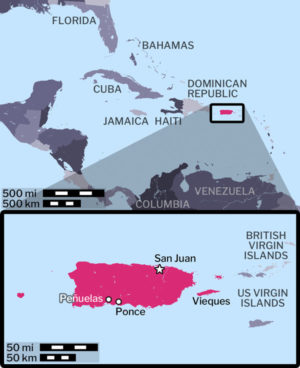 Oct 29: Utuado Uprising: Three Nationalists killed in shootout with police. Puerto Rico’s Insular Police in Peñuelas surround the home of Melitón Muñiz Santos’s mother, which they believe her son, who is president of the Peñuelas Nationalist Party, is using as a distribution center for an independence revolt. Police confiscate pistols, bombs and ammunition. Later that night, Muñiz Santos confronts the police at the house to try to take back the weapons. In the ensuing firefight, three Nationalists are killed and six are arrested, including Muñiz Santos. At least one Nationalist escapes and flees to Ponce.
Oct 29: Utuado Uprising: Three Nationalists killed in shootout with police. Puerto Rico’s Insular Police in Peñuelas surround the home of Melitón Muñiz Santos’s mother, which they believe her son, who is president of the Peñuelas Nationalist Party, is using as a distribution center for an independence revolt. Police confiscate pistols, bombs and ammunition. Later that night, Muñiz Santos confronts the police at the house to try to take back the weapons. In the ensuing firefight, three Nationalists are killed and six are arrested, including Muñiz Santos. At least one Nationalist escapes and flees to Ponce.
▲Monday, October 30
![]()
 Oct 30: American interrogators learn of an entire Chinese division at Chosin Reservoir. The day before, the U.S. 7th Marine Division landed unopposed at Iwon, which the ROK Capital Division had captured and passed through several days earlier, and is now following the ROK Capital Division toward Pungsan. At the same time, other elements of the Capital Division arrive at the south end of the Pujon Reservoir. At the Chosin (Changjin) Reservoir, where ROK troops fighting near a hydroelectric plant had captured sixteen Chinese soldiers the day before, U.S. military interrogators learn that an entire Chinese division supported by North Korean tanks are blocking the way north. The POWs also say that the Chinese division’s headquarters are at Hagaru-ri at the south end of the reservoir. U.N. commanders on the ground dispatch an urgent message with the latest information to Gen. Douglas MacArthur’s headquarters in Tokyo.
Oct 30: American interrogators learn of an entire Chinese division at Chosin Reservoir. The day before, the U.S. 7th Marine Division landed unopposed at Iwon, which the ROK Capital Division had captured and passed through several days earlier, and is now following the ROK Capital Division toward Pungsan. At the same time, other elements of the Capital Division arrive at the south end of the Pujon Reservoir. At the Chosin (Changjin) Reservoir, where ROK troops fighting near a hydroelectric plant had captured sixteen Chinese soldiers the day before, U.S. military interrogators learn that an entire Chinese division supported by North Korean tanks are blocking the way north. The POWs also say that the Chinese division’s headquarters are at Hagaru-ri at the south end of the reservoir. U.N. commanders on the ground dispatch an urgent message with the latest information to Gen. Douglas MacArthur’s headquarters in Tokyo.
![]() Oct 30: U.S. intelligence continues to play down Chinese intervention. In western North Korea, where reports of Chinese troops keep coming in, U.N. commanders on the ground are beginning to question intelligence officials who have been insisting that the captured Chinese prisoners represent reinforcements in the North Korean Army, and not full-fledged Chinese forces intervening from across the border. Intelligence reports continue to play down the the presence of Chinese troops, with one report saying “There are no indications at this time to confirm the existence of a CCF (Chinese Communist Force) organization or unit, of any size, on Korean soil.” But commanders are sufficiently concerned that they order the U.S. 1st Cavalry Division to move north from Pyongyang, where it had been assigned to security duties in the former North Korean capital. It is sent to reinforce the ROK 1st Division at Unsan, which is almost surrounded by Chinese forces.
Oct 30: U.S. intelligence continues to play down Chinese intervention. In western North Korea, where reports of Chinese troops keep coming in, U.N. commanders on the ground are beginning to question intelligence officials who have been insisting that the captured Chinese prisoners represent reinforcements in the North Korean Army, and not full-fledged Chinese forces intervening from across the border. Intelligence reports continue to play down the the presence of Chinese troops, with one report saying “There are no indications at this time to confirm the existence of a CCF (Chinese Communist Force) organization or unit, of any size, on Korean soil.” But commanders are sufficiently concerned that they order the U.S. 1st Cavalry Division to move north from Pyongyang, where it had been assigned to security duties in the former North Korean capital. It is sent to reinforce the ROK 1st Division at Unsan, which is almost surrounded by Chinese forces.
![]()
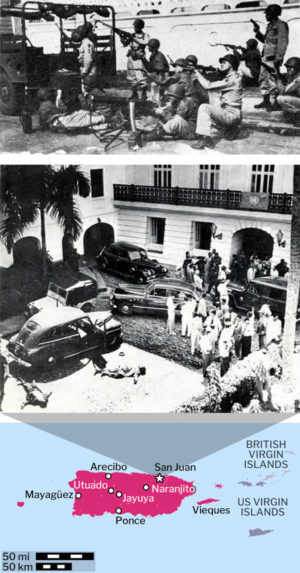 Oct 30: Utuado uprising: Independence movement operatives try to assassinate governor, attack half-dozen police stations. The Puerto Rican Nationalist uprising reaches its peak today as rebels in San Juan fire on the Court House and the Governor’s Palace in an apparent assassination attempt against Gov. Luís Muñoz Marín. Police are tipped off and thwart both attacks. One Nationalist is killed and four are captured at the Court House. Four of the five attackers at the Governor’s Palace are killed. Later, two more Nationalists are shot during a protest at the Court House. Meanwhile, police surround Pedro Albizu Campos’s home and Puerto Rico Nationalist Party headquarters. Albizu Campos refuses to surrender, and the two sides settle in for a long siege punctuated by an occasional exchange of gunfire. Elsewhere on the island, seven rebels descend on police headquarters in Arecibo at 10:30 a.m., killing four policemen in five minutes. One rebel is killed and the rest take off towards Utuado, but they’re intercepted by the National Guard and arrested. In Ponce, which had been the site of a 1937 massacre against peaceful protesters calling for independence, police pull over a car carrying five Nationalists who are trying to make their way to Utuado. In the ensuing firefight, one policeman is killed and the Nationalists make their escape on foot, but they are captured soon afterward. A separate group of Nationalists are detained after trying to attack the Ponce police station. In Naranjito, Nationalists led by a World War II veteran attack the police station. Afterward, they retreated into the mountains and formed a guerrilla group, launching several minor attacks over the next several days. In Mayagüez, forty nationalists try to launch attacks against the power utility, government buildings and police headquarters. But they don’t launch their attacks until 2:00 p.m., by which time the police are already on alert and thwart the attacks.
Oct 30: Utuado uprising: Independence movement operatives try to assassinate governor, attack half-dozen police stations. The Puerto Rican Nationalist uprising reaches its peak today as rebels in San Juan fire on the Court House and the Governor’s Palace in an apparent assassination attempt against Gov. Luís Muñoz Marín. Police are tipped off and thwart both attacks. One Nationalist is killed and four are captured at the Court House. Four of the five attackers at the Governor’s Palace are killed. Later, two more Nationalists are shot during a protest at the Court House. Meanwhile, police surround Pedro Albizu Campos’s home and Puerto Rico Nationalist Party headquarters. Albizu Campos refuses to surrender, and the two sides settle in for a long siege punctuated by an occasional exchange of gunfire. Elsewhere on the island, seven rebels descend on police headquarters in Arecibo at 10:30 a.m., killing four policemen in five minutes. One rebel is killed and the rest take off towards Utuado, but they’re intercepted by the National Guard and arrested. In Ponce, which had been the site of a 1937 massacre against peaceful protesters calling for independence, police pull over a car carrying five Nationalists who are trying to make their way to Utuado. In the ensuing firefight, one policeman is killed and the Nationalists make their escape on foot, but they are captured soon afterward. A separate group of Nationalists are detained after trying to attack the Ponce police station. In Naranjito, Nationalists led by a World War II veteran attack the police station. Afterward, they retreated into the mountains and formed a guerrilla group, launching several minor attacks over the next several days. In Mayagüez, forty nationalists try to launch attacks against the power utility, government buildings and police headquarters. But they don’t launch their attacks until 2:00 p.m., by which time the police are already on alert and thwart the attacks.
![]() Oct 30: Utuado Uprising: Blanca Canales leads dramatic revolt in Jayuya. One epicenter of the uprising is in Jayuya, where the revolt is led by Blanca Canales, the daughter of a wealthy landowner whose sympathies lie with the tenant farmers who typically side with the Nationalists. Canales has allowed the Nationalists to store weapons in her home. Canales and other leaders lead armed Nationalists into town and invade the police station. One policemen is killed, three are wounded, and the rest surrender. The Nationalists then go to the telephone exchange and cut the lines to the rest of the island. They then burn the U.S. Post Office and march to the town square. There, in defiance of the repressive Gag Law, they raise the banned flag of Puerto Rico off of a hotel balcony and declare Puerto Rico a free Republic. The other epicenter is a short distance away in Utuado, which is intend to be the uprising’s main base. Thirty-two Nationalists, working in two groups, go to Utuado’s post office and police station. The group at the post office sets it ablaze. But the other group is intercepted by police before they can reach the station. Following a brief firefight, most of the Nationalists disperse or surrender. But twelve fall back to the home of Damien Torres where they set up barricades. Elsewhere around the island, the uprising is mostly suppressed as the day comes to an end. Gov. Luís Muñoz Marín goes on the radio and condemns the “conspiracy against democracy helped by the Communists.” He appeals to listeners to “remain serene, since there is no danger that your democratic liberties will be harmed by these fanatics.” He also blames Saturday’s prison break on the Nationalists, even though his government and police have already acknowledged that the two events are unrelated.
Oct 30: Utuado Uprising: Blanca Canales leads dramatic revolt in Jayuya. One epicenter of the uprising is in Jayuya, where the revolt is led by Blanca Canales, the daughter of a wealthy landowner whose sympathies lie with the tenant farmers who typically side with the Nationalists. Canales has allowed the Nationalists to store weapons in her home. Canales and other leaders lead armed Nationalists into town and invade the police station. One policemen is killed, three are wounded, and the rest surrender. The Nationalists then go to the telephone exchange and cut the lines to the rest of the island. They then burn the U.S. Post Office and march to the town square. There, in defiance of the repressive Gag Law, they raise the banned flag of Puerto Rico off of a hotel balcony and declare Puerto Rico a free Republic. The other epicenter is a short distance away in Utuado, which is intend to be the uprising’s main base. Thirty-two Nationalists, working in two groups, go to Utuado’s post office and police station. The group at the post office sets it ablaze. But the other group is intercepted by police before they can reach the station. Following a brief firefight, most of the Nationalists disperse or surrender. But twelve fall back to the home of Damien Torres where they set up barricades. Elsewhere around the island, the uprising is mostly suppressed as the day comes to an end. Gov. Luís Muñoz Marín goes on the radio and condemns the “conspiracy against democracy helped by the Communists.” He appeals to listeners to “remain serene, since there is no danger that your democratic liberties will be harmed by these fanatics.” He also blames Saturday’s prison break on the Nationalists, even though his government and police have already acknowledged that the two events are unrelated.
▲Tuesday, October 31
Halloween
![]()
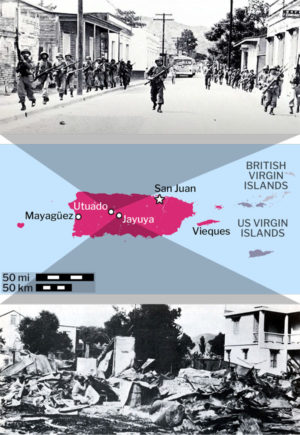 Oct 31: Utuado uprising: Puerto Rico police and National Guard bombard two town with planes, howitzers, mortars. The Puerto Rico National Guard and Insular Police launches attacks on two towns still held by members of the Nationalist Party fighting for the island’s independence. Violence had broke out throughout the island, but by yesterday it had been mostly suppressed everywhere except for the central mountain towns of Jayaya and Ultuado. At Jayuya, P-47 Thunderbolts drop 500-pound bombs and strafe the town with machine guns before the National Guard bombards it with mortars and howitzers. When National Guardsmen enter Jayaya, they find much of the town destroyed. The Associated Press says “Jayuya looked as if an earthquake had struck it, with several blocks destroyed and most of the other buildings in the town of 1,500 charred by fire.” In Utuando, where bombing and strafing by P-47s have caused extensive damage, the outrages aren’t yet over. National Guardsmen, which surrounded twelve Nationalists in a house the day before, demand their surrender. After another volley of gunfire which kills three Nationalists, the nine survivors surrender and are forced to march to the town’s plaza. There, they are ordered to remove their shoes, belts and personally belongings. They are then taken behind the police station and machine-gunned. One Nationalist, seventeen-year-old Antonio González, pleads for water while bleeding to death. “You want water?” asks the guardsman, who bayonets him instead. The corpses are left on display for seven hours. The worst of the violence is over, but scattered flareups continue in San Juan, where snipers again fire on the governor’s palace and the attorney general’s home, and in Mayagüez, were snipers fire on the police station.
Oct 31: Utuado uprising: Puerto Rico police and National Guard bombard two town with planes, howitzers, mortars. The Puerto Rico National Guard and Insular Police launches attacks on two towns still held by members of the Nationalist Party fighting for the island’s independence. Violence had broke out throughout the island, but by yesterday it had been mostly suppressed everywhere except for the central mountain towns of Jayaya and Ultuado. At Jayuya, P-47 Thunderbolts drop 500-pound bombs and strafe the town with machine guns before the National Guard bombards it with mortars and howitzers. When National Guardsmen enter Jayaya, they find much of the town destroyed. The Associated Press says “Jayuya looked as if an earthquake had struck it, with several blocks destroyed and most of the other buildings in the town of 1,500 charred by fire.” In Utuando, where bombing and strafing by P-47s have caused extensive damage, the outrages aren’t yet over. National Guardsmen, which surrounded twelve Nationalists in a house the day before, demand their surrender. After another volley of gunfire which kills three Nationalists, the nine survivors surrender and are forced to march to the town’s plaza. There, they are ordered to remove their shoes, belts and personally belongings. They are then taken behind the police station and machine-gunned. One Nationalist, seventeen-year-old Antonio González, pleads for water while bleeding to death. “You want water?” asks the guardsman, who bayonets him instead. The corpses are left on display for seven hours. The worst of the violence is over, but scattered flareups continue in San Juan, where snipers again fire on the governor’s palace and the attorney general’s home, and in Mayagüez, were snipers fire on the police station.
![]()
 Oct 31: Utuado uprising: three-hour gun battle destroy barbershop near Nationalist headquarters in San Juan. The Puerto Rico National Guard and Insular Police continues its siege of the Nationalist Party headquarters and home of Pedro Albizu Campos, the party’s leader. During the afternoon, twenty-five jeeps filled with National Guardsmen surround a nearby barbershop owned by Albizu Campos’s personal barber. The barber, Bidal Santiago Diaz, shoots the hat off of one policeman coming to arrest him. The National Guard opens fire with machine guns, sniper rifles and grenades. San Juan radio stations broadcast the three-hour gun battle that ends with a massive machine gun fusillade that destroys the shop. The barber is shot four times and a staircases collapse on top of him. A guardsman shoots him in the head as he lay unconscious on the floor. Miraculously, he survives, and will live for another thirty-two years. Meanwhile, Albizu Campos remains holed up in his home, refusing to surrender.
Oct 31: Utuado uprising: three-hour gun battle destroy barbershop near Nationalist headquarters in San Juan. The Puerto Rico National Guard and Insular Police continues its siege of the Nationalist Party headquarters and home of Pedro Albizu Campos, the party’s leader. During the afternoon, twenty-five jeeps filled with National Guardsmen surround a nearby barbershop owned by Albizu Campos’s personal barber. The barber, Bidal Santiago Diaz, shoots the hat off of one policeman coming to arrest him. The National Guard opens fire with machine guns, sniper rifles and grenades. San Juan radio stations broadcast the three-hour gun battle that ends with a massive machine gun fusillade that destroys the shop. The barber is shot four times and a staircases collapse on top of him. A guardsman shoots him in the head as he lay unconscious on the floor. Miraculously, he survives, and will live for another thirty-two years. Meanwhile, Albizu Campos remains holed up in his home, refusing to surrender.
![[Emphasis Mine]](http://jimburroway.com/wp-content/uploads/2018/01/McCarthyCohn.jpg)
